Warfare during world war 1 Stock Photos and Images
(3,494)See warfare during world war 1 stock video clipsQuick filters:
Warfare during world war 1 Stock Photos and Images
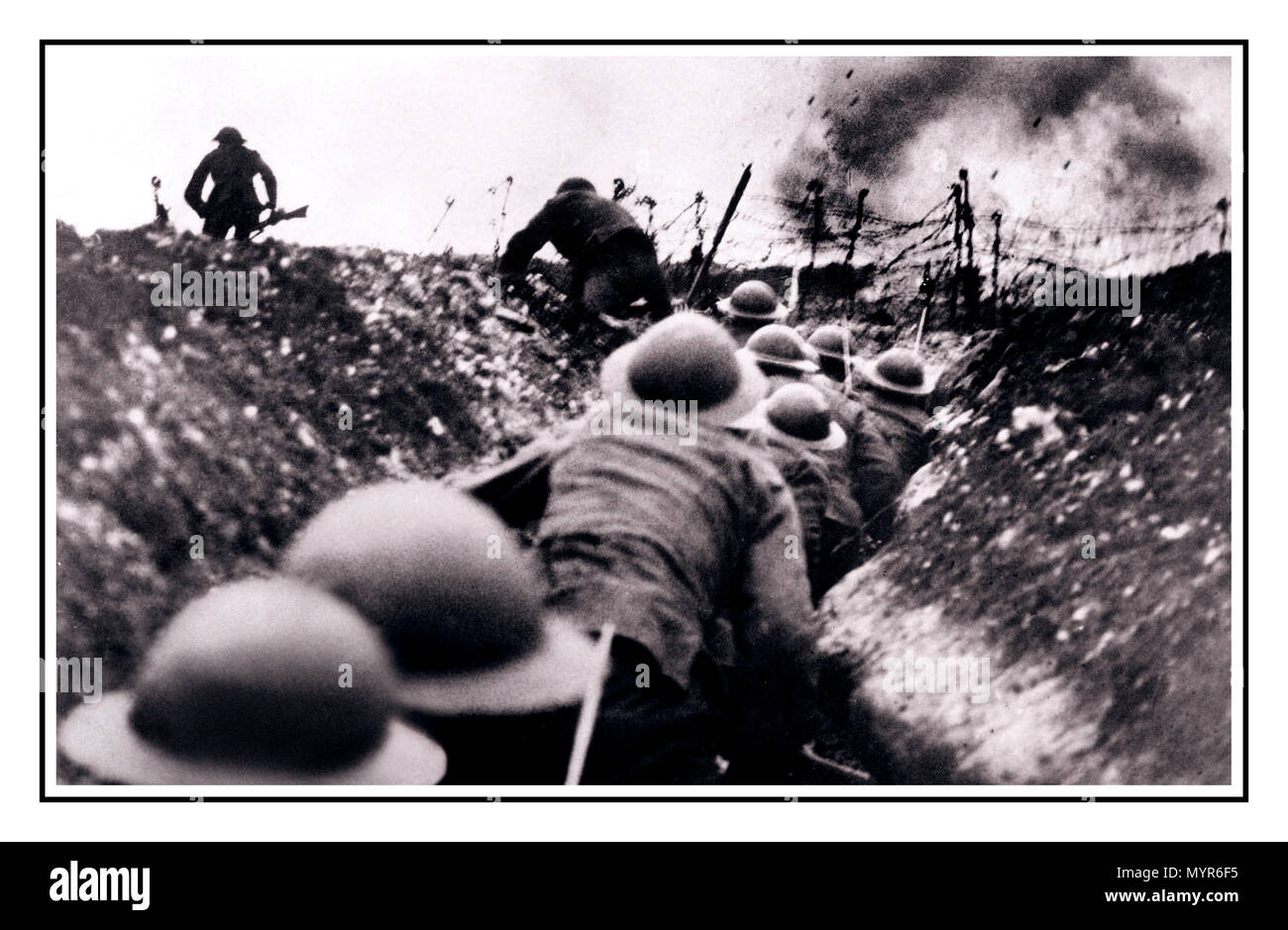 TRENCHES WW1 Over the top ‘Battle Of The Somme’ 1916 Stark grim powerful image of British troops in line ‘to go over the top’...of the trenches, under heavy German Empire Army fire during the Battle of the Somme. (Somme Offensive) Harrowing numbers of casualties were suffered on both sides... Western Front Pas de Calais France World War 1 First World War World War One 1916. This image has been carefully re-mastered to retain its original image detail impact... Stock Photohttps://www.alamy.com/image-license-details/?v=1https://www.alamy.com/trenches-ww1-over-the-top-battle-of-the-somme-1916-stark-grim-powerful-image-of-british-troops-in-line-to-go-over-the-topof-the-trenches-under-heavy-german-empire-army-fire-during-the-battle-of-the-somme-somme-offensive-harrowing-numbers-of-casualties-were-suffered-on-both-sides-western-front-pas-de-calais-france-world-war-1-first-world-war-world-war-one-1916-this-image-has-been-carefully-re-mastered-to-retain-its-original-image-detail-impact-image189209417.html
TRENCHES WW1 Over the top ‘Battle Of The Somme’ 1916 Stark grim powerful image of British troops in line ‘to go over the top’...of the trenches, under heavy German Empire Army fire during the Battle of the Somme. (Somme Offensive) Harrowing numbers of casualties were suffered on both sides... Western Front Pas de Calais France World War 1 First World War World War One 1916. This image has been carefully re-mastered to retain its original image detail impact... Stock Photohttps://www.alamy.com/image-license-details/?v=1https://www.alamy.com/trenches-ww1-over-the-top-battle-of-the-somme-1916-stark-grim-powerful-image-of-british-troops-in-line-to-go-over-the-topof-the-trenches-under-heavy-german-empire-army-fire-during-the-battle-of-the-somme-somme-offensive-harrowing-numbers-of-casualties-were-suffered-on-both-sides-western-front-pas-de-calais-france-world-war-1-first-world-war-world-war-one-1916-this-image-has-been-carefully-re-mastered-to-retain-its-original-image-detail-impact-image189209417.htmlRMMYR6F5–TRENCHES WW1 Over the top ‘Battle Of The Somme’ 1916 Stark grim powerful image of British troops in line ‘to go over the top’...of the trenches, under heavy German Empire Army fire during the Battle of the Somme. (Somme Offensive) Harrowing numbers of casualties were suffered on both sides... Western Front Pas de Calais France World War 1 First World War World War One 1916. This image has been carefully re-mastered to retain its original image detail impact...
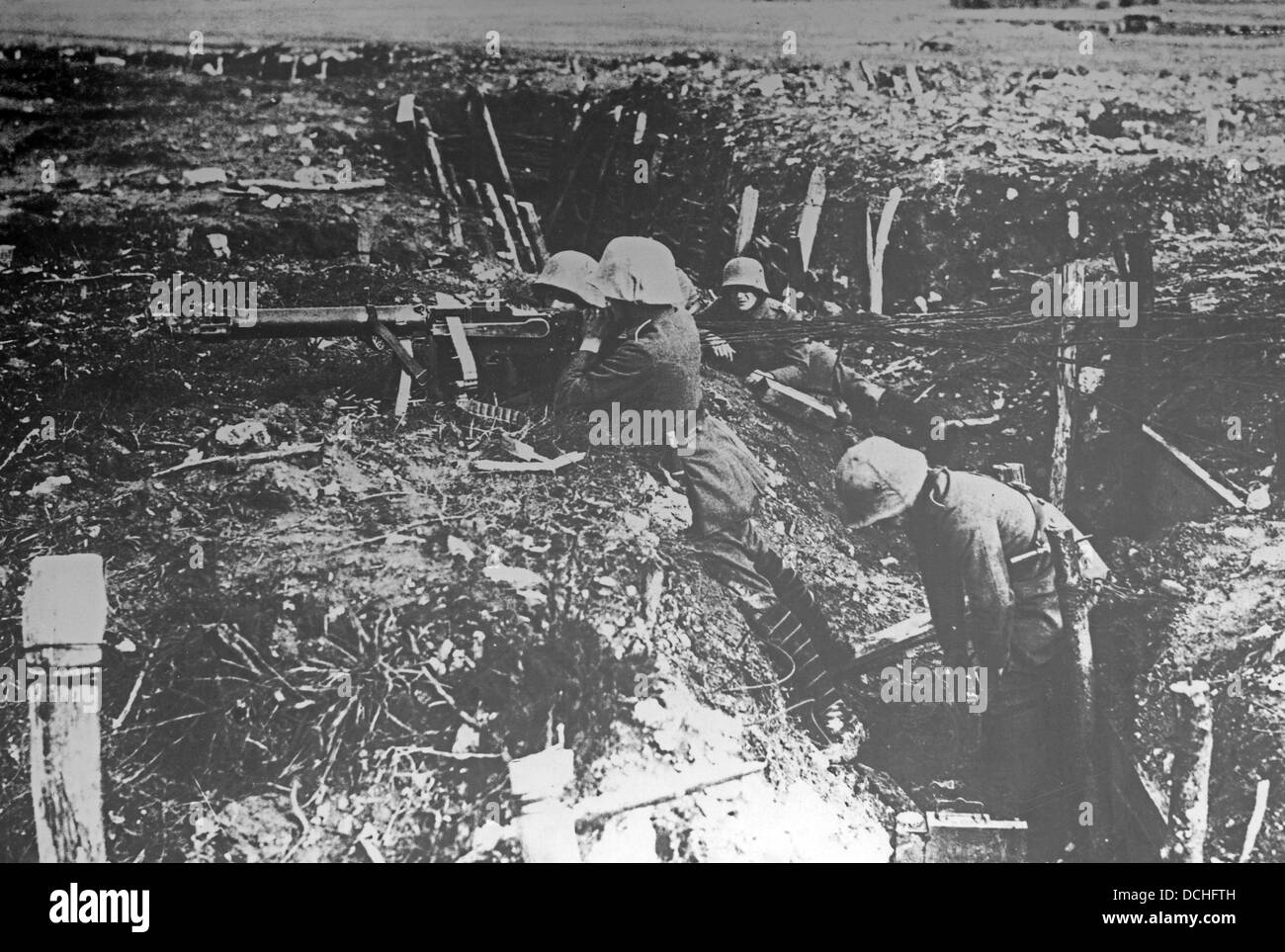 Trench warfare during First World War Stock Photohttps://www.alamy.com/image-license-details/?v=1https://www.alamy.com/stock-photo-trench-warfare-during-first-world-war-59392609.html
Trench warfare during First World War Stock Photohttps://www.alamy.com/image-license-details/?v=1https://www.alamy.com/stock-photo-trench-warfare-during-first-world-war-59392609.htmlRMDCHFTH–Trench warfare during First World War
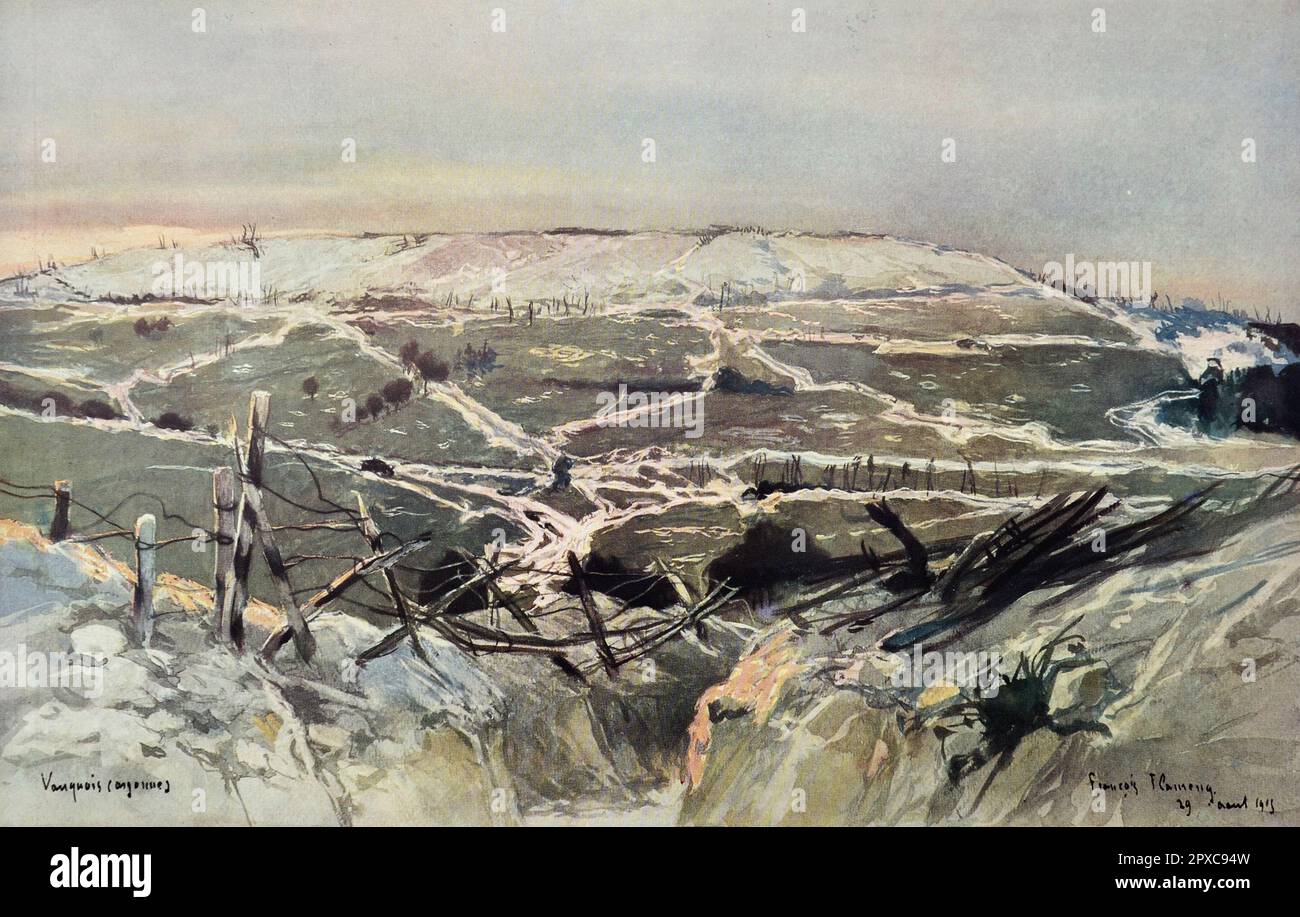 Wolrd War I. Vauquois. By François Flameng Vauquois is a commune in the Meuse department in Grand Est in north-eastern France. During World War 1, Vauquois was the site of violent mine warfare, also in connection with the Battle of Verdun (1916). From 1915 to 1918, French and German tunneling units fired 519 separate mines at Vauquois, and the German gallery network beneath the village hill (the Butte de Vauquois) grew to a length of 17 kilometres (11 mi). Vauquois was destroyed and many huge craters and dugouts remain. Stock Photohttps://www.alamy.com/image-license-details/?v=1https://www.alamy.com/wolrd-war-i-vauquois-by-franois-flameng-vauquois-is-a-commune-in-the-meuse-department-in-grand-est-in-north-eastern-france-during-world-war-1-vauquois-was-the-site-of-violent-mine-warfare-also-in-connection-with-the-battle-of-verdun-1916-from-1915-to-1918-french-and-german-tunneling-units-fired-519-separate-mines-at-vauquois-and-the-german-gallery-network-beneath-the-village-hill-the-butte-de-vauquois-grew-to-a-length-of-17-kilometres-11-mi-vauquois-was-destroyed-and-many-huge-craters-and-dugouts-remain-image549773081.html
Wolrd War I. Vauquois. By François Flameng Vauquois is a commune in the Meuse department in Grand Est in north-eastern France. During World War 1, Vauquois was the site of violent mine warfare, also in connection with the Battle of Verdun (1916). From 1915 to 1918, French and German tunneling units fired 519 separate mines at Vauquois, and the German gallery network beneath the village hill (the Butte de Vauquois) grew to a length of 17 kilometres (11 mi). Vauquois was destroyed and many huge craters and dugouts remain. Stock Photohttps://www.alamy.com/image-license-details/?v=1https://www.alamy.com/wolrd-war-i-vauquois-by-franois-flameng-vauquois-is-a-commune-in-the-meuse-department-in-grand-est-in-north-eastern-france-during-world-war-1-vauquois-was-the-site-of-violent-mine-warfare-also-in-connection-with-the-battle-of-verdun-1916-from-1915-to-1918-french-and-german-tunneling-units-fired-519-separate-mines-at-vauquois-and-the-german-gallery-network-beneath-the-village-hill-the-butte-de-vauquois-grew-to-a-length-of-17-kilometres-11-mi-vauquois-was-destroyed-and-many-huge-craters-and-dugouts-remain-image549773081.htmlRM2PXC94W–Wolrd War I. Vauquois. By François Flameng Vauquois is a commune in the Meuse department in Grand Est in north-eastern France. During World War 1, Vauquois was the site of violent mine warfare, also in connection with the Battle of Verdun (1916). From 1915 to 1918, French and German tunneling units fired 519 separate mines at Vauquois, and the German gallery network beneath the village hill (the Butte de Vauquois) grew to a length of 17 kilometres (11 mi). Vauquois was destroyed and many huge craters and dugouts remain.
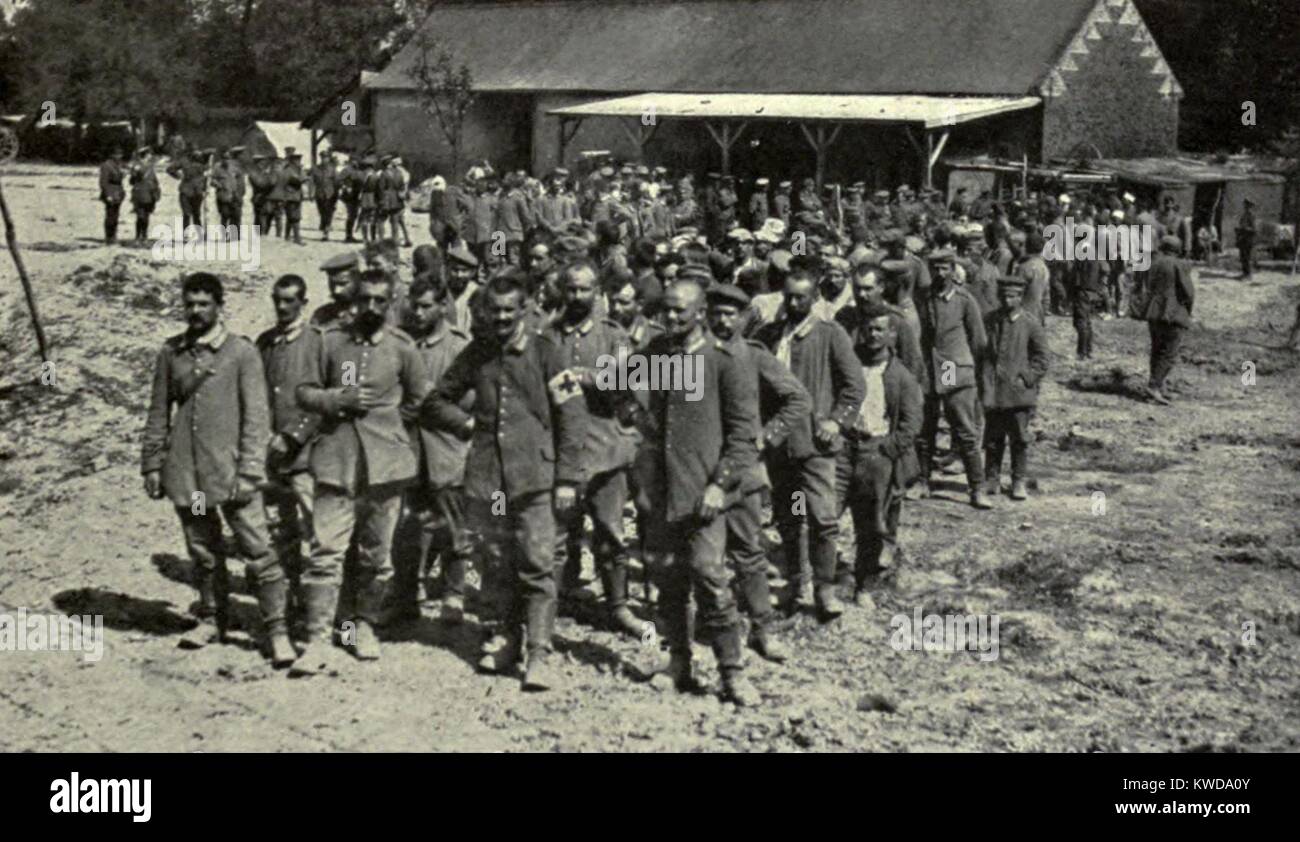 World War 1. Somme Offensive. German prisoners captured by the British during the Somme Offensive, at Meaulte, near Albert. July 1916. (BSLOC 2013 1 118) Stock Photohttps://www.alamy.com/image-license-details/?v=1https://www.alamy.com/stock-photo-world-war-1-somme-offensive-german-prisoners-captured-by-the-british-170552955.html
World War 1. Somme Offensive. German prisoners captured by the British during the Somme Offensive, at Meaulte, near Albert. July 1916. (BSLOC 2013 1 118) Stock Photohttps://www.alamy.com/image-license-details/?v=1https://www.alamy.com/stock-photo-world-war-1-somme-offensive-german-prisoners-captured-by-the-british-170552955.htmlRMKWDA0Y–World War 1. Somme Offensive. German prisoners captured by the British during the Somme Offensive, at Meaulte, near Albert. July 1916. (BSLOC 2013 1 118)
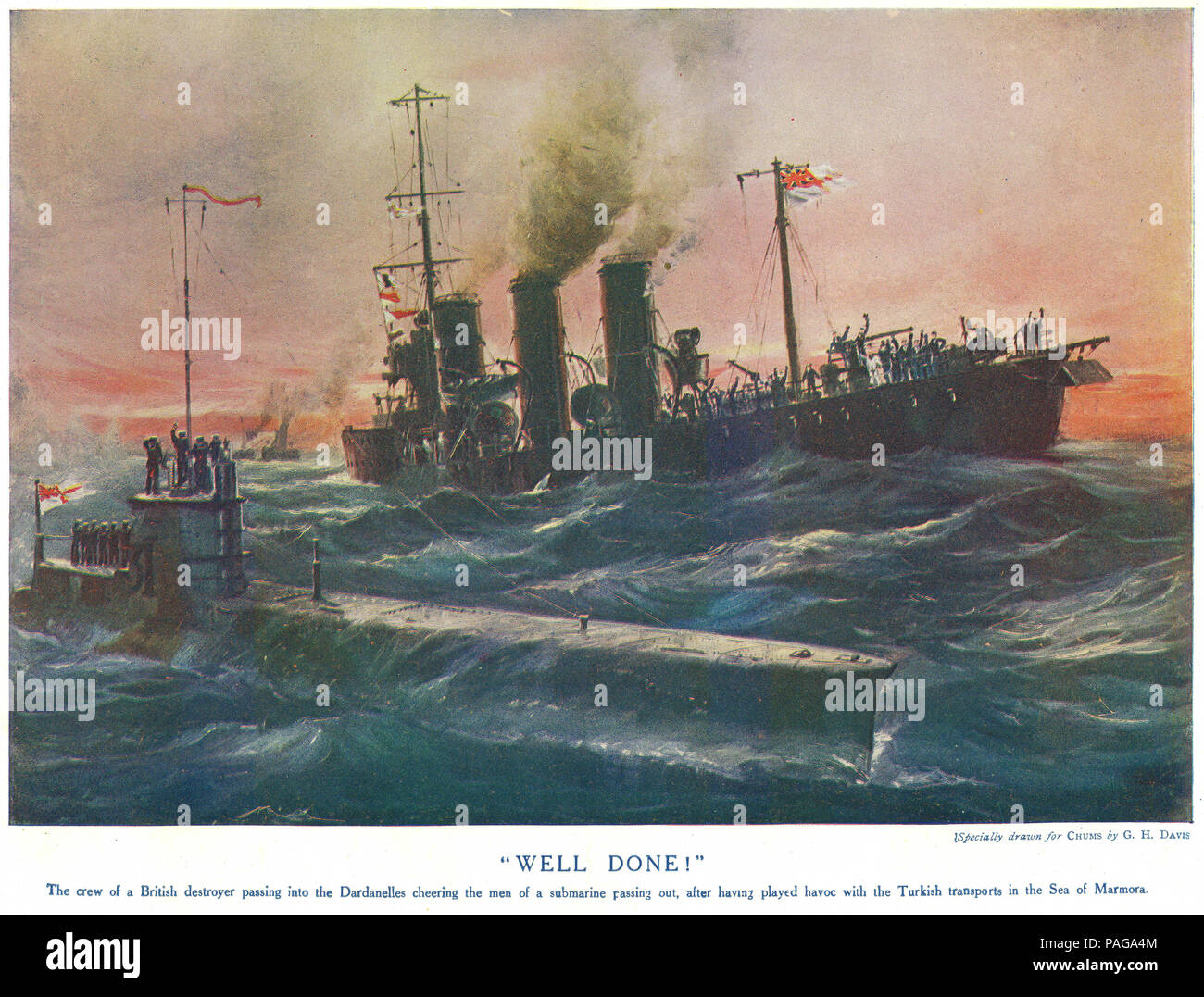 Halftone of the crew of a British destroyer greeting the crew of a submarine near the Dardanelles during World War One. From Chums, an adventure magazine for boys, 1916 Stock Photohttps://www.alamy.com/image-license-details/?v=1https://www.alamy.com/halftone-of-the-crew-of-a-british-destroyer-greeting-the-crew-of-a-submarine-near-the-dardanelles-during-world-war-one-from-chums-an-adventure-magazine-for-boys-1916-image213030180.html
Halftone of the crew of a British destroyer greeting the crew of a submarine near the Dardanelles during World War One. From Chums, an adventure magazine for boys, 1916 Stock Photohttps://www.alamy.com/image-license-details/?v=1https://www.alamy.com/halftone-of-the-crew-of-a-british-destroyer-greeting-the-crew-of-a-submarine-near-the-dardanelles-during-world-war-one-from-chums-an-adventure-magazine-for-boys-1916-image213030180.htmlRMPAGA4M–Halftone of the crew of a British destroyer greeting the crew of a submarine near the Dardanelles during World War One. From Chums, an adventure magazine for boys, 1916
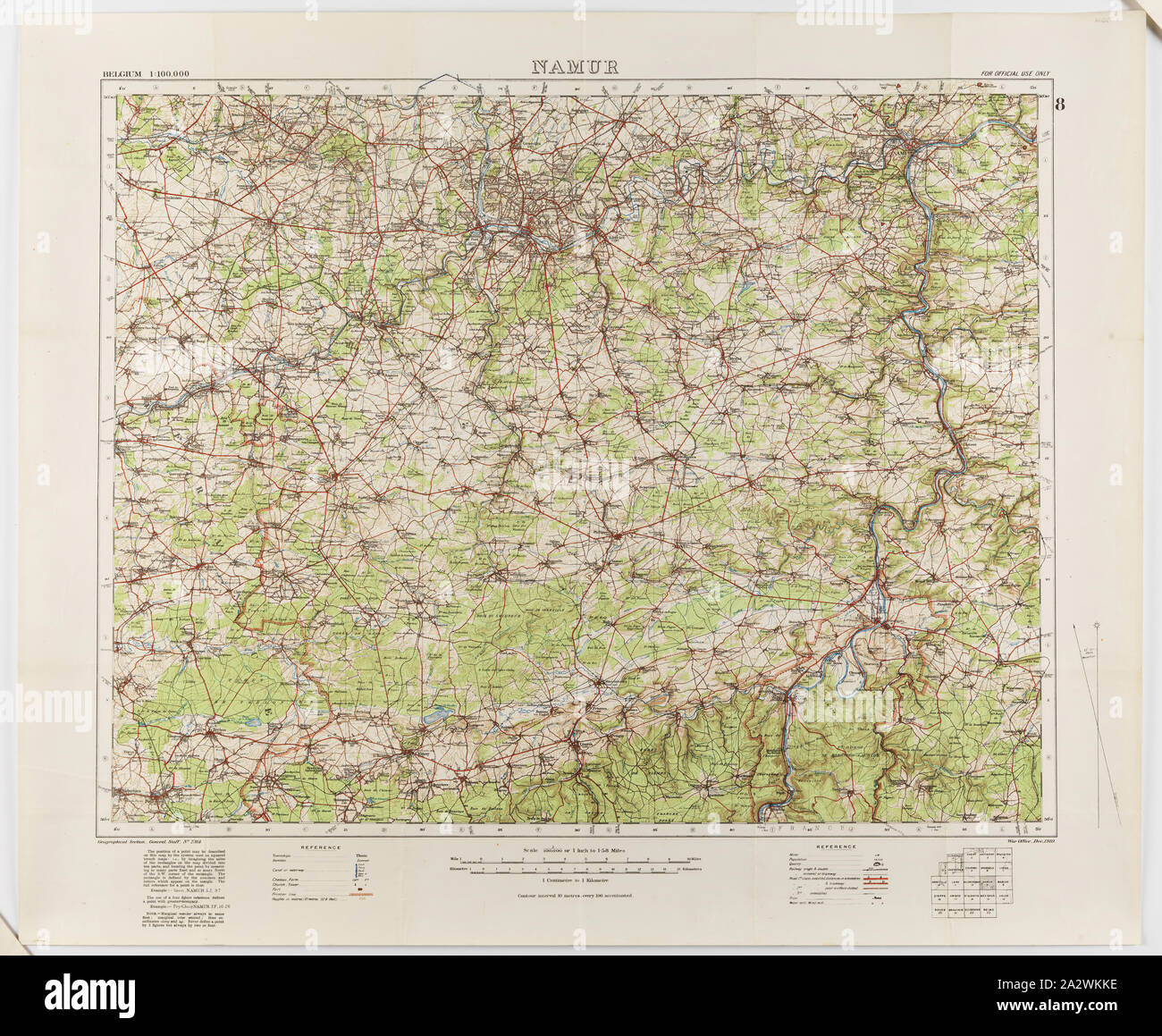 Map - Military, Belgium, Namur 8, General Staff no. 2364, Scale 1:100,000, World War I, 1910, Military map of Belgium, Namur area (a hand-written inscription identifies it as Namur 8 district), scale 1:100,000, published in 1910. The map is labelled General Staff No. 2364. It would have been used during World War I. Maps of this scale lacked the detail needed for trench warfare, instead providing an overview of regions for the use of senior commanders. Part of the collection of World Stock Photohttps://www.alamy.com/image-license-details/?v=1https://www.alamy.com/map-military-belgium-namur-8-general-staff-no-2364-scale-1100000-world-war-i-1910-military-map-of-belgium-namur-area-a-hand-written-inscription-identifies-it-as-namur-8-district-scale-1100000-published-in-1910-the-map-is-labelled-general-staff-no-2364-it-would-have-been-used-during-world-war-i-maps-of-this-scale-lacked-the-detail-needed-for-trench-warfare-instead-providing-an-overview-of-regions-for-the-use-of-senior-commanders-part-of-the-collection-of-world-image328790546.html
Map - Military, Belgium, Namur 8, General Staff no. 2364, Scale 1:100,000, World War I, 1910, Military map of Belgium, Namur area (a hand-written inscription identifies it as Namur 8 district), scale 1:100,000, published in 1910. The map is labelled General Staff No. 2364. It would have been used during World War I. Maps of this scale lacked the detail needed for trench warfare, instead providing an overview of regions for the use of senior commanders. Part of the collection of World Stock Photohttps://www.alamy.com/image-license-details/?v=1https://www.alamy.com/map-military-belgium-namur-8-general-staff-no-2364-scale-1100000-world-war-i-1910-military-map-of-belgium-namur-area-a-hand-written-inscription-identifies-it-as-namur-8-district-scale-1100000-published-in-1910-the-map-is-labelled-general-staff-no-2364-it-would-have-been-used-during-world-war-i-maps-of-this-scale-lacked-the-detail-needed-for-trench-warfare-instead-providing-an-overview-of-regions-for-the-use-of-senior-commanders-part-of-the-collection-of-world-image328790546.htmlRM2A2WKKE–Map - Military, Belgium, Namur 8, General Staff no. 2364, Scale 1:100,000, World War I, 1910, Military map of Belgium, Namur area (a hand-written inscription identifies it as Namur 8 district), scale 1:100,000, published in 1910. The map is labelled General Staff No. 2364. It would have been used during World War I. Maps of this scale lacked the detail needed for trench warfare, instead providing an overview of regions for the use of senior commanders. Part of the collection of World
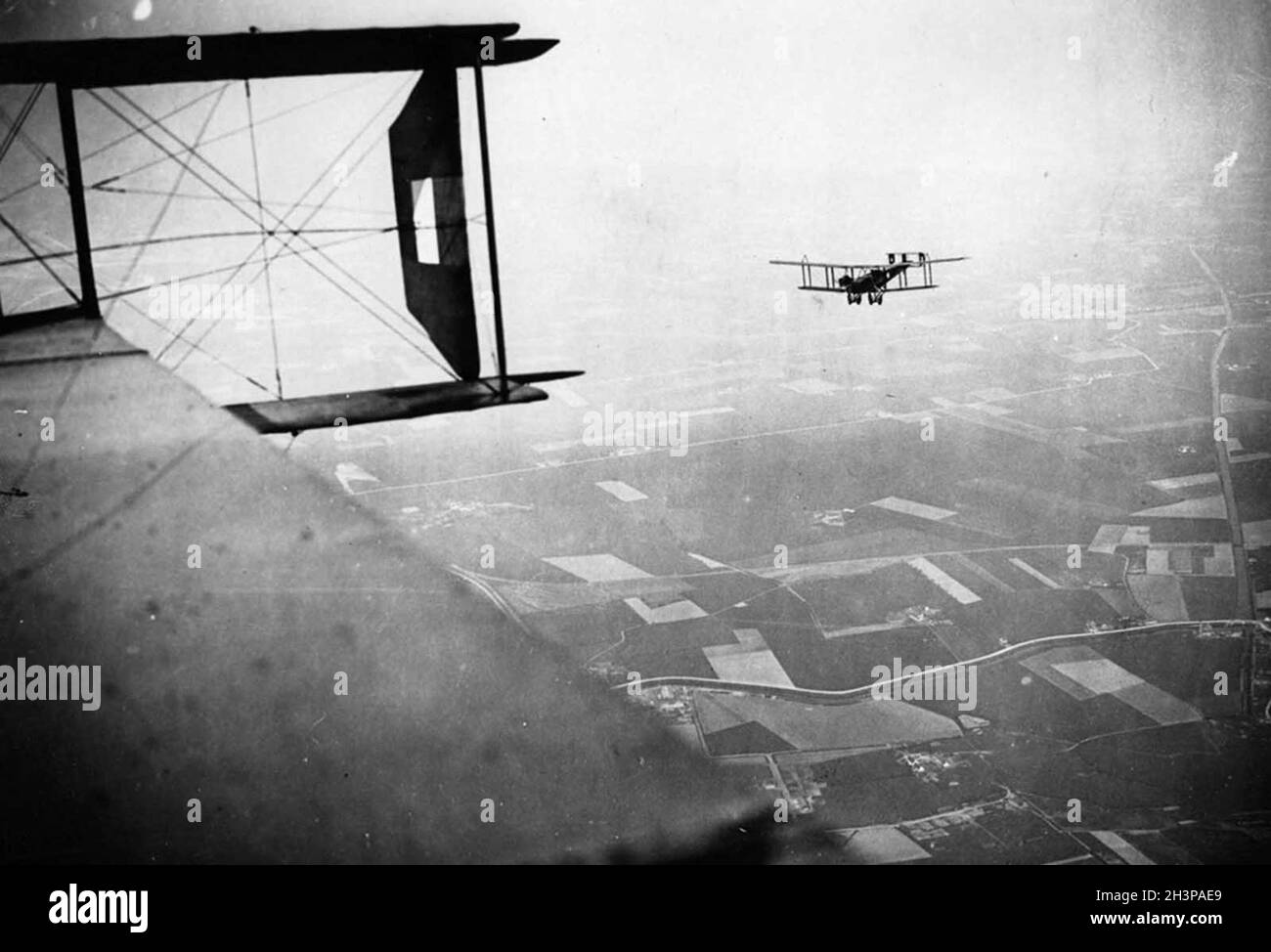 British Handley-Page bombers on a mission, Western Front, during World War I. Stock Photohttps://www.alamy.com/image-license-details/?v=1https://www.alamy.com/british-handley-page-bombers-on-a-mission-western-front-during-world-war-i-image449804721.html
British Handley-Page bombers on a mission, Western Front, during World War I. Stock Photohttps://www.alamy.com/image-license-details/?v=1https://www.alamy.com/british-handley-page-bombers-on-a-mission-western-front-during-world-war-i-image449804721.htmlRM2H3PAE9–British Handley-Page bombers on a mission, Western Front, during World War I.
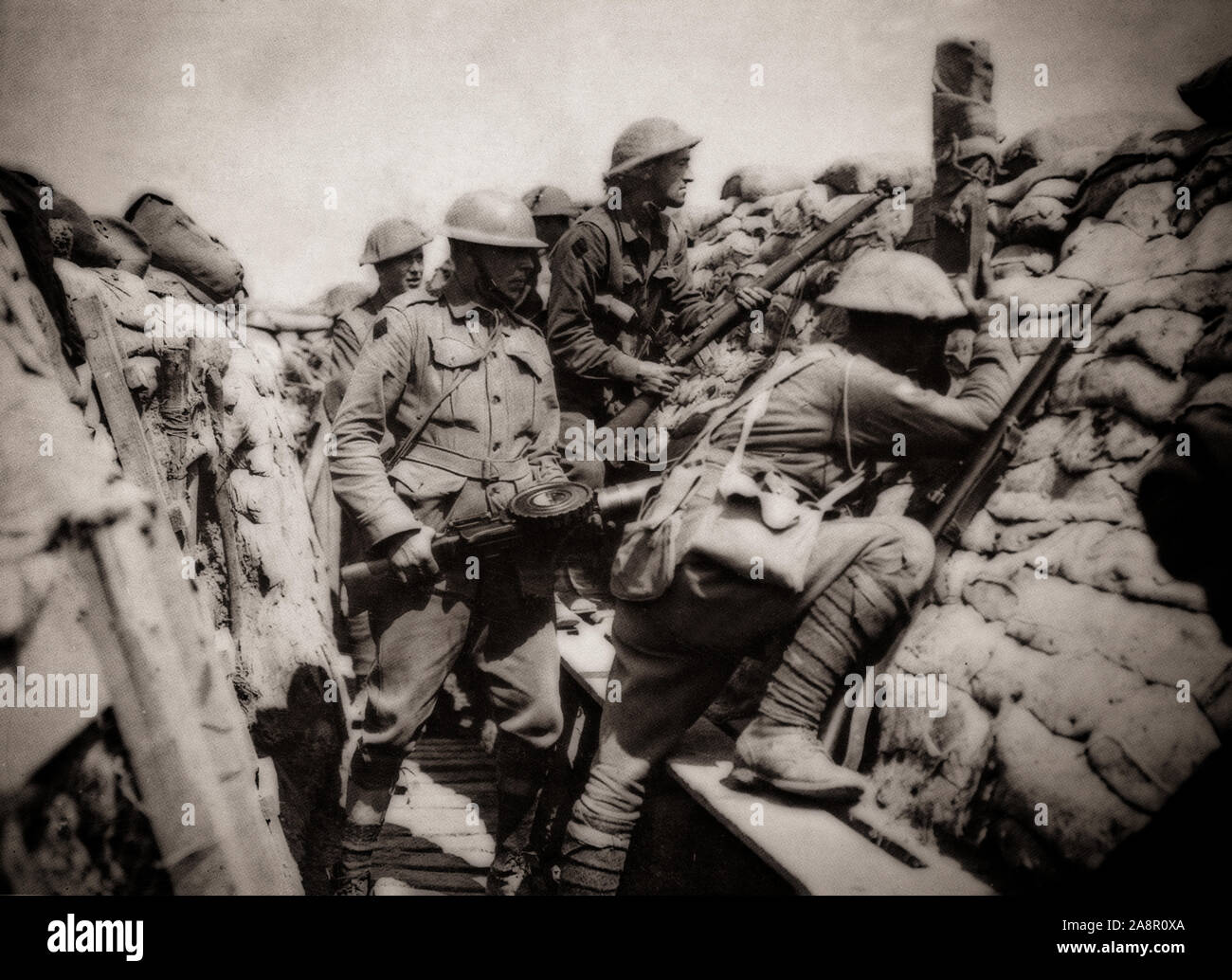 Soldiers of the 2nd Australian Division in the trenches during World War One. They were were initially sent to the region of the Belgian border to gain familiarity with some of the new weapons of modern warfare, including gas. They then moved into the front-line trenches near Armentières in the Nord department in the Hauts-de-France region in northern France. It was an area known as “the nursery” and although it was a relatively quiet sector, there were periods of sharp fighting, shelling, and some heavy raids; by the end of June over 600 men had been killed. Stock Photohttps://www.alamy.com/image-license-details/?v=1https://www.alamy.com/soldiers-of-the-2nd-australian-division-in-the-trenches-during-world-war-one-they-were-were-initially-sent-to-the-region-of-the-belgian-border-to-gain-familiarity-with-some-of-the-new-weapons-of-modern-warfare-including-gas-they-then-moved-into-the-front-line-trenches-near-armentires-in-the-nord-department-in-the-hauts-de-france-region-in-northern-france-it-was-an-area-known-as-the-nursery-and-although-it-was-a-relatively-quiet-sector-there-were-periods-of-sharp-fighting-shelling-and-some-heavy-raids-by-the-end-of-june-over-600-men-had-been-killed-image332419874.html
Soldiers of the 2nd Australian Division in the trenches during World War One. They were were initially sent to the region of the Belgian border to gain familiarity with some of the new weapons of modern warfare, including gas. They then moved into the front-line trenches near Armentières in the Nord department in the Hauts-de-France region in northern France. It was an area known as “the nursery” and although it was a relatively quiet sector, there were periods of sharp fighting, shelling, and some heavy raids; by the end of June over 600 men had been killed. Stock Photohttps://www.alamy.com/image-license-details/?v=1https://www.alamy.com/soldiers-of-the-2nd-australian-division-in-the-trenches-during-world-war-one-they-were-were-initially-sent-to-the-region-of-the-belgian-border-to-gain-familiarity-with-some-of-the-new-weapons-of-modern-warfare-including-gas-they-then-moved-into-the-front-line-trenches-near-armentires-in-the-nord-department-in-the-hauts-de-france-region-in-northern-france-it-was-an-area-known-as-the-nursery-and-although-it-was-a-relatively-quiet-sector-there-were-periods-of-sharp-fighting-shelling-and-some-heavy-raids-by-the-end-of-june-over-600-men-had-been-killed-image332419874.htmlRM2A8R0XA–Soldiers of the 2nd Australian Division in the trenches during World War One. They were were initially sent to the region of the Belgian border to gain familiarity with some of the new weapons of modern warfare, including gas. They then moved into the front-line trenches near Armentières in the Nord department in the Hauts-de-France region in northern France. It was an area known as “the nursery” and although it was a relatively quiet sector, there were periods of sharp fighting, shelling, and some heavy raids; by the end of June over 600 men had been killed.
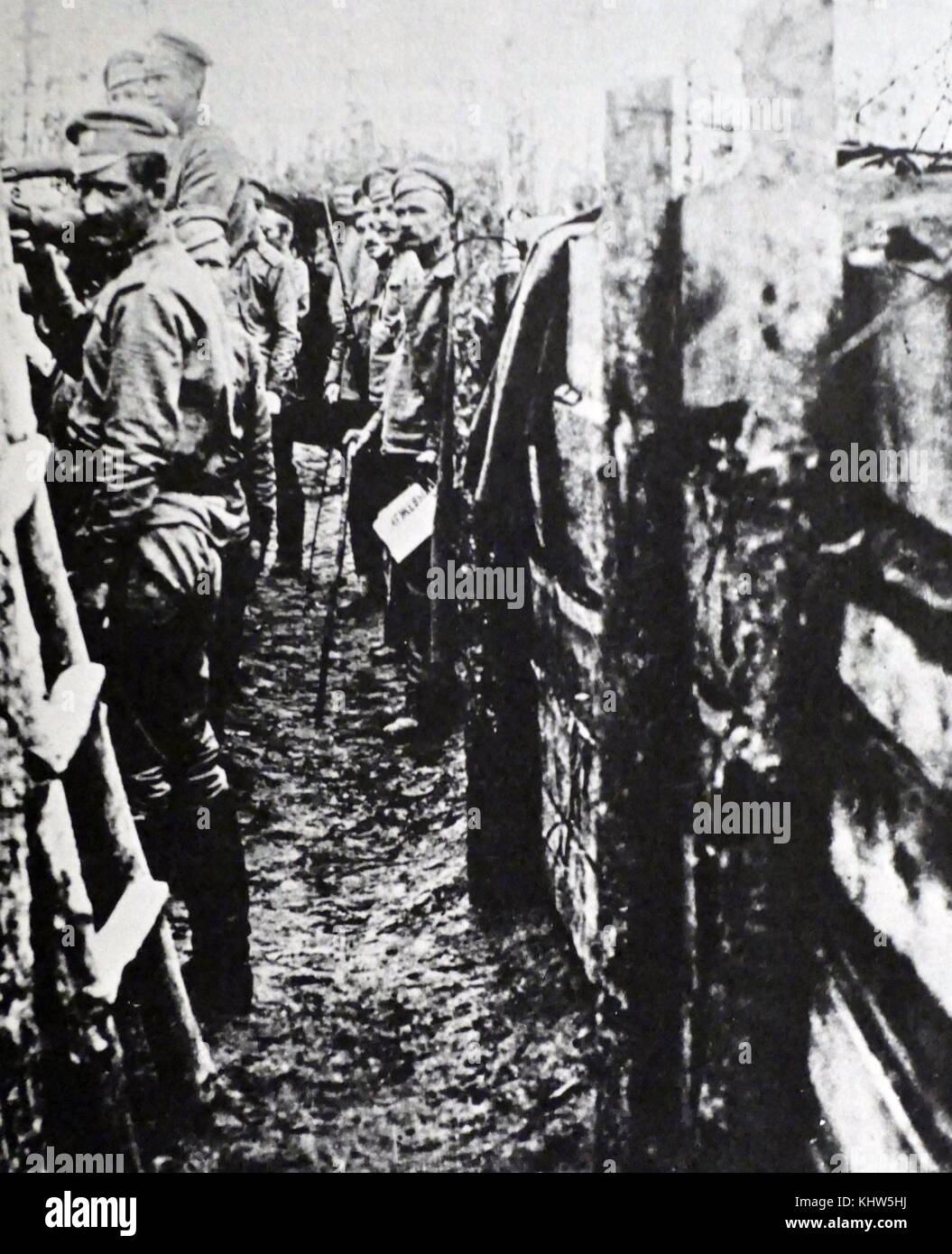 Photograph of Russian soldiers in the trenches during the First World War. Dated 20th Century Stock Photohttps://www.alamy.com/image-license-details/?v=1https://www.alamy.com/stock-image-photograph-of-russian-soldiers-in-the-trenches-during-the-first-world-165895678.html
Photograph of Russian soldiers in the trenches during the First World War. Dated 20th Century Stock Photohttps://www.alamy.com/image-license-details/?v=1https://www.alamy.com/stock-image-photograph-of-russian-soldiers-in-the-trenches-during-the-first-world-165895678.htmlRMKHW5HJ–Photograph of Russian soldiers in the trenches during the First World War. Dated 20th Century
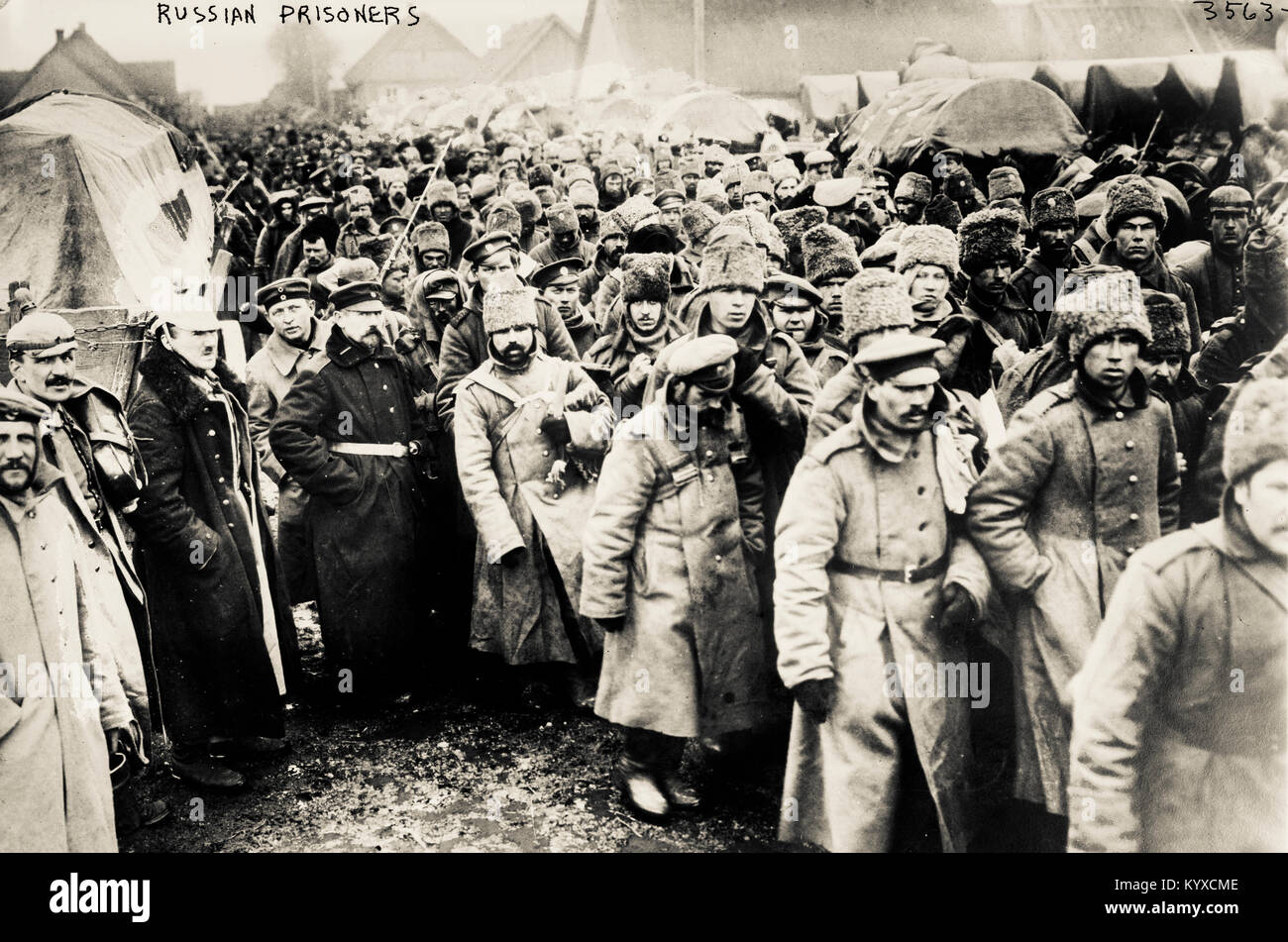 Russian prisoners held during World War One Stock Photohttps://www.alamy.com/image-license-details/?v=1https://www.alamy.com/stock-photo-russian-prisoners-held-during-world-war-one-172069758.html
Russian prisoners held during World War One Stock Photohttps://www.alamy.com/image-license-details/?v=1https://www.alamy.com/stock-photo-russian-prisoners-held-during-world-war-one-172069758.htmlRFKYXCME–Russian prisoners held during World War One
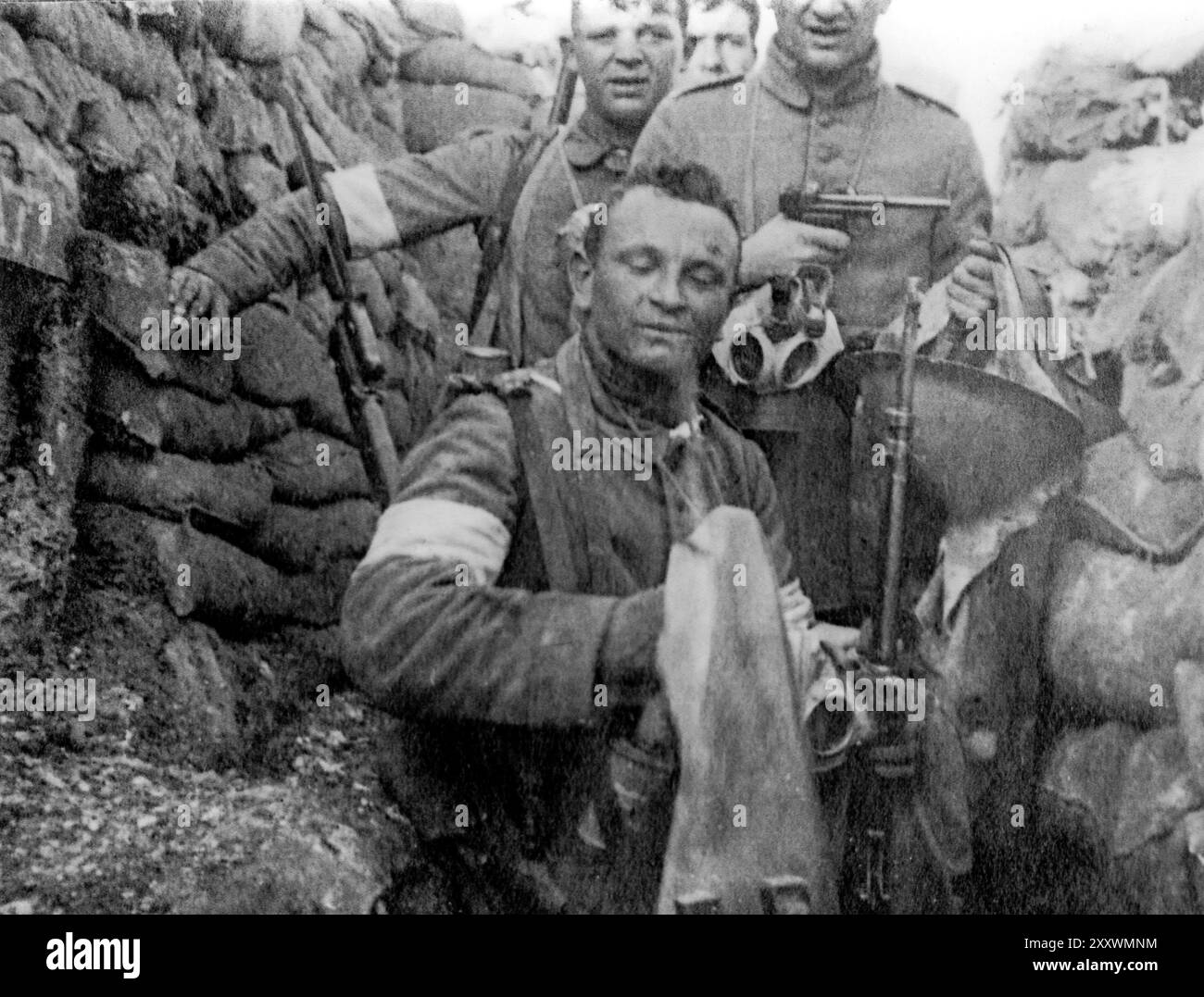 German WWI raiders with white armbands for recognition during hand-to-hand combat in trench warfare, armed with pistols during World War One, Flanders Stock Photohttps://www.alamy.com/image-license-details/?v=1https://www.alamy.com/german-wwi-raiders-with-white-armbands-for-recognition-during-hand-to-hand-combat-in-trench-warfare-armed-with-pistols-during-world-war-one-flanders-image618909024.html
German WWI raiders with white armbands for recognition during hand-to-hand combat in trench warfare, armed with pistols during World War One, Flanders Stock Photohttps://www.alamy.com/image-license-details/?v=1https://www.alamy.com/german-wwi-raiders-with-white-armbands-for-recognition-during-hand-to-hand-combat-in-trench-warfare-armed-with-pistols-during-world-war-one-flanders-image618909024.htmlRM2XXWMNM–German WWI raiders with white armbands for recognition during hand-to-hand combat in trench warfare, armed with pistols during World War One, Flanders
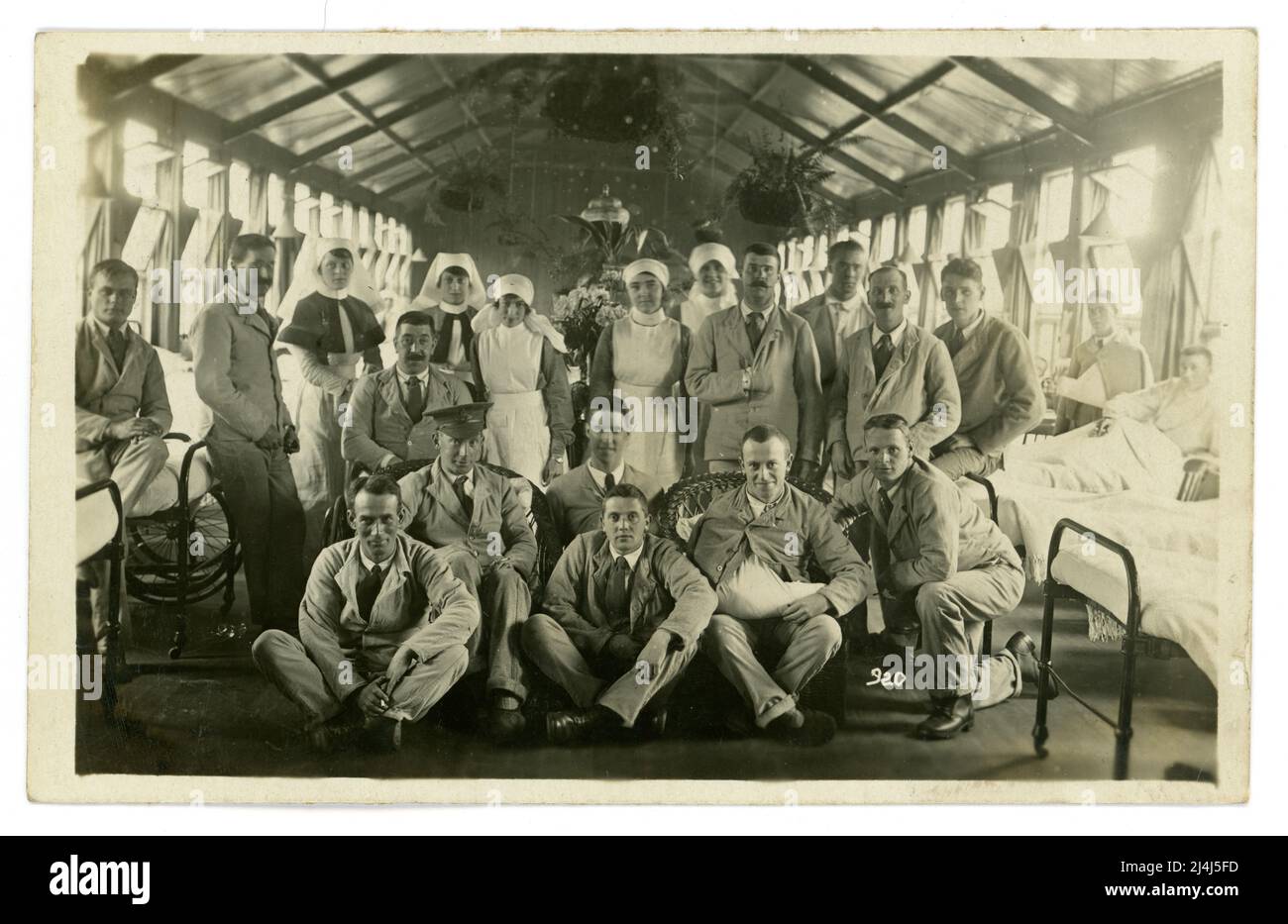 Original WW1 era postcard of wounded men and nursing staff at 2nd Northern General Hospital Leeds (known as Beckett's Park Hospital, Headingley) - a Territorial Forces hospital during World War 1. The patients are looking cheerful. The card was posted by a nurse who was caring for these wounded men 11 July 1917 , U.K. Stock Photohttps://www.alamy.com/image-license-details/?v=1https://www.alamy.com/original-ww1-era-postcard-of-wounded-men-and-nursing-staff-at-2nd-northern-general-hospital-leeds-known-as-becketts-park-hospital-headingley-a-territorial-forces-hospital-during-world-war-1-the-patients-are-looking-cheerful-the-card-was-posted-by-a-nurse-who-was-caring-for-these-wounded-men-11-july-1917-uk-image467538049.html
Original WW1 era postcard of wounded men and nursing staff at 2nd Northern General Hospital Leeds (known as Beckett's Park Hospital, Headingley) - a Territorial Forces hospital during World War 1. The patients are looking cheerful. The card was posted by a nurse who was caring for these wounded men 11 July 1917 , U.K. Stock Photohttps://www.alamy.com/image-license-details/?v=1https://www.alamy.com/original-ww1-era-postcard-of-wounded-men-and-nursing-staff-at-2nd-northern-general-hospital-leeds-known-as-becketts-park-hospital-headingley-a-territorial-forces-hospital-during-world-war-1-the-patients-are-looking-cheerful-the-card-was-posted-by-a-nurse-who-was-caring-for-these-wounded-men-11-july-1917-uk-image467538049.htmlRM2J4J5FD–Original WW1 era postcard of wounded men and nursing staff at 2nd Northern General Hospital Leeds (known as Beckett's Park Hospital, Headingley) - a Territorial Forces hospital during World War 1. The patients are looking cheerful. The card was posted by a nurse who was caring for these wounded men 11 July 1917 , U.K.
 Over the top - trench warfare during WW1 Stock Photohttps://www.alamy.com/image-license-details/?v=1https://www.alamy.com/over-the-top-trench-warfare-during-ww1-image60695882.html
Over the top - trench warfare during WW1 Stock Photohttps://www.alamy.com/image-license-details/?v=1https://www.alamy.com/over-the-top-trench-warfare-during-ww1-image60695882.htmlRFDEMX62–Over the top - trench warfare during WW1
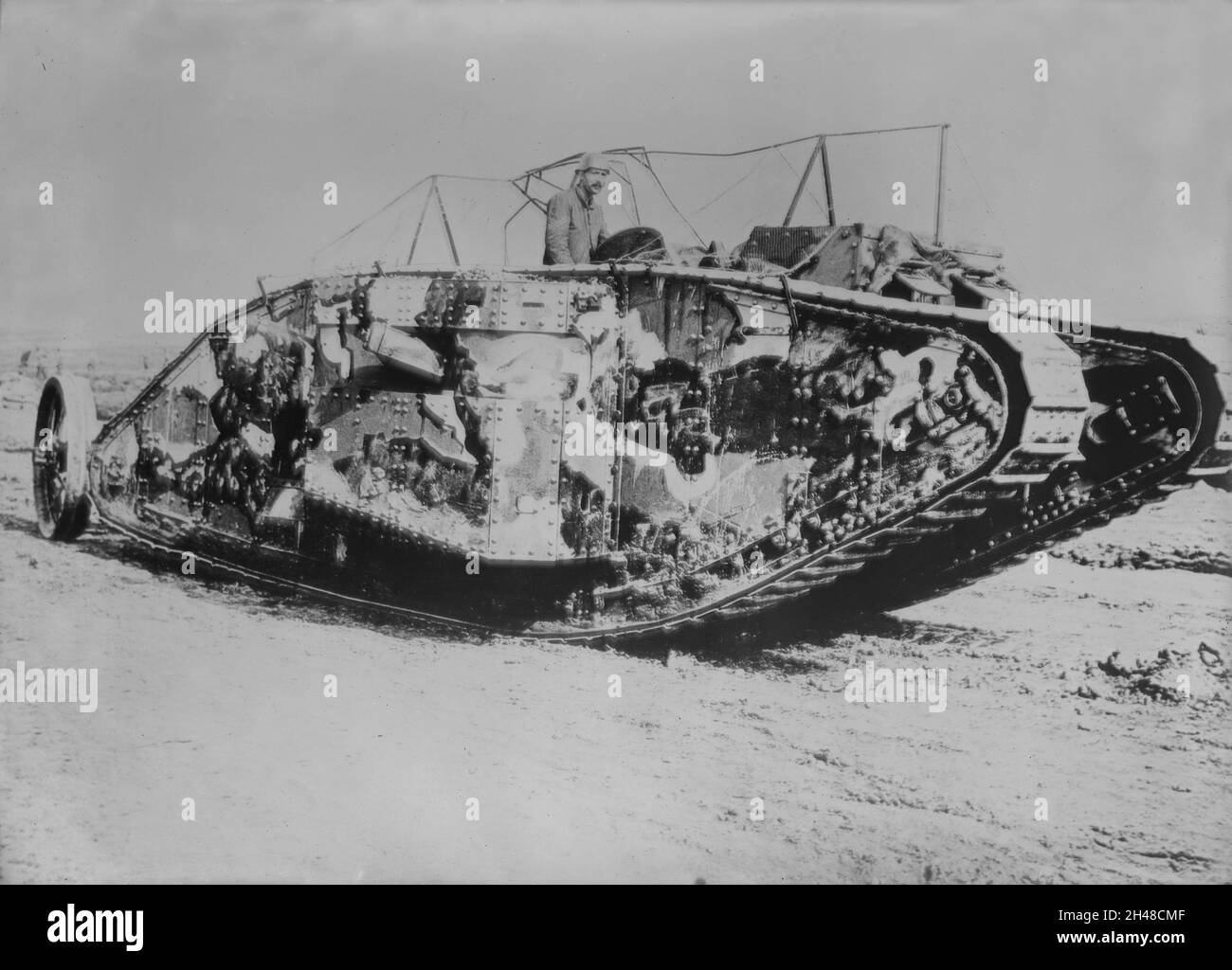 A vintage photo dated September 15th 1916 of a British Mark 1 female tank during The Battle of Flers-Courcelette on the Western front in the Somme France. This was where British forces first used tanks. The Mark 1 female tank was armed with four Vickers and one Hotchkiss machine-gun Stock Photohttps://www.alamy.com/image-license-details/?v=1https://www.alamy.com/a-vintage-photo-dated-september-15th-1916-of-a-british-mark-1-female-tank-during-the-battle-of-flers-courcelette-on-the-western-front-in-the-somme-france-this-was-where-british-forces-first-used-tanks-the-mark-1-female-tank-was-armed-with-four-vickers-and-one-hotchkiss-machine-gun-image450113791.html
A vintage photo dated September 15th 1916 of a British Mark 1 female tank during The Battle of Flers-Courcelette on the Western front in the Somme France. This was where British forces first used tanks. The Mark 1 female tank was armed with four Vickers and one Hotchkiss machine-gun Stock Photohttps://www.alamy.com/image-license-details/?v=1https://www.alamy.com/a-vintage-photo-dated-september-15th-1916-of-a-british-mark-1-female-tank-during-the-battle-of-flers-courcelette-on-the-western-front-in-the-somme-france-this-was-where-british-forces-first-used-tanks-the-mark-1-female-tank-was-armed-with-four-vickers-and-one-hotchkiss-machine-gun-image450113791.htmlRF2H48CMF–A vintage photo dated September 15th 1916 of a British Mark 1 female tank during The Battle of Flers-Courcelette on the Western front in the Somme France. This was where British forces first used tanks. The Mark 1 female tank was armed with four Vickers and one Hotchkiss machine-gun
 Illustration of types of British & German aeroplanes used during WW1 Stock Photohttps://www.alamy.com/image-license-details/?v=1https://www.alamy.com/illustration-of-types-of-british-german-aeroplanes-used-during-ww1-image154330386.html
Illustration of types of British & German aeroplanes used during WW1 Stock Photohttps://www.alamy.com/image-license-details/?v=1https://www.alamy.com/illustration-of-types-of-british-german-aeroplanes-used-during-ww1-image154330386.htmlRMJY29YE–Illustration of types of British & German aeroplanes used during WW1
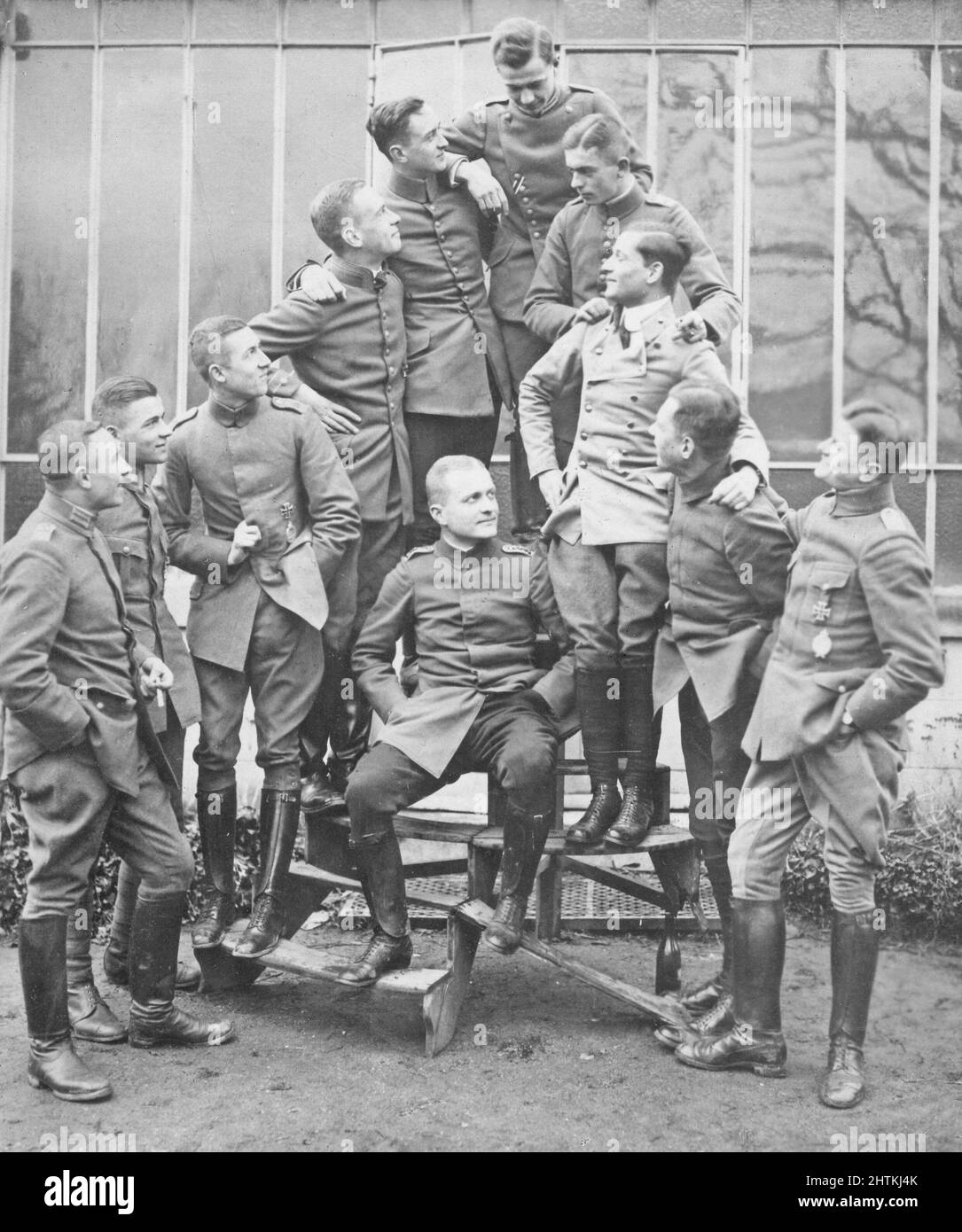 Manfred Albrecht Freiherr von Richthofen. 2 May 1892 – 21 April 1918), known in English as Baron von Richthofen, was a fighter pilot with the German Air Force during World War I. He is considered the ace-of-aces of the war, being officially credited with 80 air combat victories. Pictured in the middle with fellow german airmen at the time of the great war 1914-1918. Stock Photohttps://www.alamy.com/image-license-details/?v=1https://www.alamy.com/manfred-albrecht-freiherr-von-richthofen-2-may-1892-21-april-1918-known-in-english-as-baron-von-richthofen-was-a-fighter-pilot-with-the-german-air-force-during-world-war-i-he-is-considered-the-ace-of-aces-of-the-war-being-officially-credited-with-80-air-combat-victories-pictured-in-the-middle-with-fellow-german-airmen-at-the-time-of-the-great-war-1914-1918-image462652643.html
Manfred Albrecht Freiherr von Richthofen. 2 May 1892 – 21 April 1918), known in English as Baron von Richthofen, was a fighter pilot with the German Air Force during World War I. He is considered the ace-of-aces of the war, being officially credited with 80 air combat victories. Pictured in the middle with fellow german airmen at the time of the great war 1914-1918. Stock Photohttps://www.alamy.com/image-license-details/?v=1https://www.alamy.com/manfred-albrecht-freiherr-von-richthofen-2-may-1892-21-april-1918-known-in-english-as-baron-von-richthofen-was-a-fighter-pilot-with-the-german-air-force-during-world-war-i-he-is-considered-the-ace-of-aces-of-the-war-being-officially-credited-with-80-air-combat-victories-pictured-in-the-middle-with-fellow-german-airmen-at-the-time-of-the-great-war-1914-1918-image462652643.htmlRM2HTKJ4K–Manfred Albrecht Freiherr von Richthofen. 2 May 1892 – 21 April 1918), known in English as Baron von Richthofen, was a fighter pilot with the German Air Force during World War I. He is considered the ace-of-aces of the war, being officially credited with 80 air combat victories. Pictured in the middle with fellow german airmen at the time of the great war 1914-1918.
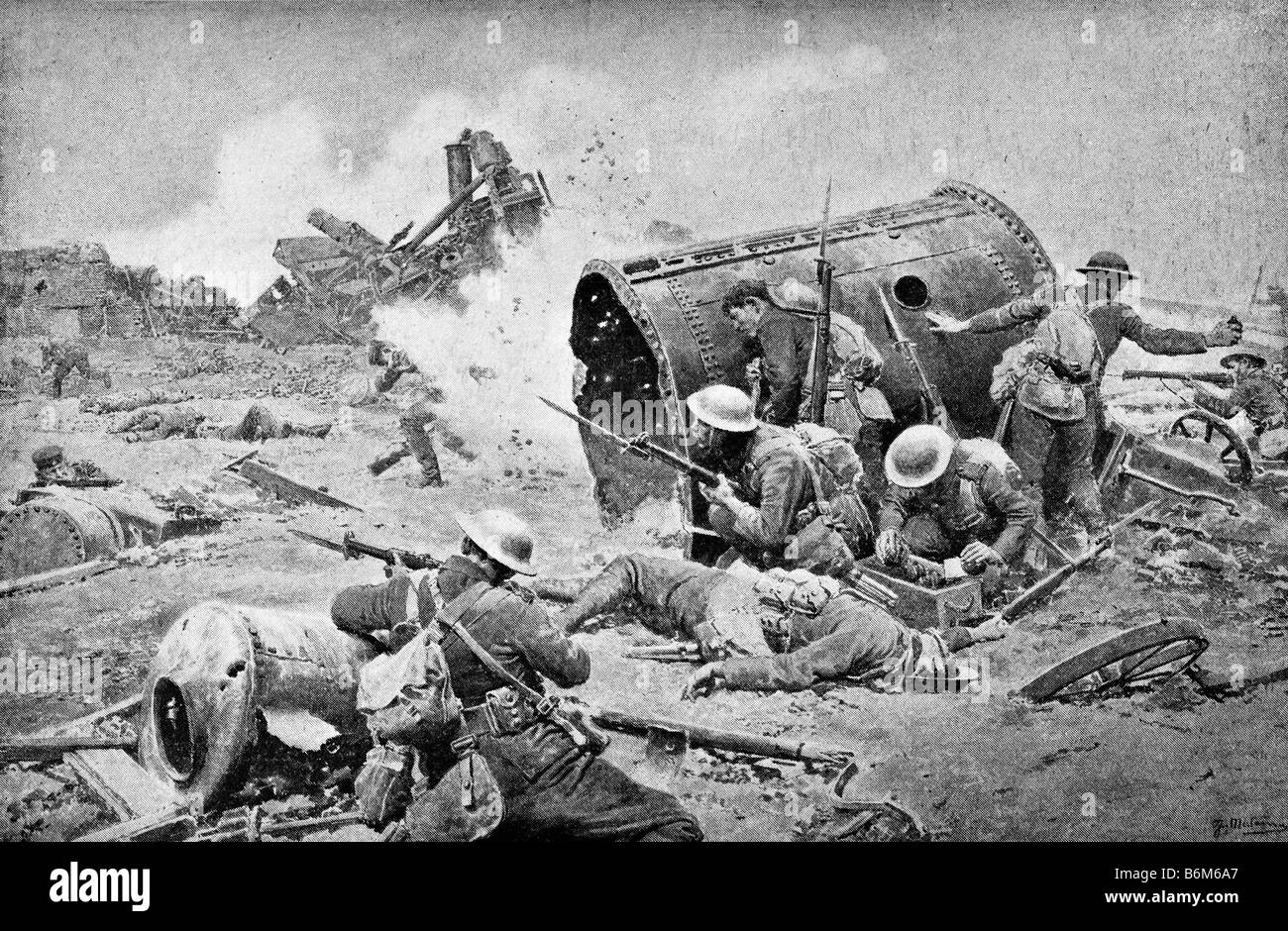 Contemporary World War One illustration of Canadian troops in action in France during the Battle of the Somme. Stock Photohttps://www.alamy.com/image-license-details/?v=1https://www.alamy.com/stock-photo-contemporary-world-war-one-illustration-of-canadian-troops-in-action-21342335.html
Contemporary World War One illustration of Canadian troops in action in France during the Battle of the Somme. Stock Photohttps://www.alamy.com/image-license-details/?v=1https://www.alamy.com/stock-photo-contemporary-world-war-one-illustration-of-canadian-troops-in-action-21342335.htmlRMB6M6A7–Contemporary World War One illustration of Canadian troops in action in France during the Battle of the Somme.
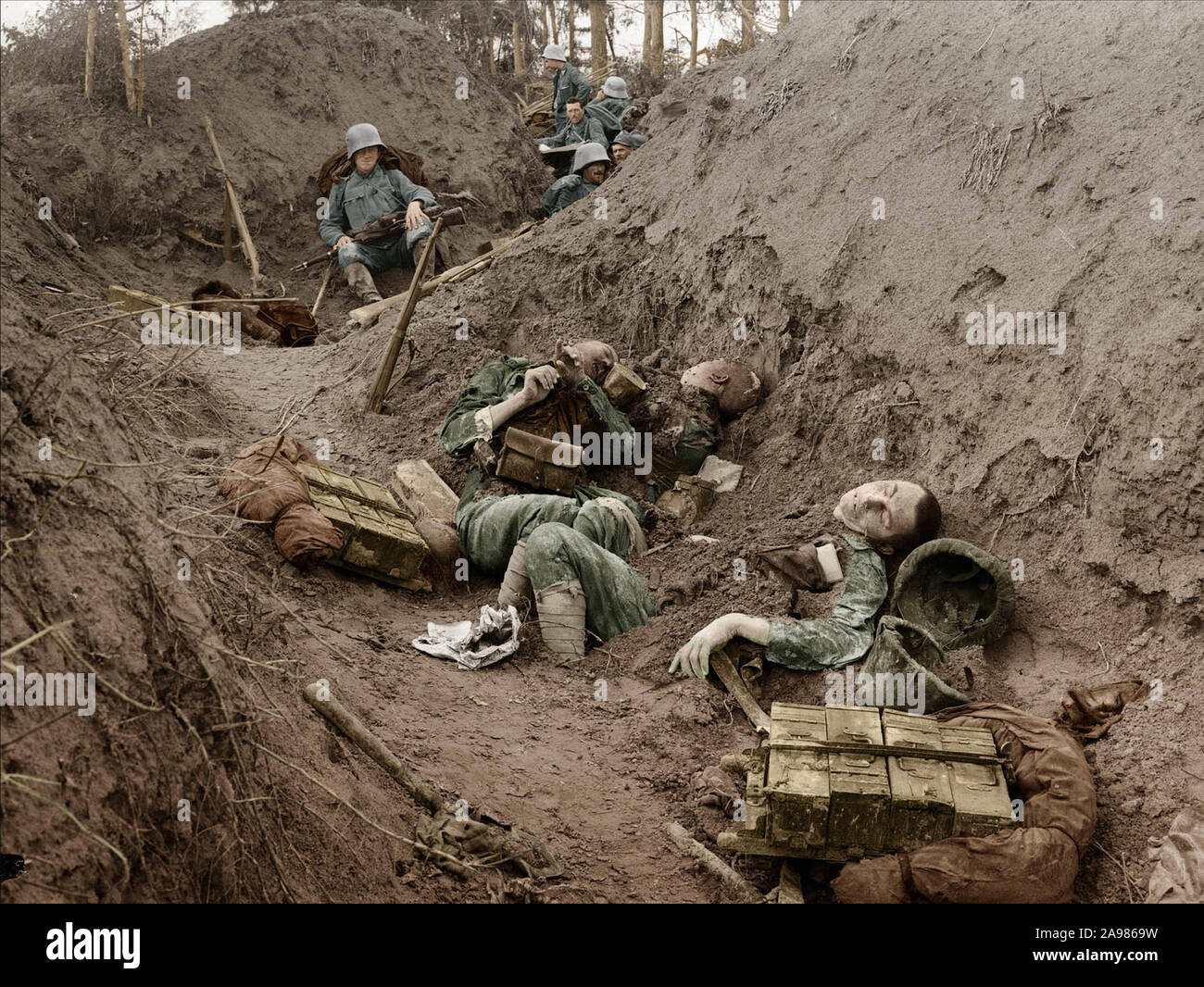 Dead bodies inside a trench during World War I Stock Photohttps://www.alamy.com/image-license-details/?v=1https://www.alamy.com/dead-bodies-inside-a-trench-during-world-war-i-image332709493.html
Dead bodies inside a trench during World War I Stock Photohttps://www.alamy.com/image-license-details/?v=1https://www.alamy.com/dead-bodies-inside-a-trench-during-world-war-i-image332709493.htmlRM2A9869W–Dead bodies inside a trench during World War I
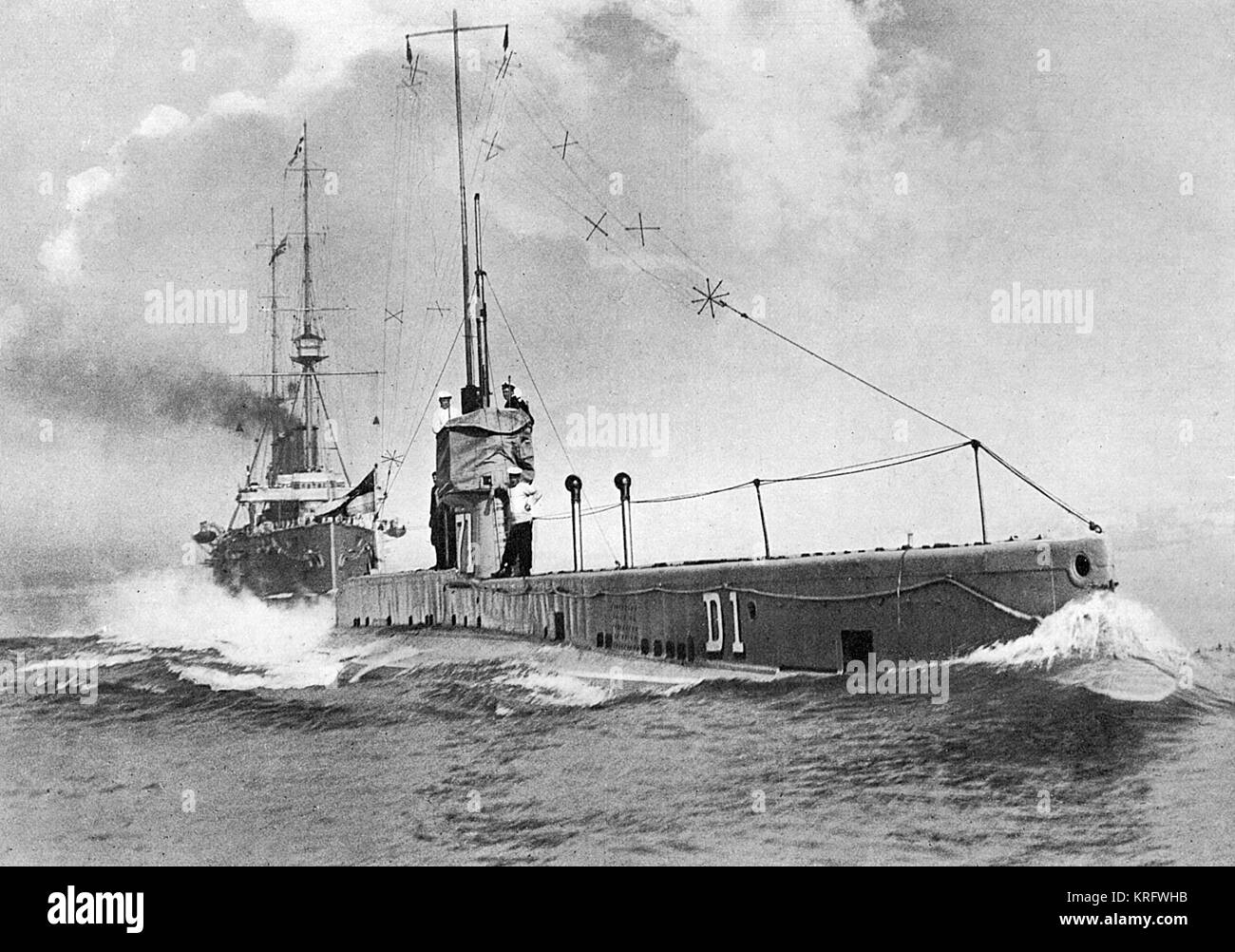 British submarine 'D 1' with H.M.S. 'Drake' following in her wake. All the latest British submarines during the First World War period were fitted with wireless telegraphy. Date: 1914 Stock Photohttps://www.alamy.com/image-license-details/?v=1https://www.alamy.com/stock-image-british-submarine-d-1-with-hms-drake-following-in-her-wake-all-the-169379767.html
British submarine 'D 1' with H.M.S. 'Drake' following in her wake. All the latest British submarines during the First World War period were fitted with wireless telegraphy. Date: 1914 Stock Photohttps://www.alamy.com/image-license-details/?v=1https://www.alamy.com/stock-image-british-submarine-d-1-with-hms-drake-following-in-her-wake-all-the-169379767.htmlRMKRFWHB–British submarine 'D 1' with H.M.S. 'Drake' following in her wake. All the latest British submarines during the First World War period were fitted with wireless telegraphy. Date: 1914
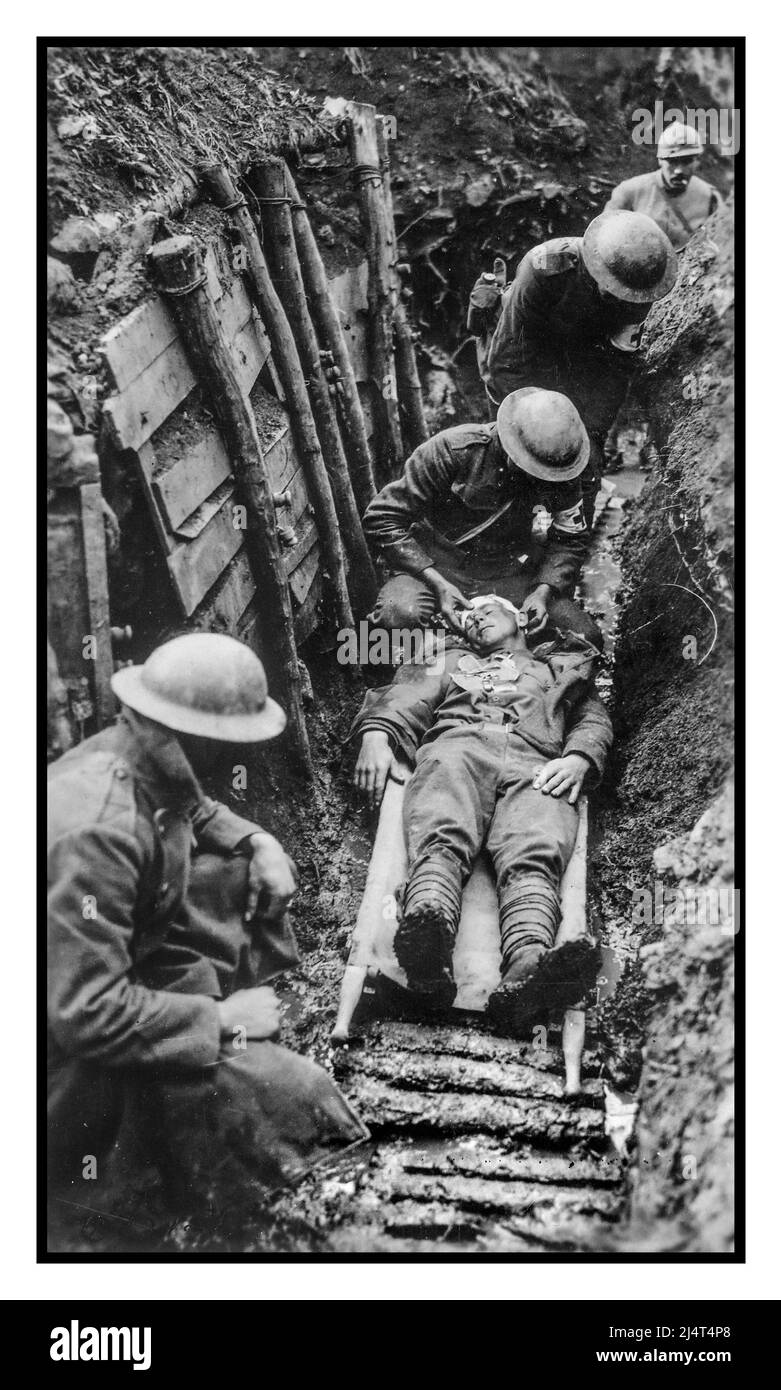 Trench Warfare WW1 American Marine receiving first aid treatment on a stretcher before being transportred to hospital Toulon sector trenches 1918 Stark reality of treatment of the wounded in trenches during trench warfare France World War 1 First World War Stock Photohttps://www.alamy.com/image-license-details/?v=1https://www.alamy.com/trench-warfare-ww1-american-marine-receiving-first-aid-treatment-on-a-stretcher-before-being-transportred-to-hospital-toulon-sector-trenches-1918-stark-reality-of-treatment-of-the-wounded-in-trenches-during-trench-warfare-france-world-war-1-first-world-war-image467669168.html
Trench Warfare WW1 American Marine receiving first aid treatment on a stretcher before being transportred to hospital Toulon sector trenches 1918 Stark reality of treatment of the wounded in trenches during trench warfare France World War 1 First World War Stock Photohttps://www.alamy.com/image-license-details/?v=1https://www.alamy.com/trench-warfare-ww1-american-marine-receiving-first-aid-treatment-on-a-stretcher-before-being-transportred-to-hospital-toulon-sector-trenches-1918-stark-reality-of-treatment-of-the-wounded-in-trenches-during-trench-warfare-france-world-war-1-first-world-war-image467669168.htmlRM2J4T4P8–Trench Warfare WW1 American Marine receiving first aid treatment on a stretcher before being transportred to hospital Toulon sector trenches 1918 Stark reality of treatment of the wounded in trenches during trench warfare France World War 1 First World War
 A British trench near the Albert-Bapaume road at Ovillers-la-Boisselle, July 1916 during the Battle of the Somme. Stock Photohttps://www.alamy.com/image-license-details/?v=1https://www.alamy.com/stock-photo-a-british-trench-near-the-albert-bapaume-road-at-ovillers-la-boisselle-34070424.html
A British trench near the Albert-Bapaume road at Ovillers-la-Boisselle, July 1916 during the Battle of the Somme. Stock Photohttps://www.alamy.com/image-license-details/?v=1https://www.alamy.com/stock-photo-a-british-trench-near-the-albert-bapaume-road-at-ovillers-la-boisselle-34070424.htmlRMBYC14T–A British trench near the Albert-Bapaume road at Ovillers-la-Boisselle, July 1916 during the Battle of the Somme.
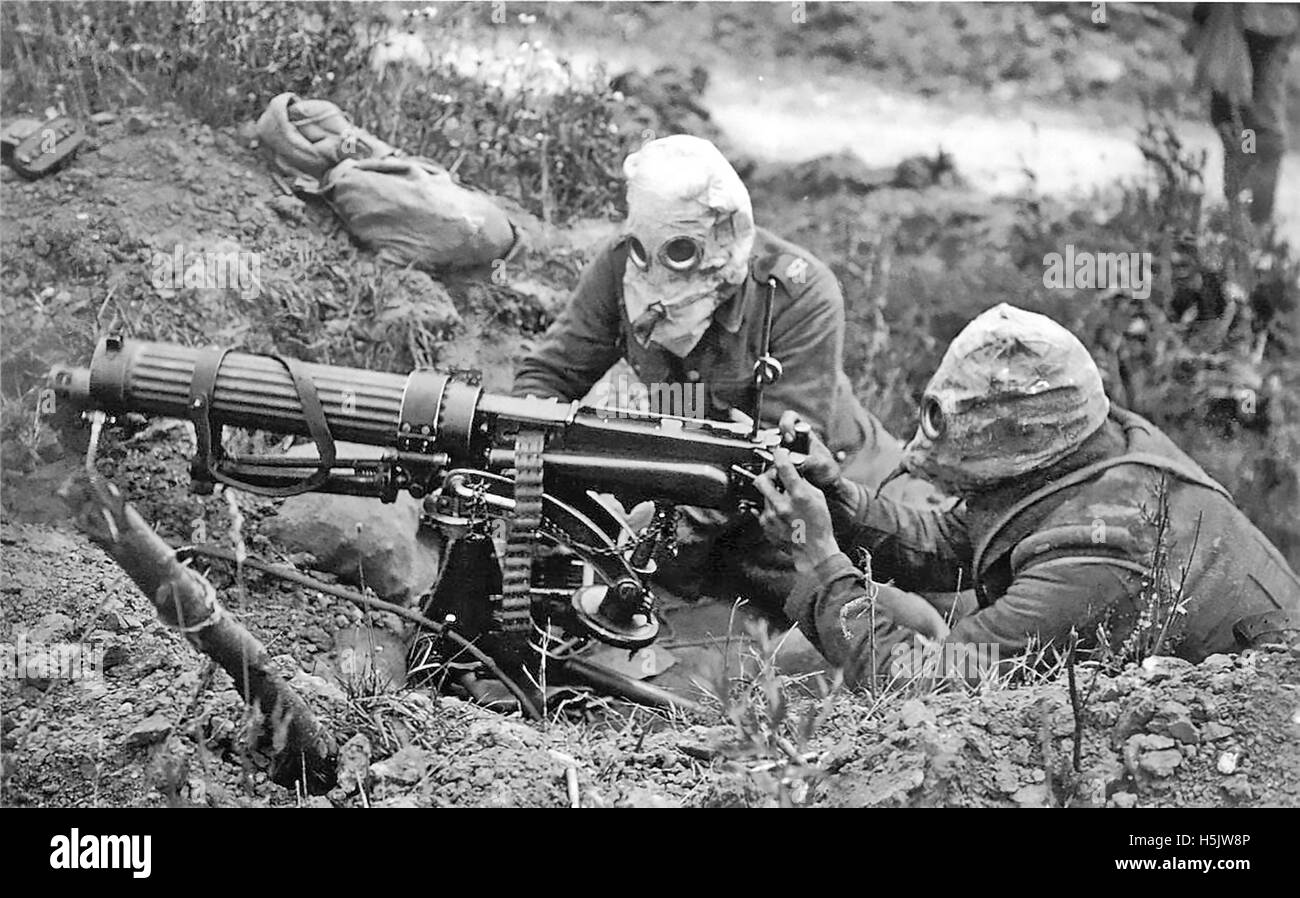 MACHINE GUN CORPS First World War. Two man gun crew (loader and firer) wearing early PH-type gas helmets using a Vickers Mk 1 water-cooled machine gun in a dugout near Ovillers in July 1916 during the Battle of the Somme. Stock Photohttps://www.alamy.com/image-license-details/?v=1https://www.alamy.com/stock-photo-machine-gun-corps-first-world-war-two-man-gun-crew-loader-and-firer-123960838.html
MACHINE GUN CORPS First World War. Two man gun crew (loader and firer) wearing early PH-type gas helmets using a Vickers Mk 1 water-cooled machine gun in a dugout near Ovillers in July 1916 during the Battle of the Somme. Stock Photohttps://www.alamy.com/image-license-details/?v=1https://www.alamy.com/stock-photo-machine-gun-corps-first-world-war-two-man-gun-crew-loader-and-firer-123960838.htmlRMH5JW8P–MACHINE GUN CORPS First World War. Two man gun crew (loader and firer) wearing early PH-type gas helmets using a Vickers Mk 1 water-cooled machine gun in a dugout near Ovillers in July 1916 during the Battle of the Somme.
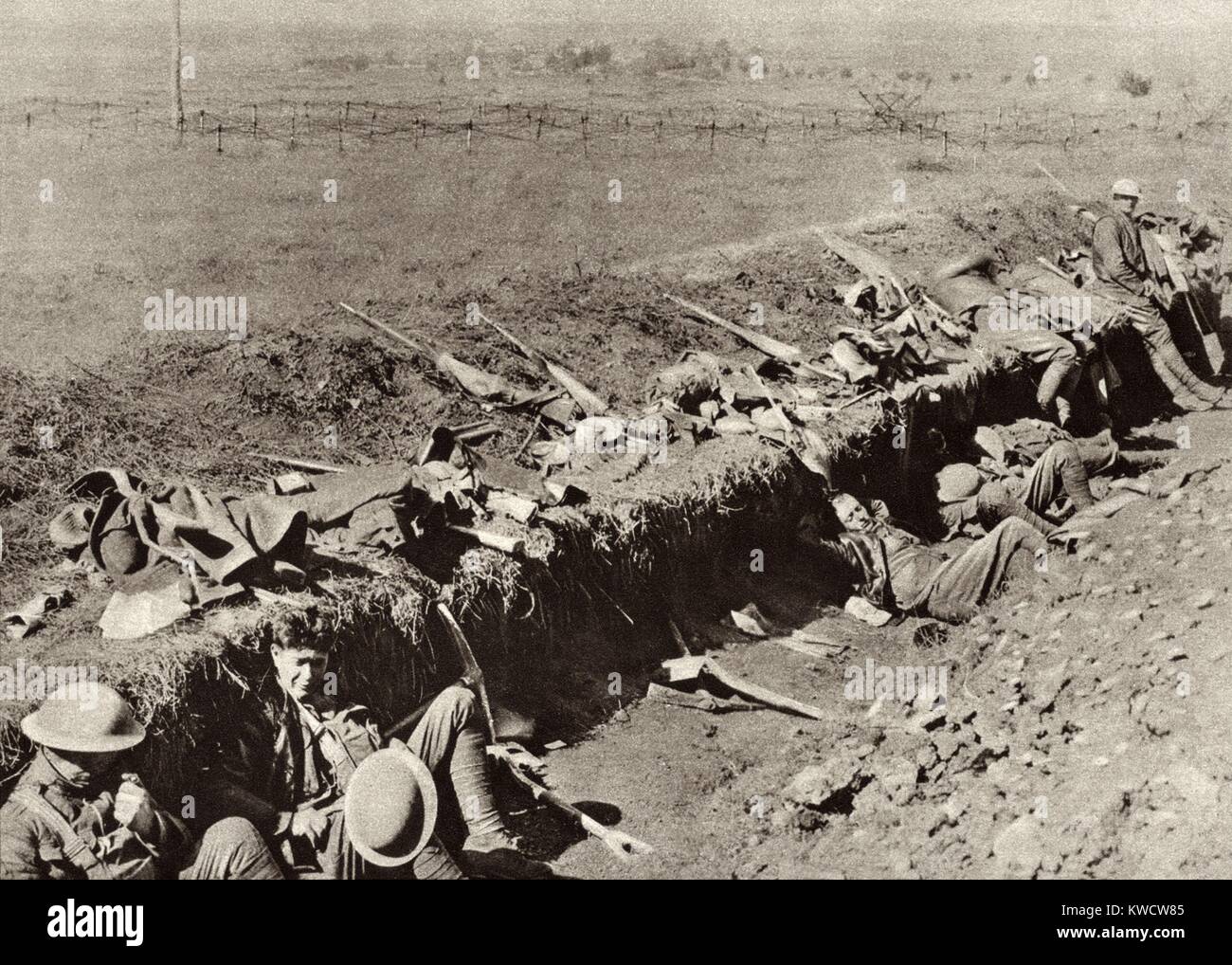 World War 1: Meuse-Argonne Offensive. American troops take a break from trench digging during the final Allied battle to drive German armies out of France. U.S. effort took place in the Verdun Sector, north and northwest of the town of Verdun, between Sept. 26 and Nov. 11, 1918. (BSLOC 2013 1 209) Stock Photohttps://www.alamy.com/image-license-details/?v=1https://www.alamy.com/stock-photo-world-war-1-meuse-argonne-offensive-american-troops-take-a-break-from-170542965.html
World War 1: Meuse-Argonne Offensive. American troops take a break from trench digging during the final Allied battle to drive German armies out of France. U.S. effort took place in the Verdun Sector, north and northwest of the town of Verdun, between Sept. 26 and Nov. 11, 1918. (BSLOC 2013 1 209) Stock Photohttps://www.alamy.com/image-license-details/?v=1https://www.alamy.com/stock-photo-world-war-1-meuse-argonne-offensive-american-troops-take-a-break-from-170542965.htmlRMKWCW85–World War 1: Meuse-Argonne Offensive. American troops take a break from trench digging during the final Allied battle to drive German armies out of France. U.S. effort took place in the Verdun Sector, north and northwest of the town of Verdun, between Sept. 26 and Nov. 11, 1918. (BSLOC 2013 1 209)
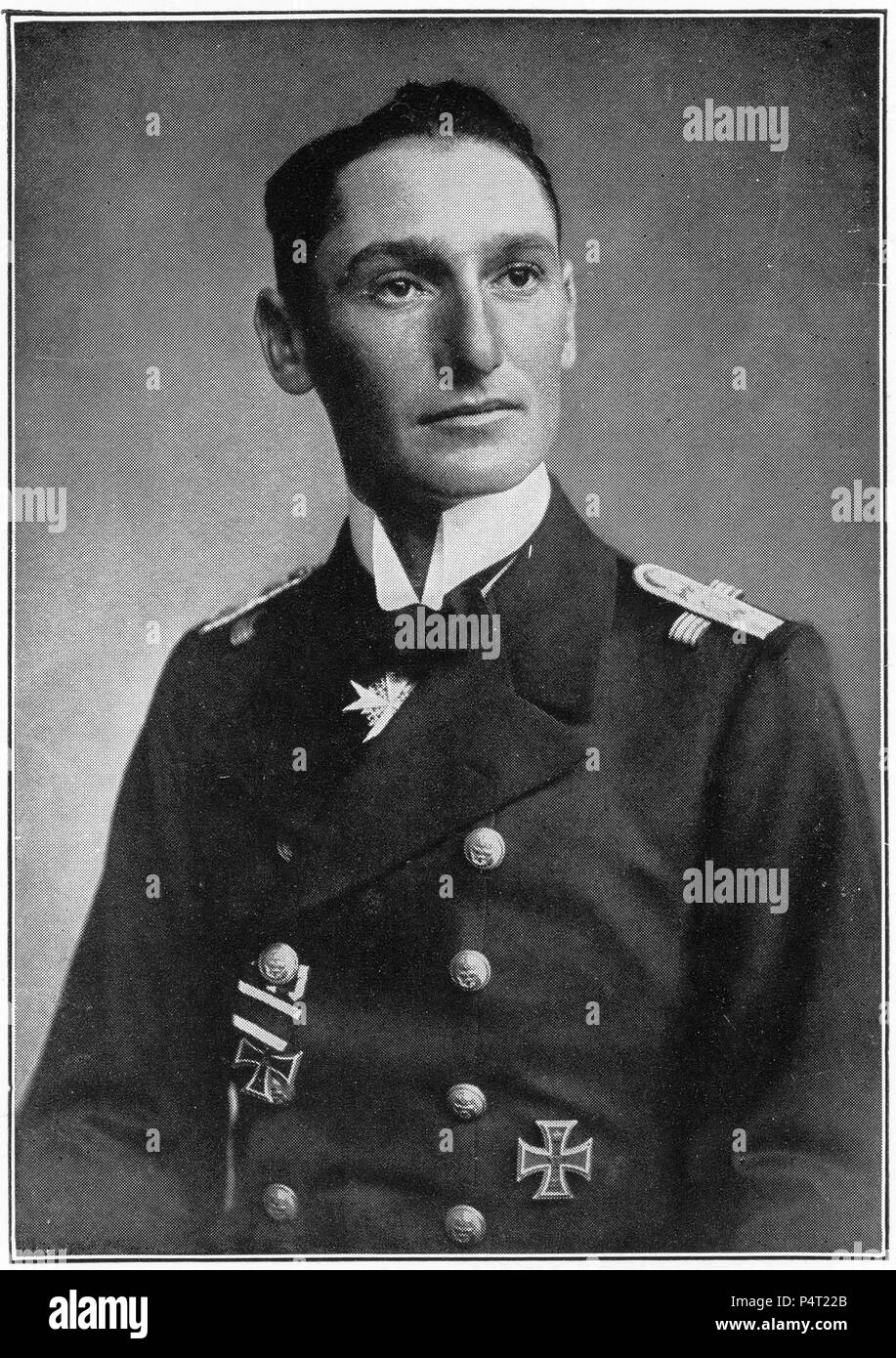 Halftone of Lieutenant-Commander Otto Hersing, a German submarine commander famed for sinking Allied battleships during World War One with U-21. Stock Photohttps://www.alamy.com/image-license-details/?v=1https://www.alamy.com/halftone-of-lieutenant-commander-otto-hersing-a-german-submarine-commander-famed-for-sinking-allied-battleships-during-world-war-one-with-u-21-image209511523.html
Halftone of Lieutenant-Commander Otto Hersing, a German submarine commander famed for sinking Allied battleships during World War One with U-21. Stock Photohttps://www.alamy.com/image-license-details/?v=1https://www.alamy.com/halftone-of-lieutenant-commander-otto-hersing-a-german-submarine-commander-famed-for-sinking-allied-battleships-during-world-war-one-with-u-21-image209511523.htmlRMP4T22B–Halftone of Lieutenant-Commander Otto Hersing, a German submarine commander famed for sinking Allied battleships during World War One with U-21.
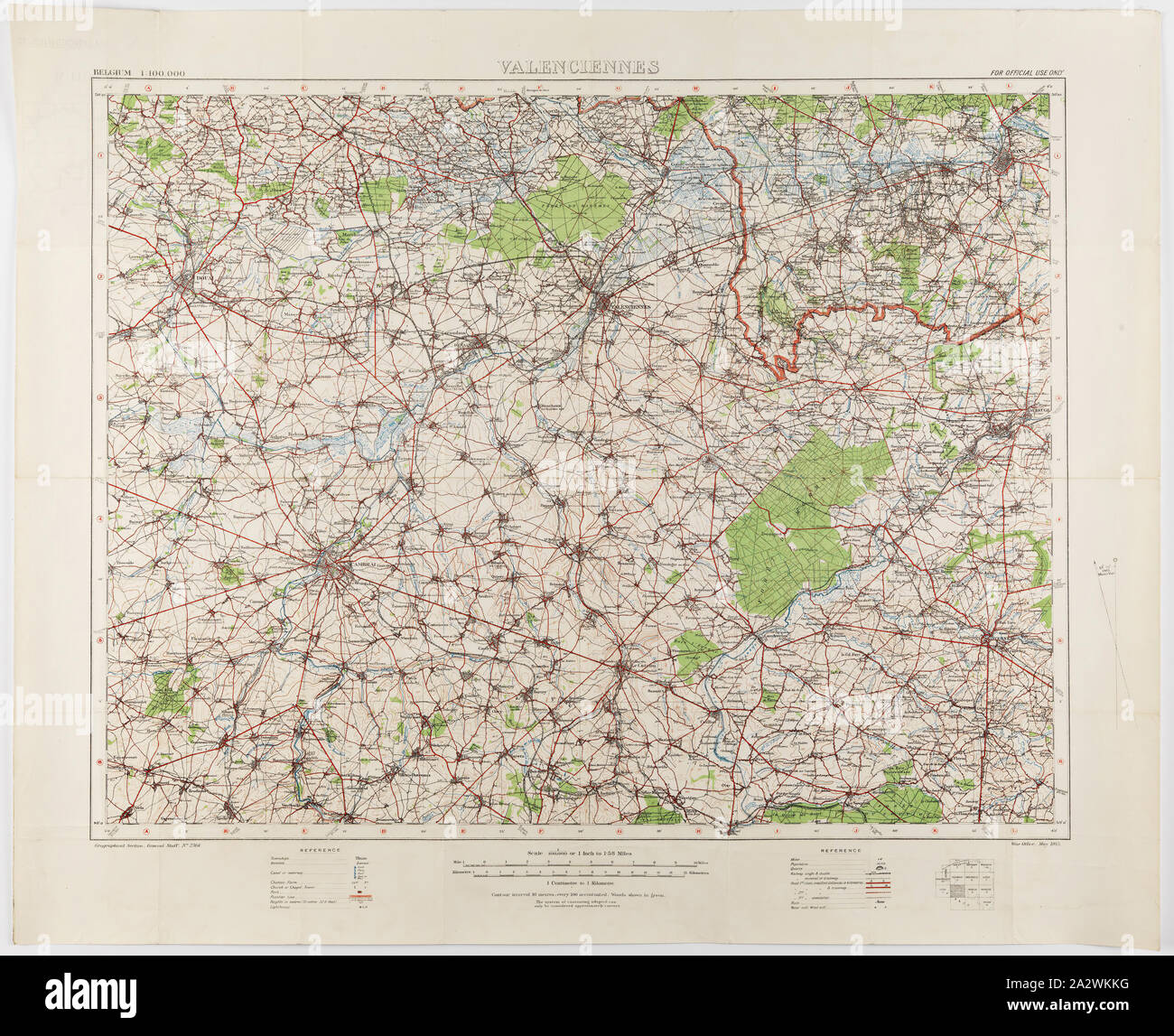 Map - Military, Belgium, Valenciennes 12, Scale 1:100,000, World War I, 1914-1918, Military map of Belgium, Valenciennes 12 region, scale 1:100,000. The map would have been used during World War I. Maps of this scale lacked the detail needed for trench warfare, instead providing an overview of regions for the use of senior commanders. Part of the collection of World War I memorabilia donated by Sergeant John Lord (#6252). John Lord was 19 years old when he enlisted with Stock Photohttps://www.alamy.com/image-license-details/?v=1https://www.alamy.com/map-military-belgium-valenciennes-12-scale-1100000-world-war-i-1914-1918-military-map-of-belgium-valenciennes-12-region-scale-1100000-the-map-would-have-been-used-during-world-war-i-maps-of-this-scale-lacked-the-detail-needed-for-trench-warfare-instead-providing-an-overview-of-regions-for-the-use-of-senior-commanders-part-of-the-collection-of-world-war-i-memorabilia-donated-by-sergeant-john-lord-6252-john-lord-was-19-years-old-when-he-enlisted-with-image328790548.html
Map - Military, Belgium, Valenciennes 12, Scale 1:100,000, World War I, 1914-1918, Military map of Belgium, Valenciennes 12 region, scale 1:100,000. The map would have been used during World War I. Maps of this scale lacked the detail needed for trench warfare, instead providing an overview of regions for the use of senior commanders. Part of the collection of World War I memorabilia donated by Sergeant John Lord (#6252). John Lord was 19 years old when he enlisted with Stock Photohttps://www.alamy.com/image-license-details/?v=1https://www.alamy.com/map-military-belgium-valenciennes-12-scale-1100000-world-war-i-1914-1918-military-map-of-belgium-valenciennes-12-region-scale-1100000-the-map-would-have-been-used-during-world-war-i-maps-of-this-scale-lacked-the-detail-needed-for-trench-warfare-instead-providing-an-overview-of-regions-for-the-use-of-senior-commanders-part-of-the-collection-of-world-war-i-memorabilia-donated-by-sergeant-john-lord-6252-john-lord-was-19-years-old-when-he-enlisted-with-image328790548.htmlRM2A2WKKG–Map - Military, Belgium, Valenciennes 12, Scale 1:100,000, World War I, 1914-1918, Military map of Belgium, Valenciennes 12 region, scale 1:100,000. The map would have been used during World War I. Maps of this scale lacked the detail needed for trench warfare, instead providing an overview of regions for the use of senior commanders. Part of the collection of World War I memorabilia donated by Sergeant John Lord (#6252). John Lord was 19 years old when he enlisted with
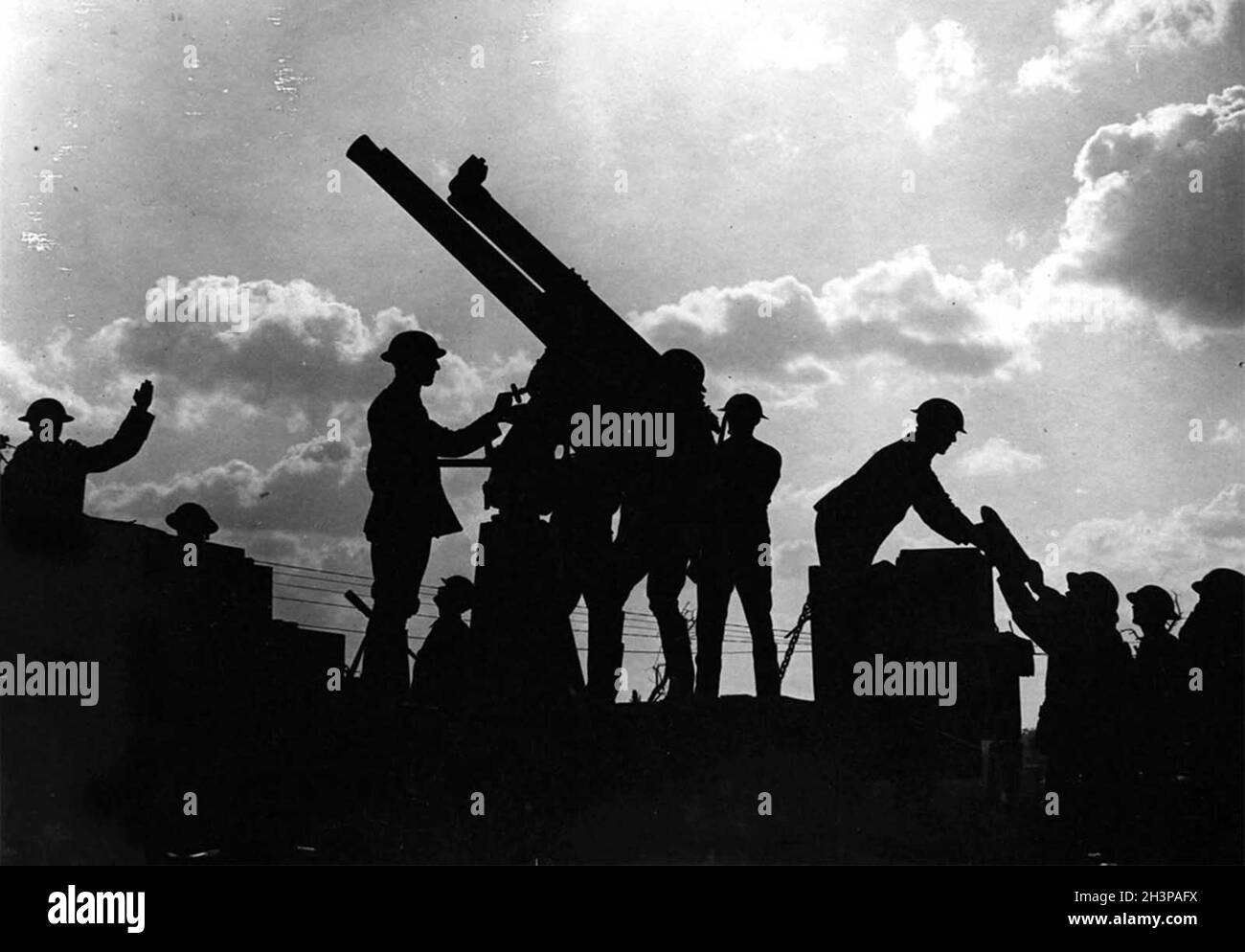 Soldiers silhouetted against the sky prepare to fire an anti-aircraft gun during the Battle of Broodseinde during the Passchendaele campaign. Stock Photohttps://www.alamy.com/image-license-details/?v=1https://www.alamy.com/soldiers-silhouetted-against-the-sky-prepare-to-fire-an-anti-aircraft-gun-during-the-battle-of-broodseinde-during-the-passchendaele-campaign-image449804766.html
Soldiers silhouetted against the sky prepare to fire an anti-aircraft gun during the Battle of Broodseinde during the Passchendaele campaign. Stock Photohttps://www.alamy.com/image-license-details/?v=1https://www.alamy.com/soldiers-silhouetted-against-the-sky-prepare-to-fire-an-anti-aircraft-gun-during-the-battle-of-broodseinde-during-the-passchendaele-campaign-image449804766.htmlRM2H3PAFX–Soldiers silhouetted against the sky prepare to fire an anti-aircraft gun during the Battle of Broodseinde during the Passchendaele campaign.
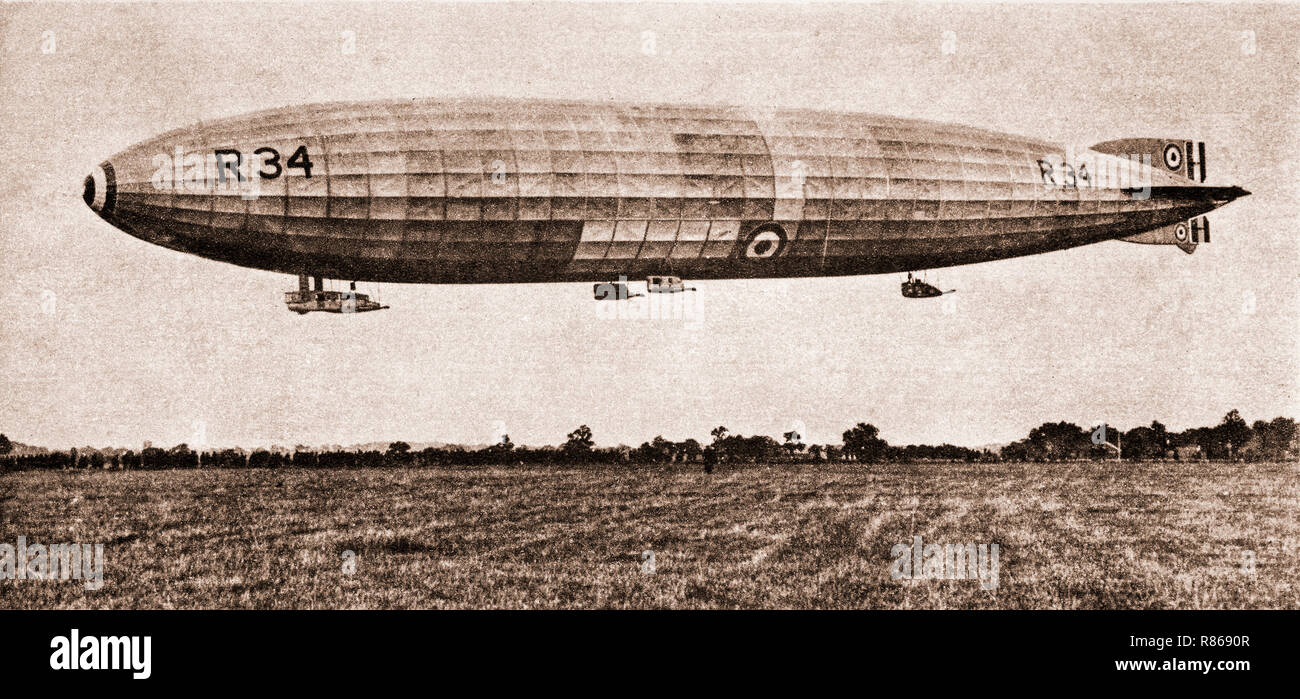 The R33 class of British rigid airships were built for the Royal Naval Air Service during the First World War, but were not completed until after the end of hostilities, by which time the RNAS had become part of the Royal Air Force. The lead ship, R33, went on to serve successfully for ten years. the later R34, became the first aircraft to make an east to west transatlantic flight in July 1919 and by the return flight, completed successfully the first two-way crossing, and was decommissioned two years later after being damaged during a storm. Stock Photohttps://www.alamy.com/image-license-details/?v=1https://www.alamy.com/the-r33-class-of-british-rigid-airships-were-built-for-the-royal-naval-air-service-during-the-first-world-war-but-were-not-completed-until-after-the-end-of-hostilities-by-which-time-the-rnas-had-become-part-of-the-royal-air-force-the-lead-ship-r33-went-on-to-serve-successfully-for-ten-years-the-later-r34-became-the-first-aircraft-to-make-an-east-to-west-transatlantic-flight-in-july-1919-and-by-the-return-flight-completed-successfully-the-first-two-way-crossing-and-was-decommissioned-two-years-later-after-being-damaged-during-a-storm-image228790823.html
The R33 class of British rigid airships were built for the Royal Naval Air Service during the First World War, but were not completed until after the end of hostilities, by which time the RNAS had become part of the Royal Air Force. The lead ship, R33, went on to serve successfully for ten years. the later R34, became the first aircraft to make an east to west transatlantic flight in July 1919 and by the return flight, completed successfully the first two-way crossing, and was decommissioned two years later after being damaged during a storm. Stock Photohttps://www.alamy.com/image-license-details/?v=1https://www.alamy.com/the-r33-class-of-british-rigid-airships-were-built-for-the-royal-naval-air-service-during-the-first-world-war-but-were-not-completed-until-after-the-end-of-hostilities-by-which-time-the-rnas-had-become-part-of-the-royal-air-force-the-lead-ship-r33-went-on-to-serve-successfully-for-ten-years-the-later-r34-became-the-first-aircraft-to-make-an-east-to-west-transatlantic-flight-in-july-1919-and-by-the-return-flight-completed-successfully-the-first-two-way-crossing-and-was-decommissioned-two-years-later-after-being-damaged-during-a-storm-image228790823.htmlRMR8690R–The R33 class of British rigid airships were built for the Royal Naval Air Service during the First World War, but were not completed until after the end of hostilities, by which time the RNAS had become part of the Royal Air Force. The lead ship, R33, went on to serve successfully for ten years. the later R34, became the first aircraft to make an east to west transatlantic flight in July 1919 and by the return flight, completed successfully the first two-way crossing, and was decommissioned two years later after being damaged during a storm.
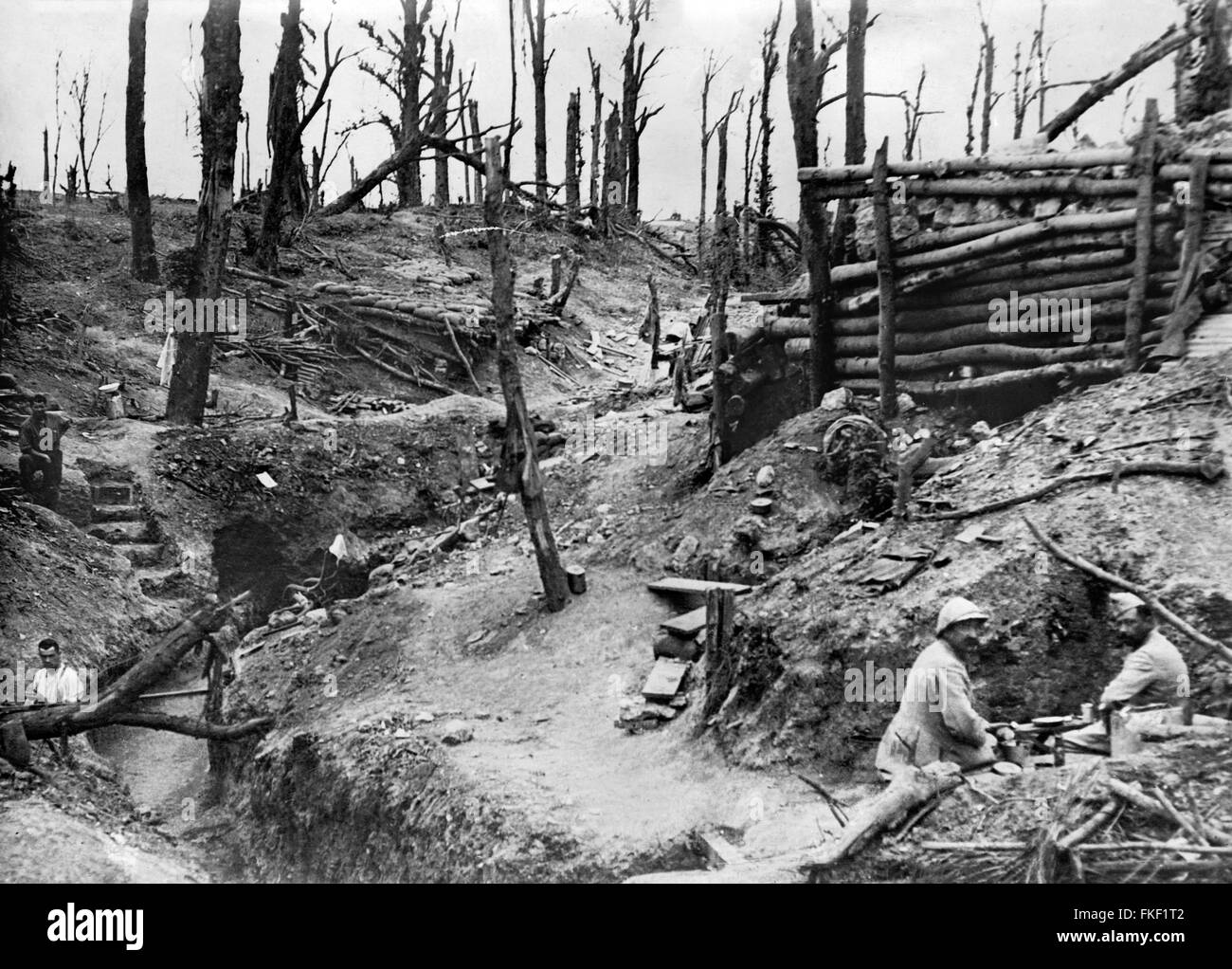 Battle of the Somme. Trenches in the Somme during World War I, c. 1916 Stock Photohttps://www.alamy.com/image-license-details/?v=1https://www.alamy.com/stock-photo-battle-of-the-somme-trenches-in-the-somme-during-world-war-i-c-1916-98061042.html
Battle of the Somme. Trenches in the Somme during World War I, c. 1916 Stock Photohttps://www.alamy.com/image-license-details/?v=1https://www.alamy.com/stock-photo-battle-of-the-somme-trenches-in-the-somme-during-world-war-i-c-1916-98061042.htmlRMFKF1T2–Battle of the Somme. Trenches in the Somme during World War I, c. 1916
 Repairing front line trench after bomb explosion fifty yards from enemy trenches. D. W. Griffith in civilian clothing. During filming of the motion picture Hearts of the World in France, 1917. Stock Photohttps://www.alamy.com/image-license-details/?v=1https://www.alamy.com/stock-photo-repairing-front-line-trench-after-bomb-explosion-fifty-yards-from-132936027.html
Repairing front line trench after bomb explosion fifty yards from enemy trenches. D. W. Griffith in civilian clothing. During filming of the motion picture Hearts of the World in France, 1917. Stock Photohttps://www.alamy.com/image-license-details/?v=1https://www.alamy.com/stock-photo-repairing-front-line-trench-after-bomb-explosion-fifty-yards-from-132936027.htmlRFHM7N77–Repairing front line trench after bomb explosion fifty yards from enemy trenches. D. W. Griffith in civilian clothing. During filming of the motion picture Hearts of the World in France, 1917.
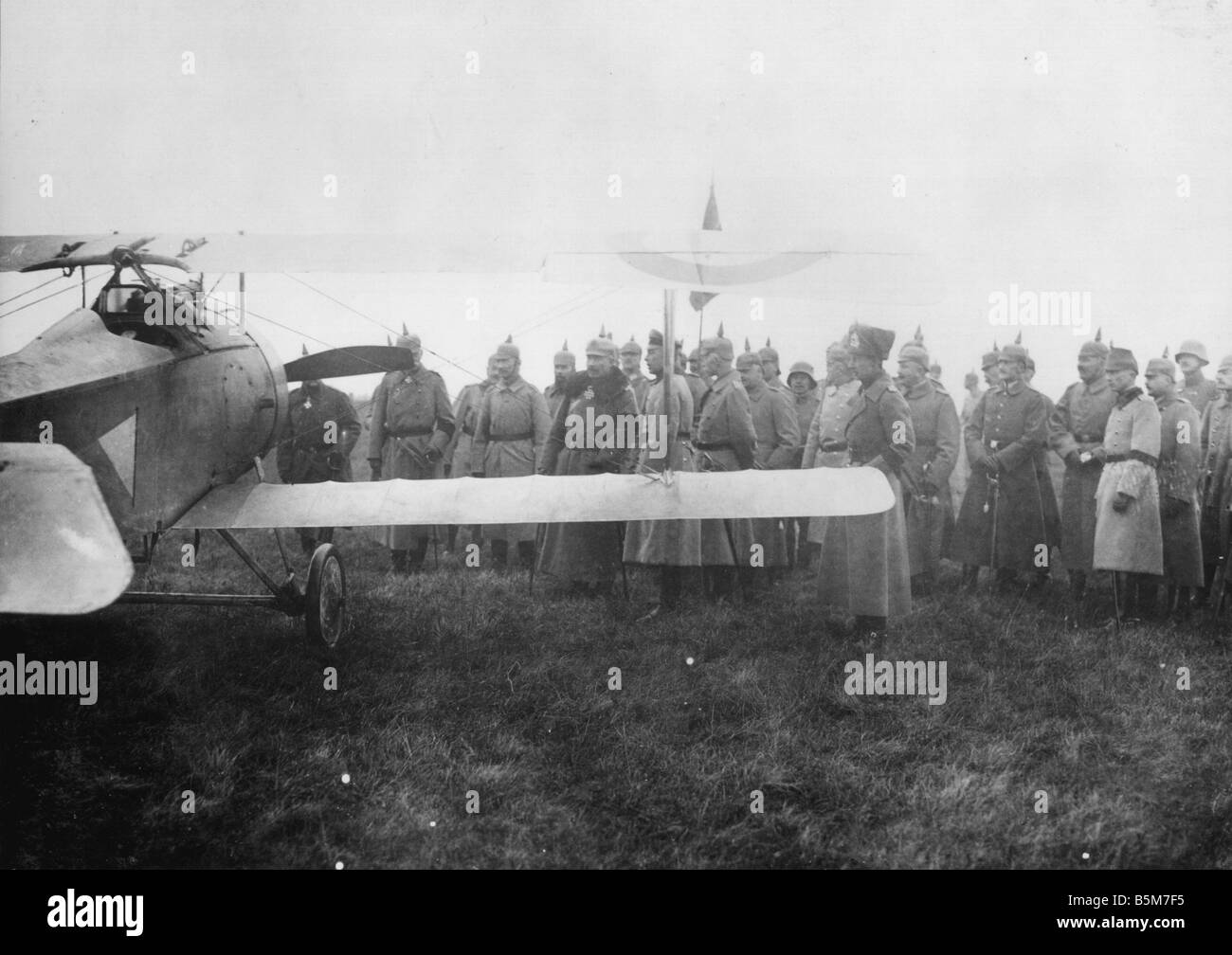 1 W46 F1917 9 Wilhelm II on Western front 1917 18 Wilhelm II German emperor 1888 1918 1859 1941 During World War I 1914 18 The G Stock Photohttps://www.alamy.com/image-license-details/?v=1https://www.alamy.com/stock-photo-1-w46-f1917-9-wilhelm-ii-on-western-front-1917-18-wilhelm-ii-german-20728601.html
1 W46 F1917 9 Wilhelm II on Western front 1917 18 Wilhelm II German emperor 1888 1918 1859 1941 During World War I 1914 18 The G Stock Photohttps://www.alamy.com/image-license-details/?v=1https://www.alamy.com/stock-photo-1-w46-f1917-9-wilhelm-ii-on-western-front-1917-18-wilhelm-ii-german-20728601.htmlRMB5M7F5–1 W46 F1917 9 Wilhelm II on Western front 1917 18 Wilhelm II German emperor 1888 1918 1859 1941 During World War I 1914 18 The G
 Original and clear WW1 era postcard of WW1 nurses, wounded WW1 servicemen convalescing at a hospital - possibly one of the many small hospitals set up for this purpose during the war. Possbibly these are casualties from the infamous Battle of the Somme which began on 1 July 1916. There is a light infantryman bugler, at front, and men represented from different regiments, photo taken in hospital grounds, posted from Wakefield 21 October 1916, Wakefield, West Yorkshire, U.K. Stock Photohttps://www.alamy.com/image-license-details/?v=1https://www.alamy.com/original-and-clear-ww1-era-postcard-of-ww1-nurses-wounded-ww1-servicemen-convalescing-at-a-hospital-possibly-one-of-the-many-small-hospitals-set-up-for-this-purpose-during-the-war-possbibly-these-are-casualties-from-the-infamous-battle-of-the-somme-which-began-on-1-july-1916-there-is-a-light-infantryman-bugler-at-front-and-men-represented-from-different-regiments-photo-taken-in-hospital-grounds-posted-from-wakefield-21-october-1916-wakefield-west-yorkshire-uk-image632692786.html
Original and clear WW1 era postcard of WW1 nurses, wounded WW1 servicemen convalescing at a hospital - possibly one of the many small hospitals set up for this purpose during the war. Possbibly these are casualties from the infamous Battle of the Somme which began on 1 July 1916. There is a light infantryman bugler, at front, and men represented from different regiments, photo taken in hospital grounds, posted from Wakefield 21 October 1916, Wakefield, West Yorkshire, U.K. Stock Photohttps://www.alamy.com/image-license-details/?v=1https://www.alamy.com/original-and-clear-ww1-era-postcard-of-ww1-nurses-wounded-ww1-servicemen-convalescing-at-a-hospital-possibly-one-of-the-many-small-hospitals-set-up-for-this-purpose-during-the-war-possbibly-these-are-casualties-from-the-infamous-battle-of-the-somme-which-began-on-1-july-1916-there-is-a-light-infantryman-bugler-at-front-and-men-represented-from-different-regiments-photo-taken-in-hospital-grounds-posted-from-wakefield-21-october-1916-wakefield-west-yorkshire-uk-image632692786.htmlRM2YN9J2X–Original and clear WW1 era postcard of WW1 nurses, wounded WW1 servicemen convalescing at a hospital - possibly one of the many small hospitals set up for this purpose during the war. Possbibly these are casualties from the infamous Battle of the Somme which began on 1 July 1916. There is a light infantryman bugler, at front, and men represented from different regiments, photo taken in hospital grounds, posted from Wakefield 21 October 1916, Wakefield, West Yorkshire, U.K.
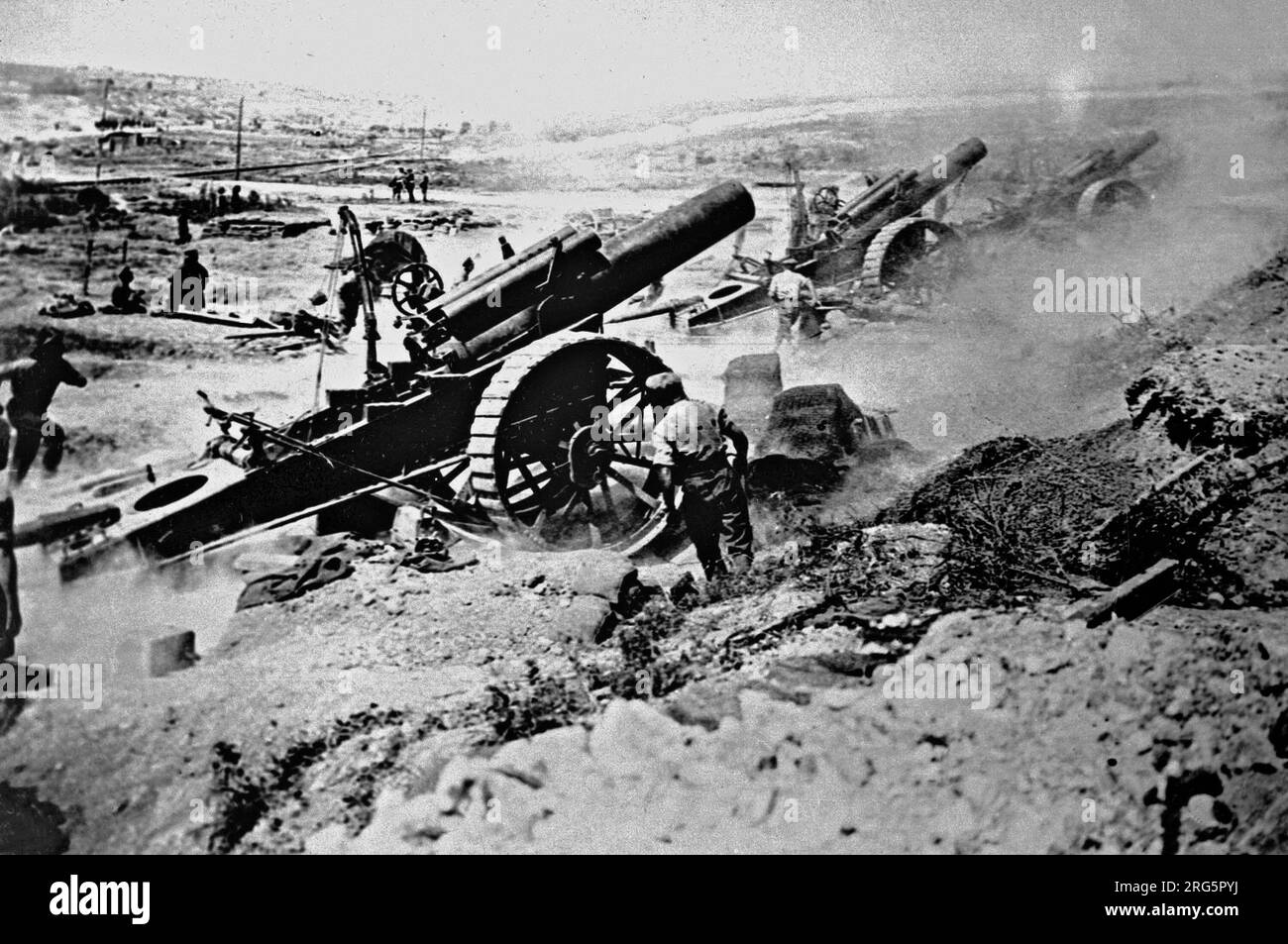 WESTERN FRONT, FRANCE - Circa 1916 - British Army Royal Artillery gun crews fire on German positions during the trench warfare of the Western Front du Stock Photohttps://www.alamy.com/image-license-details/?v=1https://www.alamy.com/western-front-france-circa-1916-british-army-royal-artillery-gun-crews-fire-on-german-positions-during-the-trench-warfare-of-the-western-front-du-image560694054.html
WESTERN FRONT, FRANCE - Circa 1916 - British Army Royal Artillery gun crews fire on German positions during the trench warfare of the Western Front du Stock Photohttps://www.alamy.com/image-license-details/?v=1https://www.alamy.com/western-front-france-circa-1916-british-army-royal-artillery-gun-crews-fire-on-german-positions-during-the-trench-warfare-of-the-western-front-du-image560694054.htmlRM2RG5PYJ–WESTERN FRONT, FRANCE - Circa 1916 - British Army Royal Artillery gun crews fire on German positions during the trench warfare of the Western Front du
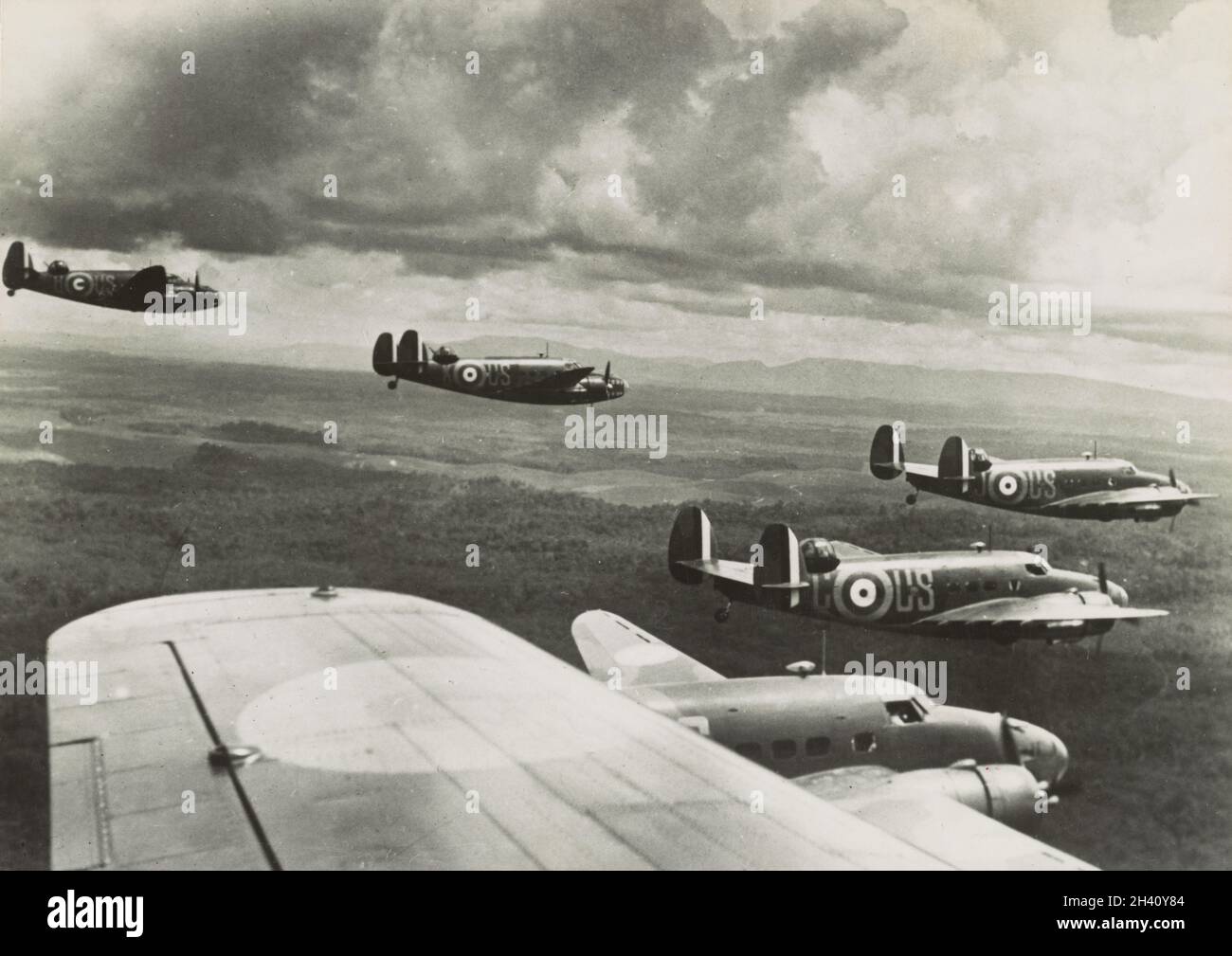 Vintage photo circa 1942 of a flight of Lockheed Hudson Mk.I bombers of the Royal Australian Air Force number 1 squadron flying over Malaya during the Japanese invasion of Malaya and the fall of Singapore. No. 1 Squadron launched a series of assaults on the Japanese forces, becoming the first aircraft to make an attack in the Pacific War. The Hudsons sank a Japanese transport ship, the IJN Awazisan Maru, and damaged two more transports, the Ayatosan Maru and Sakura Maru, for the loss of two Hudsons, an hour before the attack on Pearl Harbor Stock Photohttps://www.alamy.com/image-license-details/?v=1https://www.alamy.com/vintage-photo-circa-1942-of-a-flight-of-lockheed-hudson-mki-bombers-of-the-royal-australian-air-force-number-1-squadron-flying-over-malaya-during-the-japanese-invasion-of-malaya-and-the-fall-of-singapore-no-1-squadron-launched-a-series-of-assaults-on-the-japanese-forces-becoming-the-first-aircraft-to-make-an-attack-in-the-pacific-war-the-hudsons-sank-a-japanese-transport-ship-the-ijn-awazisan-maru-and-damaged-two-more-transports-the-ayatosan-maru-and-sakura-maru-for-the-loss-of-two-hudsons-an-hour-before-the-attack-on-pearl-harbor-image449949588.html
Vintage photo circa 1942 of a flight of Lockheed Hudson Mk.I bombers of the Royal Australian Air Force number 1 squadron flying over Malaya during the Japanese invasion of Malaya and the fall of Singapore. No. 1 Squadron launched a series of assaults on the Japanese forces, becoming the first aircraft to make an attack in the Pacific War. The Hudsons sank a Japanese transport ship, the IJN Awazisan Maru, and damaged two more transports, the Ayatosan Maru and Sakura Maru, for the loss of two Hudsons, an hour before the attack on Pearl Harbor Stock Photohttps://www.alamy.com/image-license-details/?v=1https://www.alamy.com/vintage-photo-circa-1942-of-a-flight-of-lockheed-hudson-mki-bombers-of-the-royal-australian-air-force-number-1-squadron-flying-over-malaya-during-the-japanese-invasion-of-malaya-and-the-fall-of-singapore-no-1-squadron-launched-a-series-of-assaults-on-the-japanese-forces-becoming-the-first-aircraft-to-make-an-attack-in-the-pacific-war-the-hudsons-sank-a-japanese-transport-ship-the-ijn-awazisan-maru-and-damaged-two-more-transports-the-ayatosan-maru-and-sakura-maru-for-the-loss-of-two-hudsons-an-hour-before-the-attack-on-pearl-harbor-image449949588.htmlRF2H40Y84–Vintage photo circa 1942 of a flight of Lockheed Hudson Mk.I bombers of the Royal Australian Air Force number 1 squadron flying over Malaya during the Japanese invasion of Malaya and the fall of Singapore. No. 1 Squadron launched a series of assaults on the Japanese forces, becoming the first aircraft to make an attack in the Pacific War. The Hudsons sank a Japanese transport ship, the IJN Awazisan Maru, and damaged two more transports, the Ayatosan Maru and Sakura Maru, for the loss of two Hudsons, an hour before the attack on Pearl Harbor
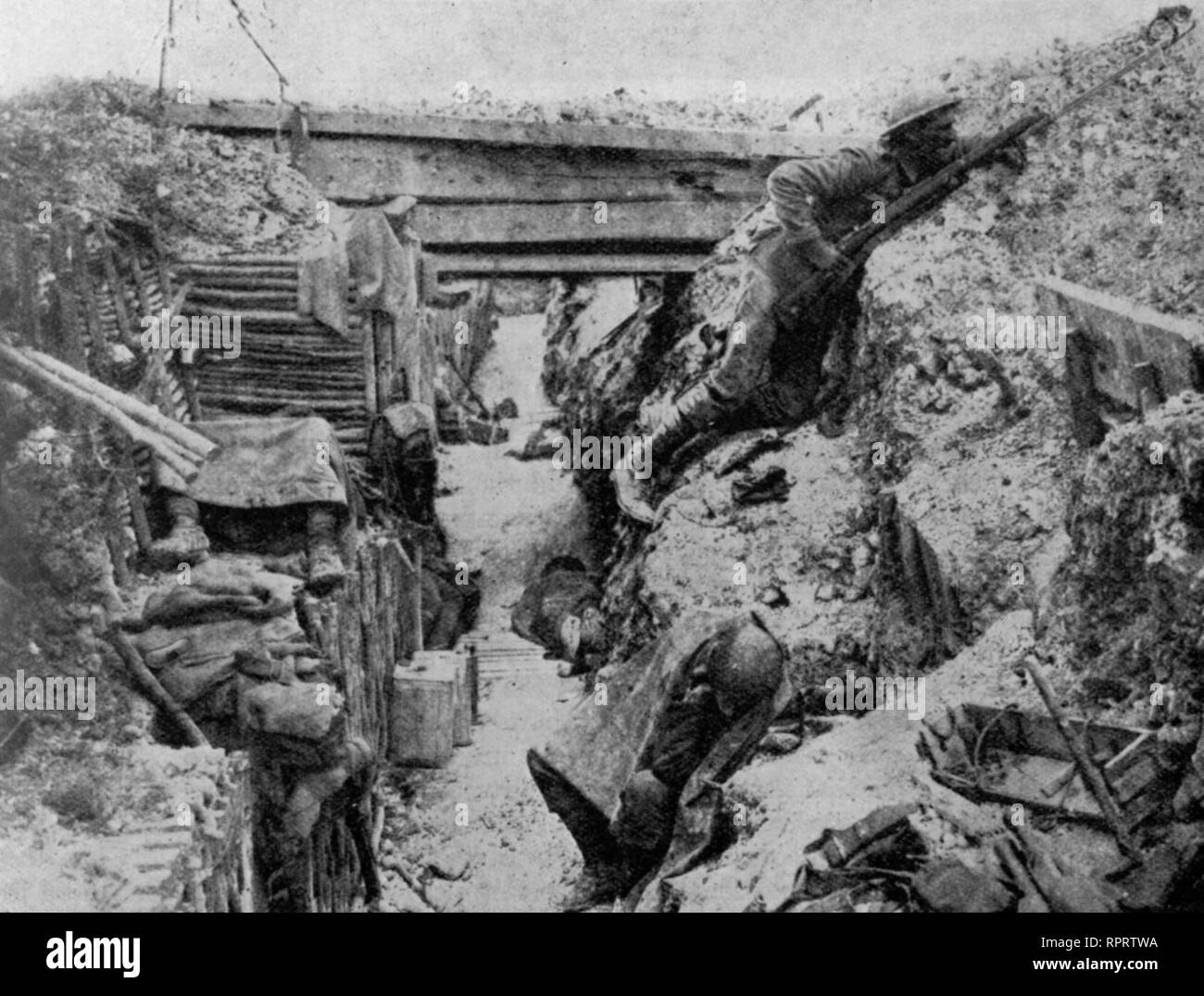 In a front line trench at Ovillers, 1916. The Capture of Ovillers (1-16 July 1916) was a British local operation during the Battle of Albert, the name given by the British to the first two weeks of the Battle of the Somme. Stock Photohttps://www.alamy.com/image-license-details/?v=1https://www.alamy.com/in-a-front-line-trench-at-ovillers-1916-the-capture-of-ovillers-1-16-july-1916-was-a-british-local-operation-during-the-battle-of-albert-the-name-given-by-the-british-to-the-first-two-weeks-of-the-battle-of-the-somme-image237781638.html
In a front line trench at Ovillers, 1916. The Capture of Ovillers (1-16 July 1916) was a British local operation during the Battle of Albert, the name given by the British to the first two weeks of the Battle of the Somme. Stock Photohttps://www.alamy.com/image-license-details/?v=1https://www.alamy.com/in-a-front-line-trench-at-ovillers-1916-the-capture-of-ovillers-1-16-july-1916-was-a-british-local-operation-during-the-battle-of-albert-the-name-given-by-the-british-to-the-first-two-weeks-of-the-battle-of-the-somme-image237781638.htmlRMRPRTWA–In a front line trench at Ovillers, 1916. The Capture of Ovillers (1-16 July 1916) was a British local operation during the Battle of Albert, the name given by the British to the first two weeks of the Battle of the Somme.
 The Sopwith 7F.1 Snipe British single-seat biplane fighter of the Royal Air Force, RAF, during World War One. Stock Photohttps://www.alamy.com/image-license-details/?v=1https://www.alamy.com/stock-photo-the-sopwith-7f1-snipe-british-single-seat-biplane-fighter-of-the-royal-78543114.html
The Sopwith 7F.1 Snipe British single-seat biplane fighter of the Royal Air Force, RAF, during World War One. Stock Photohttps://www.alamy.com/image-license-details/?v=1https://www.alamy.com/stock-photo-the-sopwith-7f1-snipe-british-single-seat-biplane-fighter-of-the-royal-78543114.htmlRMEFNXF6–The Sopwith 7F.1 Snipe British single-seat biplane fighter of the Royal Air Force, RAF, during World War One.
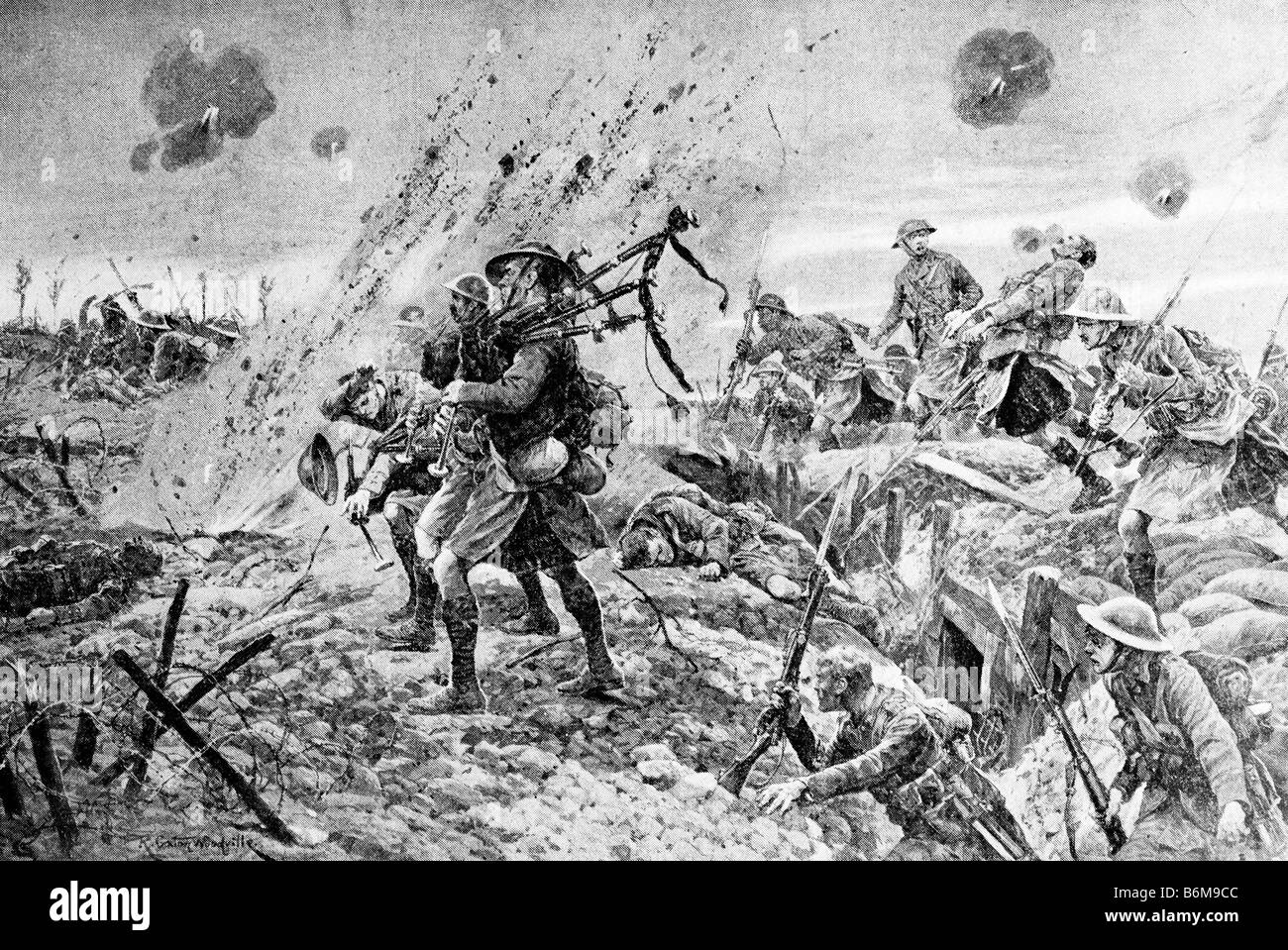 Contemporary World War One illustration of Scottish soldiers playing bagpipes under enemy fire during the Battle of the Somme. Stock Photohttps://www.alamy.com/image-license-details/?v=1https://www.alamy.com/stock-photo-contemporary-world-war-one-illustration-of-scottish-soldiers-playing-21344748.html
Contemporary World War One illustration of Scottish soldiers playing bagpipes under enemy fire during the Battle of the Somme. Stock Photohttps://www.alamy.com/image-license-details/?v=1https://www.alamy.com/stock-photo-contemporary-world-war-one-illustration-of-scottish-soldiers-playing-21344748.htmlRMB6M9CC–Contemporary World War One illustration of Scottish soldiers playing bagpipes under enemy fire during the Battle of the Somme.
 A Belgium Officer in an Armored car during the defense of Antwerp from the book The story of the great war; the complete historical records of events to date DIPLOMATIC AND STATE PAPERS by Reynolds, Francis Joseph, 1867-1937; Churchill, Allen Leon; Miller, Francis Trevelyan, 1877-1959; Wood, Leonard, 1860-1927; Knight, Austin Melvin, 1854-1927; Palmer, Frederick, 1873-1958; Simonds, Frank Herbert, 1878-; Ruhl, Arthur Brown, 1876- Published 1920 Stock Photohttps://www.alamy.com/image-license-details/?v=1https://www.alamy.com/a-belgium-officer-in-an-armored-car-during-the-defense-of-antwerp-from-the-book-the-story-of-the-great-war-the-complete-historical-records-of-events-to-date-diplomatic-and-state-papers-by-reynolds-francis-joseph-1867-1937-churchill-allen-leon-miller-francis-trevelyan-1877-1959-wood-leonard-1860-1927-knight-austin-melvin-1854-1927-palmer-frederick-1873-1958-simonds-frank-herbert-1878-ruhl-arthur-brown-1876-published-1920-image480021597.html
A Belgium Officer in an Armored car during the defense of Antwerp from the book The story of the great war; the complete historical records of events to date DIPLOMATIC AND STATE PAPERS by Reynolds, Francis Joseph, 1867-1937; Churchill, Allen Leon; Miller, Francis Trevelyan, 1877-1959; Wood, Leonard, 1860-1927; Knight, Austin Melvin, 1854-1927; Palmer, Frederick, 1873-1958; Simonds, Frank Herbert, 1878-; Ruhl, Arthur Brown, 1876- Published 1920 Stock Photohttps://www.alamy.com/image-license-details/?v=1https://www.alamy.com/a-belgium-officer-in-an-armored-car-during-the-defense-of-antwerp-from-the-book-the-story-of-the-great-war-the-complete-historical-records-of-events-to-date-diplomatic-and-state-papers-by-reynolds-francis-joseph-1867-1937-churchill-allen-leon-miller-francis-trevelyan-1877-1959-wood-leonard-1860-1927-knight-austin-melvin-1854-1927-palmer-frederick-1873-1958-simonds-frank-herbert-1878-ruhl-arthur-brown-1876-published-1920-image480021597.htmlRF2JTXTCD–A Belgium Officer in an Armored car during the defense of Antwerp from the book The story of the great war; the complete historical records of events to date DIPLOMATIC AND STATE PAPERS by Reynolds, Francis Joseph, 1867-1937; Churchill, Allen Leon; Miller, Francis Trevelyan, 1877-1959; Wood, Leonard, 1860-1927; Knight, Austin Melvin, 1854-1927; Palmer, Frederick, 1873-1958; Simonds, Frank Herbert, 1878-; Ruhl, Arthur Brown, 1876- Published 1920
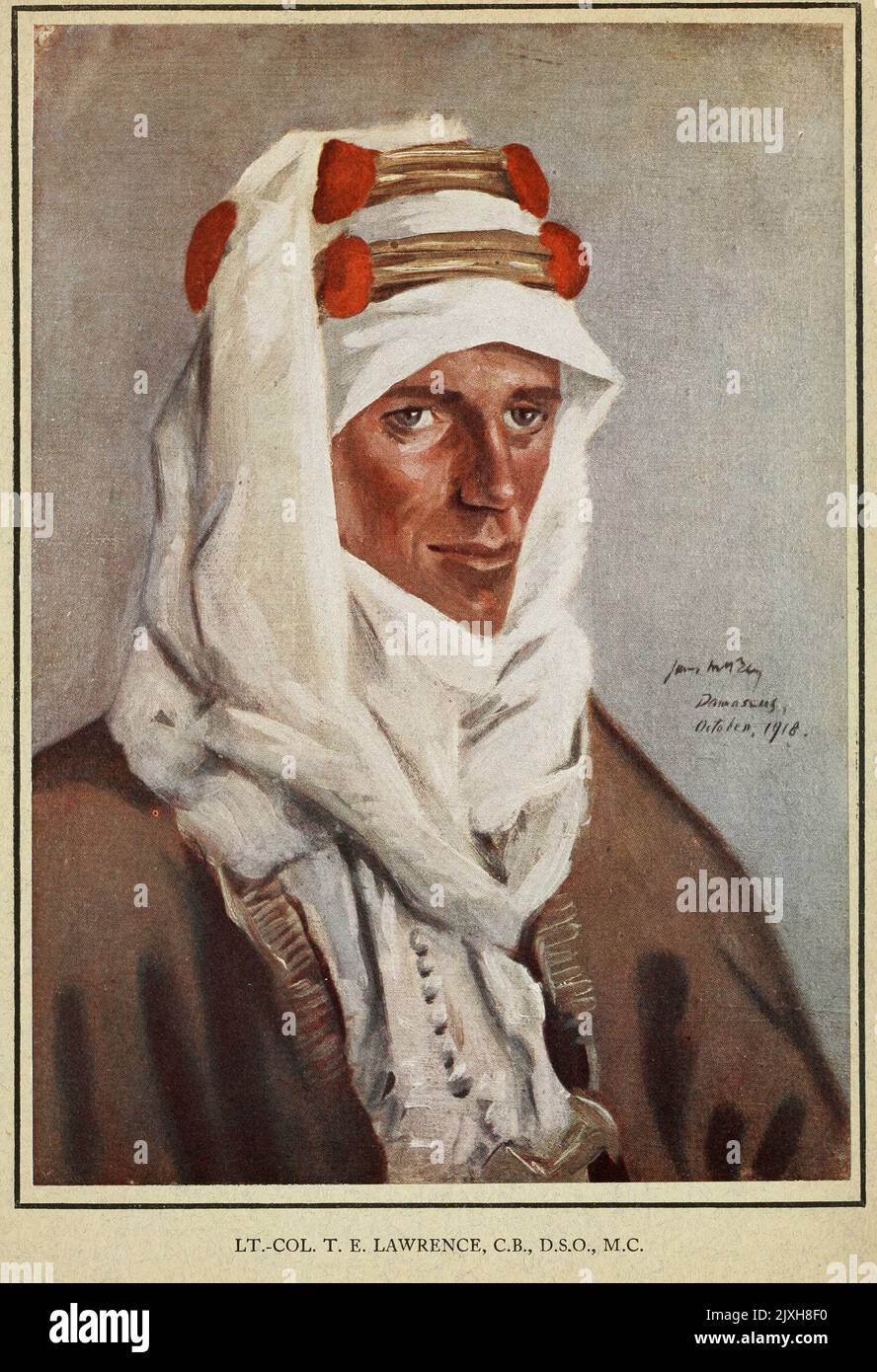 Colonel Thomas Edward Lawrence CB DSO (16 August 1888 – 19 May 1935) was a British archaeologist, army officer, diplomat, and writer, who became renowned for his role in the Arab Revolt (1916–1918) and the Sinai and Palestine Campaign (1915–1918) against the Ottoman Empire during the First World War. The breadth and variety of his activities and associations, and his ability to describe them vividly in writing, earned him international fame as Lawrence of Arabia, a title used for the 1962 film based on his wartime activities. from the book ' NILE TO ALEPPO ' BY HECTOR DINNING CAPTAIN. AUSTRALI Stock Photohttps://www.alamy.com/image-license-details/?v=1https://www.alamy.com/colonel-thomas-edward-lawrence-cb-dso-16-august-1888-19-may-1935-was-a-british-archaeologist-army-officer-diplomat-and-writer-who-became-renowned-for-his-role-in-the-arab-revolt-19161918-and-the-sinai-and-palestine-campaign-19151918-against-the-ottoman-empire-during-the-first-world-war-the-breadth-and-variety-of-his-activities-and-associations-and-his-ability-to-describe-them-vividly-in-writing-earned-him-international-fame-as-lawrence-of-arabia-a-title-used-for-the-1962-film-based-on-his-wartime-activities-from-the-book-nile-to-aleppo-by-hector-dinning-captain-australi-image481040868.html
Colonel Thomas Edward Lawrence CB DSO (16 August 1888 – 19 May 1935) was a British archaeologist, army officer, diplomat, and writer, who became renowned for his role in the Arab Revolt (1916–1918) and the Sinai and Palestine Campaign (1915–1918) against the Ottoman Empire during the First World War. The breadth and variety of his activities and associations, and his ability to describe them vividly in writing, earned him international fame as Lawrence of Arabia, a title used for the 1962 film based on his wartime activities. from the book ' NILE TO ALEPPO ' BY HECTOR DINNING CAPTAIN. AUSTRALI Stock Photohttps://www.alamy.com/image-license-details/?v=1https://www.alamy.com/colonel-thomas-edward-lawrence-cb-dso-16-august-1888-19-may-1935-was-a-british-archaeologist-army-officer-diplomat-and-writer-who-became-renowned-for-his-role-in-the-arab-revolt-19161918-and-the-sinai-and-palestine-campaign-19151918-against-the-ottoman-empire-during-the-first-world-war-the-breadth-and-variety-of-his-activities-and-associations-and-his-ability-to-describe-them-vividly-in-writing-earned-him-international-fame-as-lawrence-of-arabia-a-title-used-for-the-1962-film-based-on-his-wartime-activities-from-the-book-nile-to-aleppo-by-hector-dinning-captain-australi-image481040868.htmlRF2JXH8F0–Colonel Thomas Edward Lawrence CB DSO (16 August 1888 – 19 May 1935) was a British archaeologist, army officer, diplomat, and writer, who became renowned for his role in the Arab Revolt (1916–1918) and the Sinai and Palestine Campaign (1915–1918) against the Ottoman Empire during the First World War. The breadth and variety of his activities and associations, and his ability to describe them vividly in writing, earned him international fame as Lawrence of Arabia, a title used for the 1962 film based on his wartime activities. from the book ' NILE TO ALEPPO ' BY HECTOR DINNING CAPTAIN. AUSTRALI
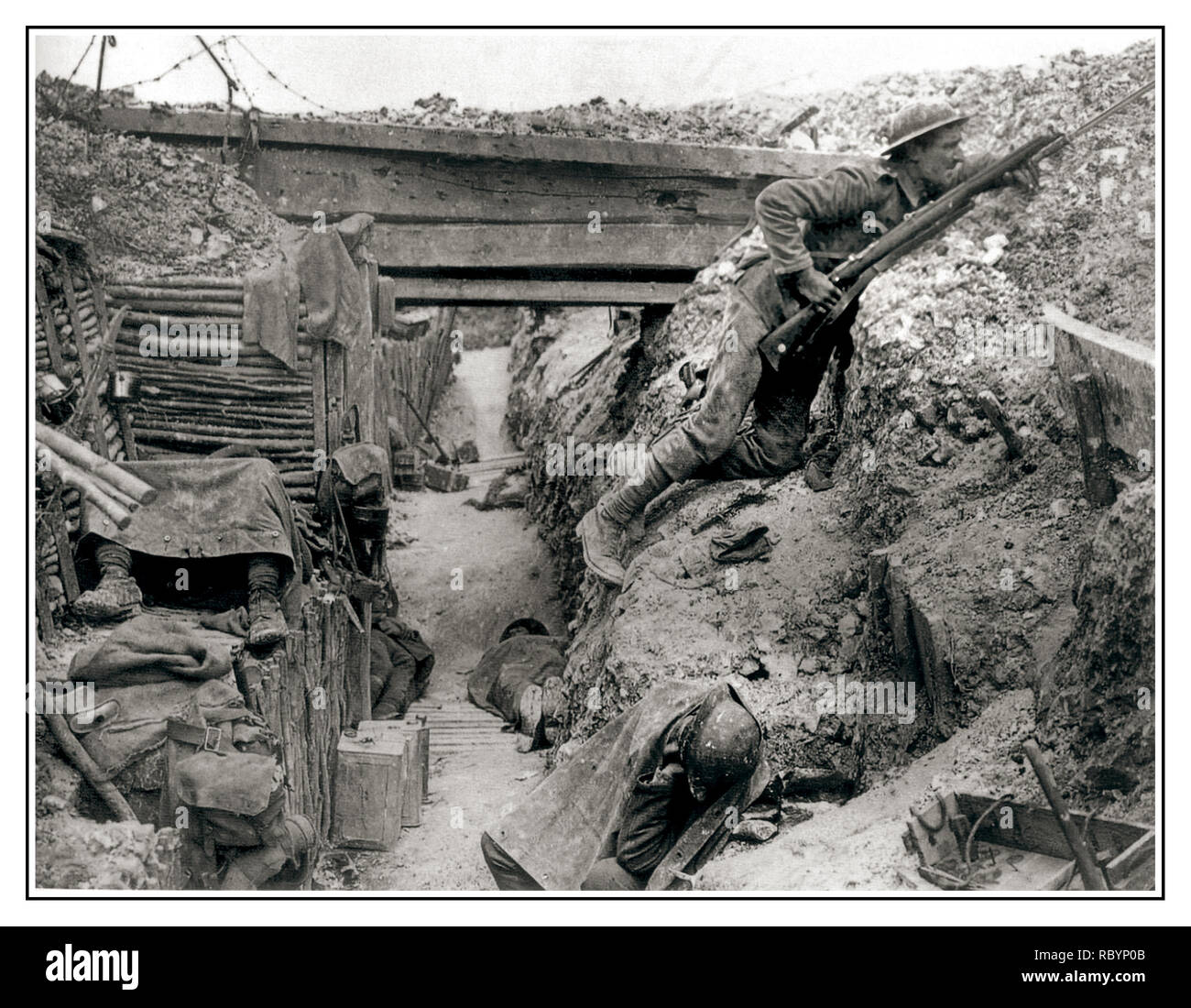 WW1 Battle of The Somme Trenches A German trench now occupied by British Soldiers resting during a lull in fighting near the Albert-Bapaume road at Ovillers-la-Boisselle, July 1916 during the Battle of the Somme. The men are from A Company, 11th Battalion, The Cheshire Regiment. Great Britain UK Stock Photohttps://www.alamy.com/image-license-details/?v=1https://www.alamy.com/ww1-battle-of-the-somme-trenches-a-german-trench-now-occupied-by-british-soldiers-resting-during-a-lull-in-fighting-near-the-albert-bapaume-road-at-ovillers-la-boisselle-july-1916-during-the-battle-of-the-somme-the-men-are-from-a-company-11th-battalion-the-cheshire-regiment-great-britain-uk-image231105963.html
WW1 Battle of The Somme Trenches A German trench now occupied by British Soldiers resting during a lull in fighting near the Albert-Bapaume road at Ovillers-la-Boisselle, July 1916 during the Battle of the Somme. The men are from A Company, 11th Battalion, The Cheshire Regiment. Great Britain UK Stock Photohttps://www.alamy.com/image-license-details/?v=1https://www.alamy.com/ww1-battle-of-the-somme-trenches-a-german-trench-now-occupied-by-british-soldiers-resting-during-a-lull-in-fighting-near-the-albert-bapaume-road-at-ovillers-la-boisselle-july-1916-during-the-battle-of-the-somme-the-men-are-from-a-company-11th-battalion-the-cheshire-regiment-great-britain-uk-image231105963.htmlRMRBYP0B–WW1 Battle of The Somme Trenches A German trench now occupied by British Soldiers resting during a lull in fighting near the Albert-Bapaume road at Ovillers-la-Boisselle, July 1916 during the Battle of the Somme. The men are from A Company, 11th Battalion, The Cheshire Regiment. Great Britain UK
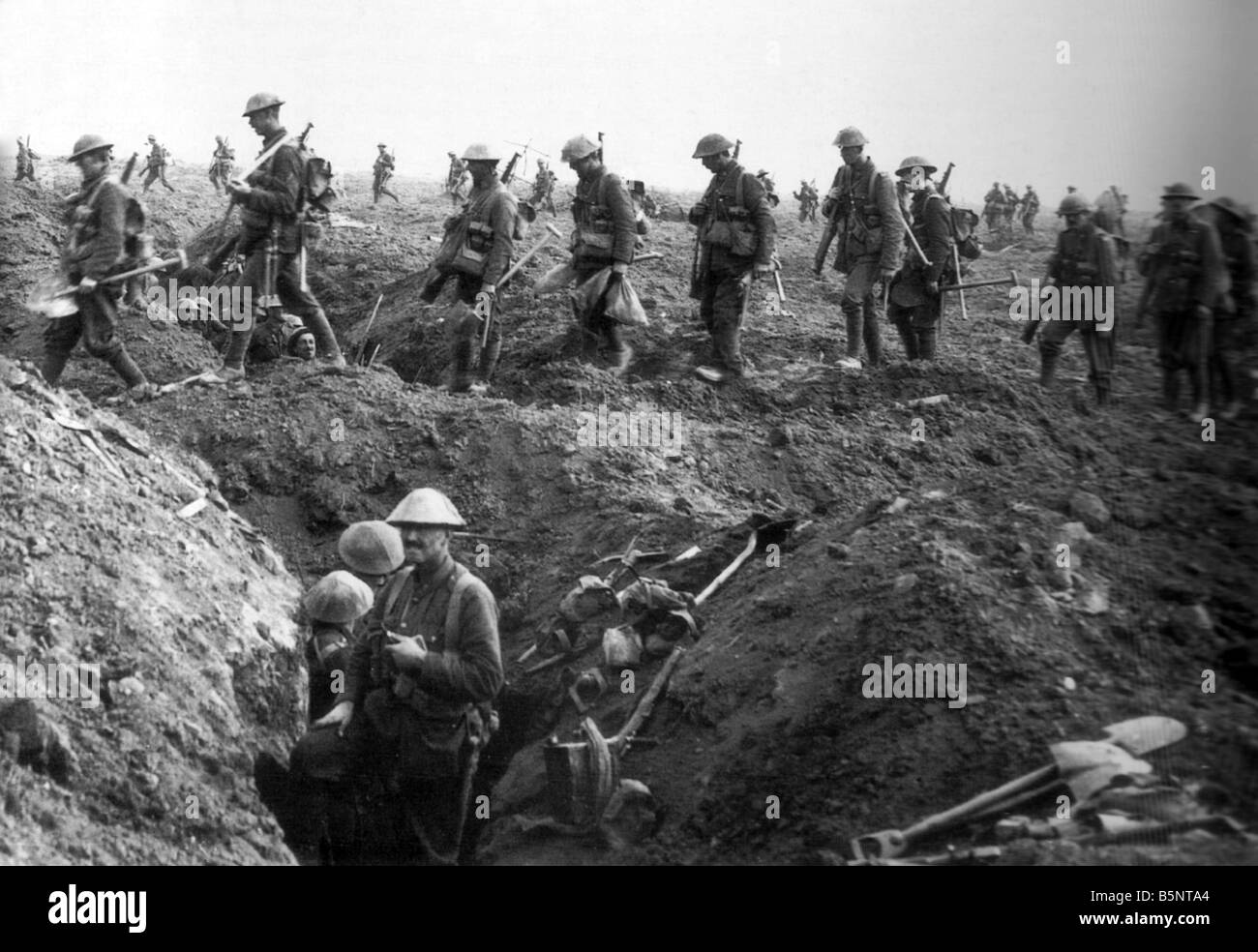 Soldiers in trenches during World War 1 Stock Photohttps://www.alamy.com/image-license-details/?v=1https://www.alamy.com/stock-photo-soldiers-in-trenches-during-world-war-1-20763740.html
Soldiers in trenches during World War 1 Stock Photohttps://www.alamy.com/image-license-details/?v=1https://www.alamy.com/stock-photo-soldiers-in-trenches-during-world-war-1-20763740.htmlRMB5NTA4–Soldiers in trenches during World War 1
 A landscape view over the top of the trenches at Anzac. From a selection of printed photographs first published in 1916. The Gallipoli Campaign began during the Great War on 19 February 1915 and continued until 9 January 1916. This is sometimes referred to as the Dardanelles Campaign, The Battle of Gallipoli and the Defence of Gallipoli. Stock Photohttps://www.alamy.com/image-license-details/?v=1https://www.alamy.com/a-landscape-view-over-the-top-of-the-trenches-at-anzac-from-a-selection-of-printed-photographs-first-published-in-1916-the-gallipoli-campaign-began-during-the-great-war-on-19-february-1915-and-continued-until-9-january-1916-this-is-sometimes-referred-to-as-the-dardanelles-campaign-the-battle-of-gallipoli-and-the-defence-of-gallipoli-image626372231.html
A landscape view over the top of the trenches at Anzac. From a selection of printed photographs first published in 1916. The Gallipoli Campaign began during the Great War on 19 February 1915 and continued until 9 January 1916. This is sometimes referred to as the Dardanelles Campaign, The Battle of Gallipoli and the Defence of Gallipoli. Stock Photohttps://www.alamy.com/image-license-details/?v=1https://www.alamy.com/a-landscape-view-over-the-top-of-the-trenches-at-anzac-from-a-selection-of-printed-photographs-first-published-in-1916-the-gallipoli-campaign-began-during-the-great-war-on-19-february-1915-and-continued-until-9-january-1916-this-is-sometimes-referred-to-as-the-dardanelles-campaign-the-battle-of-gallipoli-and-the-defence-of-gallipoli-image626372231.htmlRM2YB1M4R–A landscape view over the top of the trenches at Anzac. From a selection of printed photographs first published in 1916. The Gallipoli Campaign began during the Great War on 19 February 1915 and continued until 9 January 1916. This is sometimes referred to as the Dardanelles Campaign, The Battle of Gallipoli and the Defence of Gallipoli.
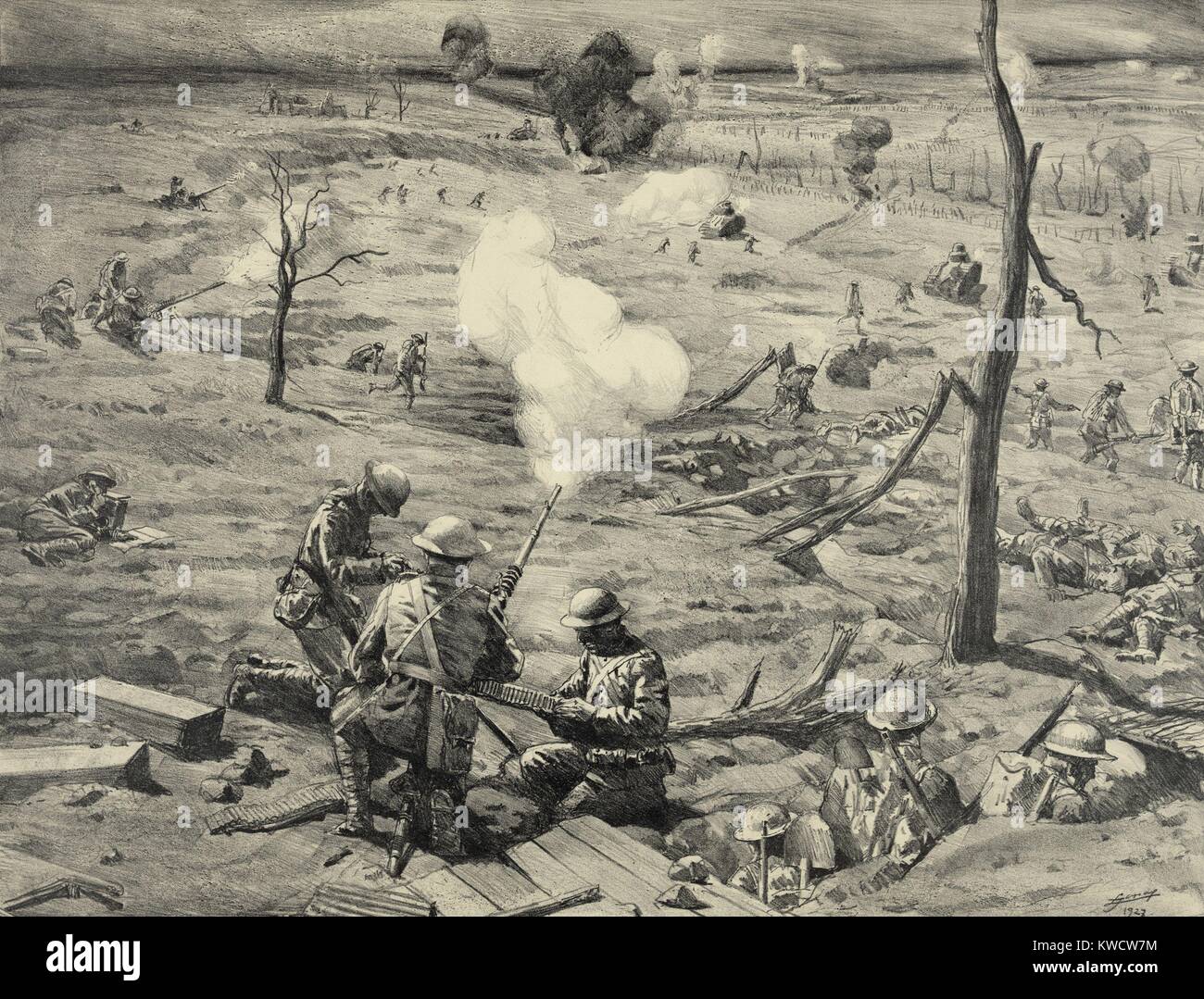 World War 1. Open Attack at St. Mihiel. U.S. troops in action during the Battle of St. Mihiel, Sept. 12-16, 1918. Lithograph by Lucien Jonas, 1927. (BSLOC 2013 1 203) Stock Photohttps://www.alamy.com/image-license-details/?v=1https://www.alamy.com/stock-photo-world-war-1-open-attack-at-st-mihiel-us-troops-in-action-during-the-170542952.html
World War 1. Open Attack at St. Mihiel. U.S. troops in action during the Battle of St. Mihiel, Sept. 12-16, 1918. Lithograph by Lucien Jonas, 1927. (BSLOC 2013 1 203) Stock Photohttps://www.alamy.com/image-license-details/?v=1https://www.alamy.com/stock-photo-world-war-1-open-attack-at-st-mihiel-us-troops-in-action-during-the-170542952.htmlRMKWCW7M–World War 1. Open Attack at St. Mihiel. U.S. troops in action during the Battle of St. Mihiel, Sept. 12-16, 1918. Lithograph by Lucien Jonas, 1927. (BSLOC 2013 1 203)
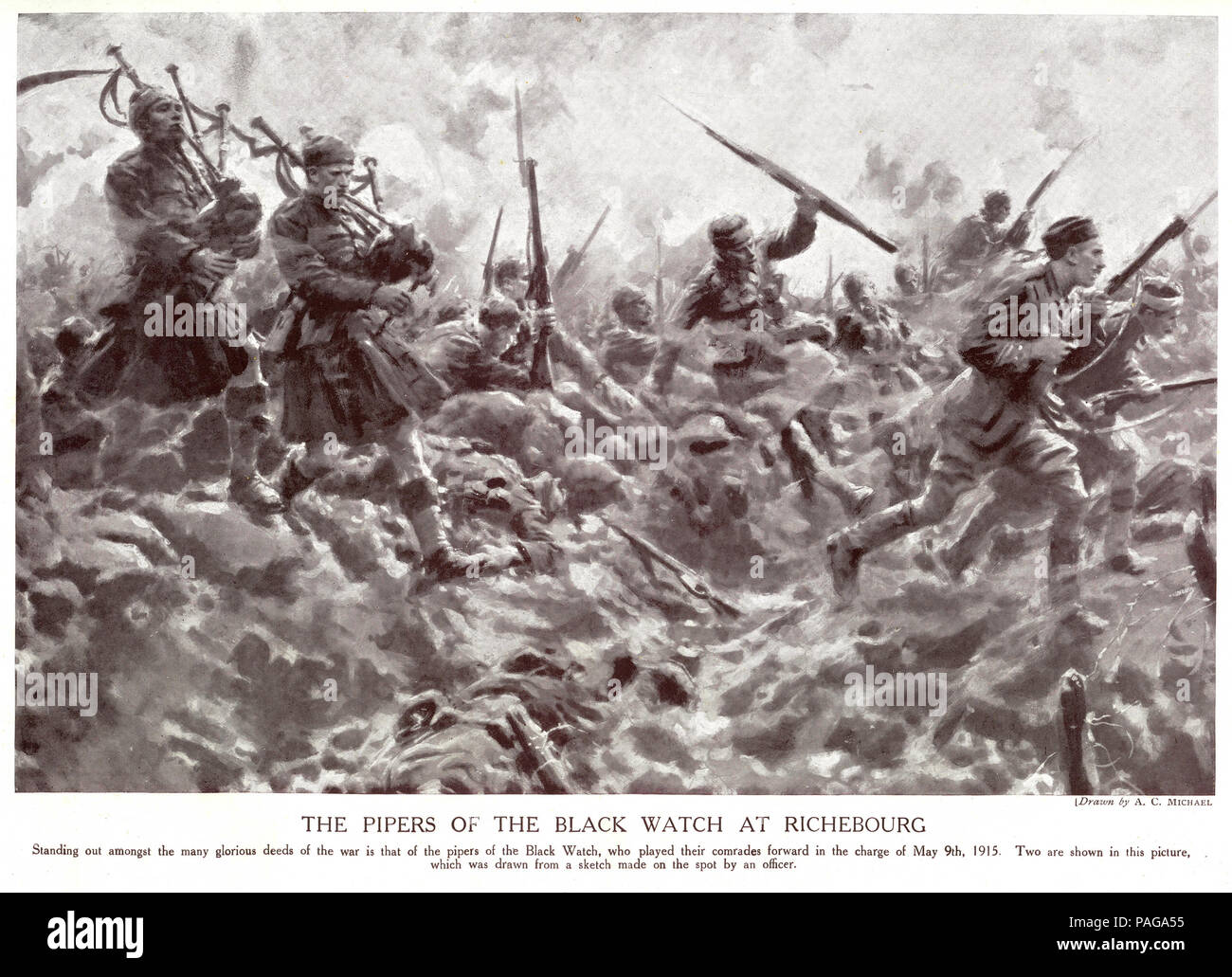 A pair of bagpipers from the Black Watch march their comrades into battle against the Germans on May 9, 1915 during the Great War. From Chums, a weekly adventure magazine for English boys, 1916. Stock Photohttps://www.alamy.com/image-license-details/?v=1https://www.alamy.com/a-pair-of-bagpipers-from-the-black-watch-march-their-comrades-into-battle-against-the-germans-on-may-9-1915-during-the-great-war-from-chums-a-weekly-adventure-magazine-for-english-boys-1916-image213030193.html
A pair of bagpipers from the Black Watch march their comrades into battle against the Germans on May 9, 1915 during the Great War. From Chums, a weekly adventure magazine for English boys, 1916. Stock Photohttps://www.alamy.com/image-license-details/?v=1https://www.alamy.com/a-pair-of-bagpipers-from-the-black-watch-march-their-comrades-into-battle-against-the-germans-on-may-9-1915-during-the-great-war-from-chums-a-weekly-adventure-magazine-for-english-boys-1916-image213030193.htmlRMPAGA55–A pair of bagpipers from the Black Watch march their comrades into battle against the Germans on May 9, 1915 during the Great War. From Chums, a weekly adventure magazine for English boys, 1916.
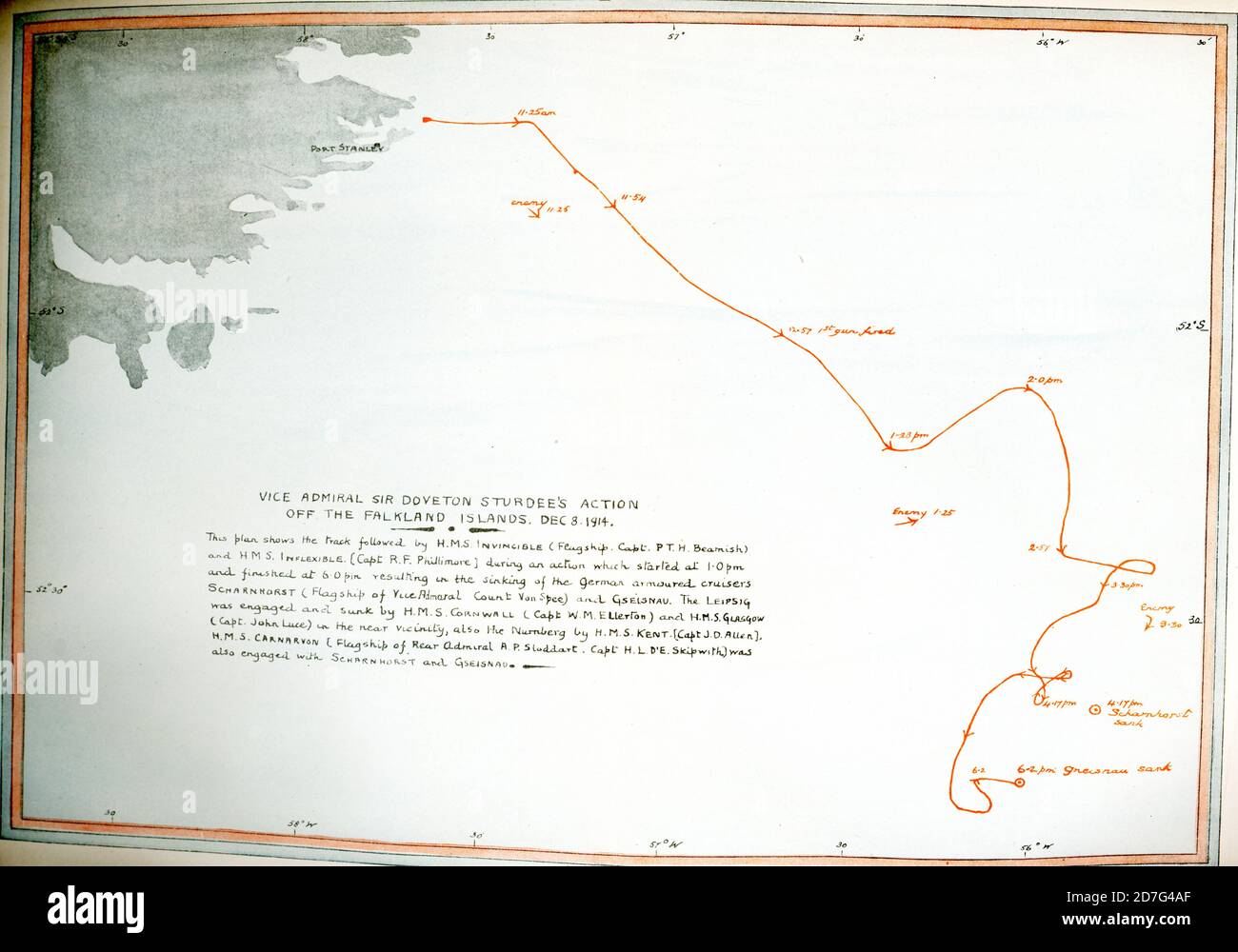 The text box reads: Vice Admiral Sir Doveton Sturdee's Action off Falkland Islands Dec 8 1914. This plan shows the track followed by HMS Invincible (Flagship Capt P T H Beamish) and HMS INflexible (Capt R F Phillimore) during an action which started at 1.0 pm and finished at 6.0 pm resulting in the sinking of the German armoured cruisers Scharnhorst (Flagship of Vice Admiral Count Von Spee) and Gseisnau. The Leipsig was engaged and sunk by HMS Cornwall (Capt W M Ellerton) and HMS Glasgow (Capt John Luce) in the near vicinity, also the Nurnberg by the HMS Kent (Capt J D Allen). HMS Carnarvon (F Stock Photohttps://www.alamy.com/image-license-details/?v=1https://www.alamy.com/the-text-box-reads-vice-admiral-sir-doveton-sturdees-action-off-falkland-islands-dec-8-1914-this-plan-shows-the-track-followed-by-hms-invincible-flagship-capt-p-t-h-beamish-and-hms-inflexible-capt-r-f-phillimore-during-an-action-which-started-at-10-pm-and-finished-at-60-pm-resulting-in-the-sinking-of-the-german-armoured-cruisers-scharnhorst-flagship-of-vice-admiral-count-von-spee-and-gseisnau-the-leipsig-was-engaged-and-sunk-by-hms-cornwall-capt-w-m-ellerton-and-hms-glasgow-capt-john-luce-in-the-near-vicinity-also-the-nurnberg-by-the-hms-kent-capt-j-d-allen-hms-carnarvon-f-image383285351.html
The text box reads: Vice Admiral Sir Doveton Sturdee's Action off Falkland Islands Dec 8 1914. This plan shows the track followed by HMS Invincible (Flagship Capt P T H Beamish) and HMS INflexible (Capt R F Phillimore) during an action which started at 1.0 pm and finished at 6.0 pm resulting in the sinking of the German armoured cruisers Scharnhorst (Flagship of Vice Admiral Count Von Spee) and Gseisnau. The Leipsig was engaged and sunk by HMS Cornwall (Capt W M Ellerton) and HMS Glasgow (Capt John Luce) in the near vicinity, also the Nurnberg by the HMS Kent (Capt J D Allen). HMS Carnarvon (F Stock Photohttps://www.alamy.com/image-license-details/?v=1https://www.alamy.com/the-text-box-reads-vice-admiral-sir-doveton-sturdees-action-off-falkland-islands-dec-8-1914-this-plan-shows-the-track-followed-by-hms-invincible-flagship-capt-p-t-h-beamish-and-hms-inflexible-capt-r-f-phillimore-during-an-action-which-started-at-10-pm-and-finished-at-60-pm-resulting-in-the-sinking-of-the-german-armoured-cruisers-scharnhorst-flagship-of-vice-admiral-count-von-spee-and-gseisnau-the-leipsig-was-engaged-and-sunk-by-hms-cornwall-capt-w-m-ellerton-and-hms-glasgow-capt-john-luce-in-the-near-vicinity-also-the-nurnberg-by-the-hms-kent-capt-j-d-allen-hms-carnarvon-f-image383285351.htmlRF2D7G4AF–The text box reads: Vice Admiral Sir Doveton Sturdee's Action off Falkland Islands Dec 8 1914. This plan shows the track followed by HMS Invincible (Flagship Capt P T H Beamish) and HMS INflexible (Capt R F Phillimore) during an action which started at 1.0 pm and finished at 6.0 pm resulting in the sinking of the German armoured cruisers Scharnhorst (Flagship of Vice Admiral Count Von Spee) and Gseisnau. The Leipsig was engaged and sunk by HMS Cornwall (Capt W M Ellerton) and HMS Glasgow (Capt John Luce) in the near vicinity, also the Nurnberg by the HMS Kent (Capt J D Allen). HMS Carnarvon (F
 Men of the 12th Battalion, Royal Scots wearing respirators during a gas attack on a front line trench, Meteren, 25 June 1918. Stock Photohttps://www.alamy.com/image-license-details/?v=1https://www.alamy.com/men-of-the-12th-battalion-royal-scots-wearing-respirators-during-a-gas-attack-on-a-front-line-trench-meteren-25-june-1918-image463068113.html
Men of the 12th Battalion, Royal Scots wearing respirators during a gas attack on a front line trench, Meteren, 25 June 1918. Stock Photohttps://www.alamy.com/image-license-details/?v=1https://www.alamy.com/men-of-the-12th-battalion-royal-scots-wearing-respirators-during-a-gas-attack-on-a-front-line-trench-meteren-25-june-1918-image463068113.htmlRM2HWAG2W–Men of the 12th Battalion, Royal Scots wearing respirators during a gas attack on a front line trench, Meteren, 25 June 1918.
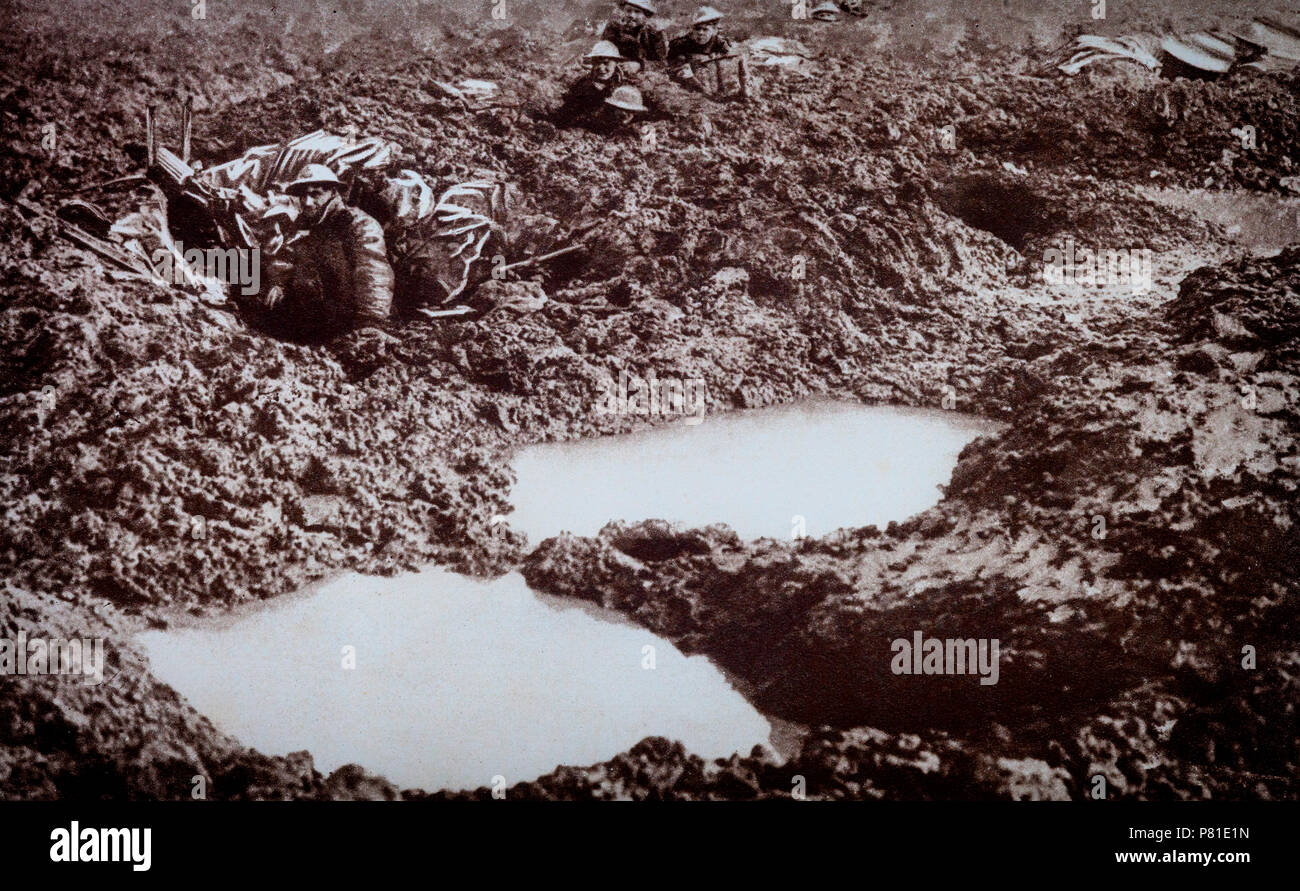 Shocking casualty rates suffered by troops on all sides who were sent “over the top”, during trench warfare but also due to the often horrific conditions the men endured whilst living in the trenches. Aside from the danger of enemy attacks, soldiers in the trenches faced other challenges. Trenches frequently became waterlogged and particularly heavy storms could lead to flooding. On the Western Front in the winter of 1915 the trenches became so wet that in one sector German soldiers reportedly began sitting on top of the trench walls just to dry off and avoid such nasty ailments. Stock Photohttps://www.alamy.com/image-license-details/?v=1https://www.alamy.com/shocking-casualty-rates-suffered-by-troops-on-all-sides-who-were-sent-over-the-top-during-trench-warfare-but-also-due-to-the-often-horrific-conditions-the-men-endured-whilst-living-in-the-trenches-aside-from-the-danger-of-enemy-attacks-soldiers-in-the-trenches-faced-other-challenges-trenches-frequently-became-waterlogged-and-particularly-heavy-storms-could-lead-to-flooding-on-the-western-front-in-the-winter-of-1915-the-trenches-became-so-wet-that-in-one-sector-german-soldiers-reportedly-began-sitting-on-top-of-the-trench-walls-just-to-dry-off-and-avoid-such-nasty-ailments-image211474641.html
Shocking casualty rates suffered by troops on all sides who were sent “over the top”, during trench warfare but also due to the often horrific conditions the men endured whilst living in the trenches. Aside from the danger of enemy attacks, soldiers in the trenches faced other challenges. Trenches frequently became waterlogged and particularly heavy storms could lead to flooding. On the Western Front in the winter of 1915 the trenches became so wet that in one sector German soldiers reportedly began sitting on top of the trench walls just to dry off and avoid such nasty ailments. Stock Photohttps://www.alamy.com/image-license-details/?v=1https://www.alamy.com/shocking-casualty-rates-suffered-by-troops-on-all-sides-who-were-sent-over-the-top-during-trench-warfare-but-also-due-to-the-often-horrific-conditions-the-men-endured-whilst-living-in-the-trenches-aside-from-the-danger-of-enemy-attacks-soldiers-in-the-trenches-faced-other-challenges-trenches-frequently-became-waterlogged-and-particularly-heavy-storms-could-lead-to-flooding-on-the-western-front-in-the-winter-of-1915-the-trenches-became-so-wet-that-in-one-sector-german-soldiers-reportedly-began-sitting-on-top-of-the-trench-walls-just-to-dry-off-and-avoid-such-nasty-ailments-image211474641.htmlRMP81E1N–Shocking casualty rates suffered by troops on all sides who were sent “over the top”, during trench warfare but also due to the often horrific conditions the men endured whilst living in the trenches. Aside from the danger of enemy attacks, soldiers in the trenches faced other challenges. Trenches frequently became waterlogged and particularly heavy storms could lead to flooding. On the Western Front in the winter of 1915 the trenches became so wet that in one sector German soldiers reportedly began sitting on top of the trench walls just to dry off and avoid such nasty ailments.
 British prisoners in Germany being taken to prisoner-of-war camps after battles in the Somme during World War I. Photo from Bain News Service, 1916 Stock Photohttps://www.alamy.com/image-license-details/?v=1https://www.alamy.com/stock-photo-british-prisoners-in-germany-being-taken-to-prisoner-of-war-camps-98059856.html
British prisoners in Germany being taken to prisoner-of-war camps after battles in the Somme during World War I. Photo from Bain News Service, 1916 Stock Photohttps://www.alamy.com/image-license-details/?v=1https://www.alamy.com/stock-photo-british-prisoners-in-germany-being-taken-to-prisoner-of-war-camps-98059856.htmlRMFKF09M–British prisoners in Germany being taken to prisoner-of-war camps after battles in the Somme during World War I. Photo from Bain News Service, 1916
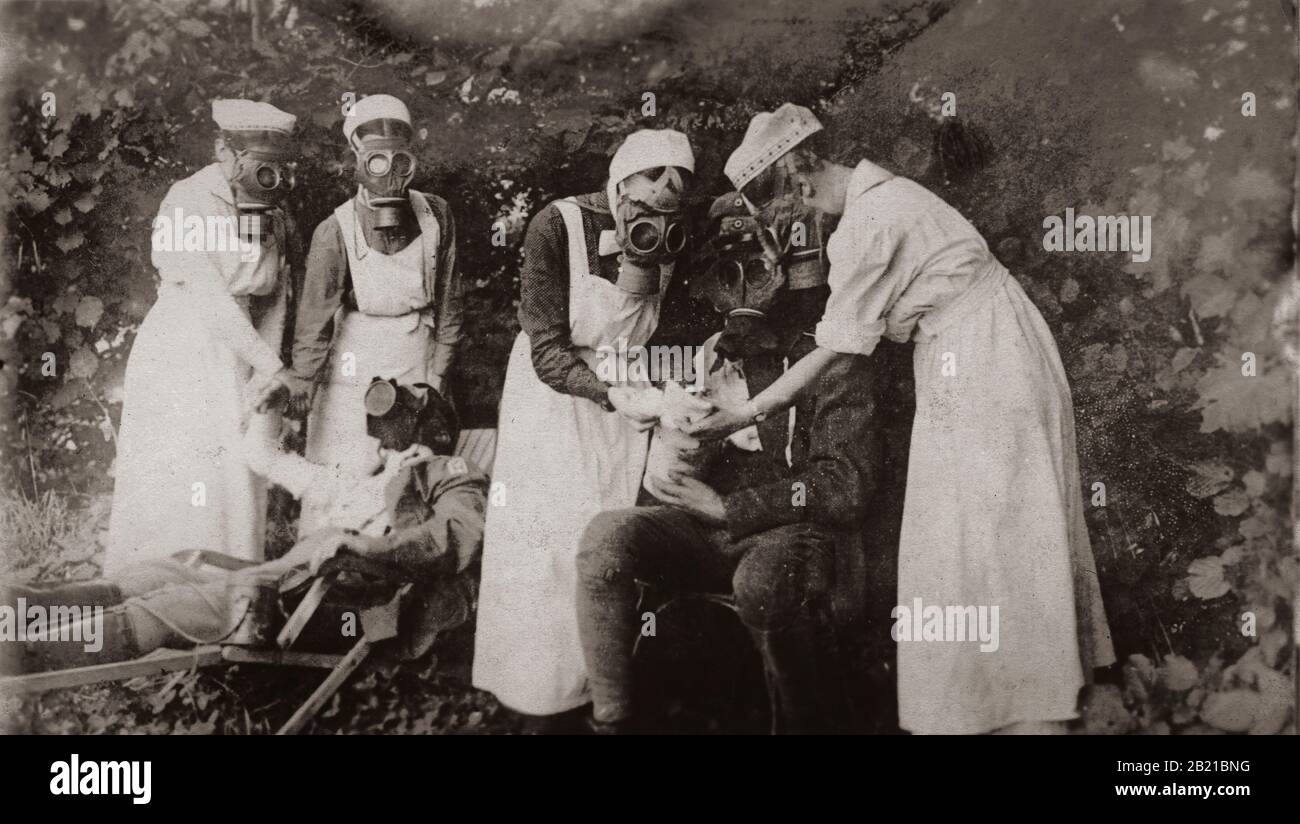 Nurses in gas masks assist troops in the trenches during World War 1. Stock Photohttps://www.alamy.com/image-license-details/?v=1https://www.alamy.com/nurses-in-gas-masks-assist-troops-in-the-trenches-during-world-war-1-image345467852.html
Nurses in gas masks assist troops in the trenches during World War 1. Stock Photohttps://www.alamy.com/image-license-details/?v=1https://www.alamy.com/nurses-in-gas-masks-assist-troops-in-the-trenches-during-world-war-1-image345467852.htmlRF2B21BNG–Nurses in gas masks assist troops in the trenches during World War 1.
 This historic World War I photograph shows soldiers in the field setting up or operating a gas gun, a specialized artillery piece used to launch gas shells during the war. Their uniforms, equipment, and rugged outdoor environment provide a rare glimpse into the use of chemical weapons on the battlefield. The image highlights the challenging conditions and evolving military technology of the early 20th century, capturing a unique and somber aspect of World War I warfare. Stock Photohttps://www.alamy.com/image-license-details/?v=1https://www.alamy.com/this-historic-world-war-i-photograph-shows-soldiers-in-the-field-setting-up-or-operating-a-gas-gun-a-specialized-artillery-piece-used-to-launch-gas-shells-during-the-war-their-uniforms-equipment-and-rugged-outdoor-environment-provide-a-rare-glimpse-into-the-use-of-chemical-weapons-on-the-battlefield-the-image-highlights-the-challenging-conditions-and-evolving-military-technology-of-the-early-20th-century-capturing-a-unique-and-somber-aspect-of-world-war-i-warfare-image629812592.html
This historic World War I photograph shows soldiers in the field setting up or operating a gas gun, a specialized artillery piece used to launch gas shells during the war. Their uniforms, equipment, and rugged outdoor environment provide a rare glimpse into the use of chemical weapons on the battlefield. The image highlights the challenging conditions and evolving military technology of the early 20th century, capturing a unique and somber aspect of World War I warfare. Stock Photohttps://www.alamy.com/image-license-details/?v=1https://www.alamy.com/this-historic-world-war-i-photograph-shows-soldiers-in-the-field-setting-up-or-operating-a-gas-gun-a-specialized-artillery-piece-used-to-launch-gas-shells-during-the-war-their-uniforms-equipment-and-rugged-outdoor-environment-provide-a-rare-glimpse-into-the-use-of-chemical-weapons-on-the-battlefield-the-image-highlights-the-challenging-conditions-and-evolving-military-technology-of-the-early-20th-century-capturing-a-unique-and-somber-aspect-of-world-war-i-warfare-image629812592.htmlRF2YGJCAT–This historic World War I photograph shows soldiers in the field setting up or operating a gas gun, a specialized artillery piece used to launch gas shells during the war. Their uniforms, equipment, and rugged outdoor environment provide a rare glimpse into the use of chemical weapons on the battlefield. The image highlights the challenging conditions and evolving military technology of the early 20th century, capturing a unique and somber aspect of World War I warfare.
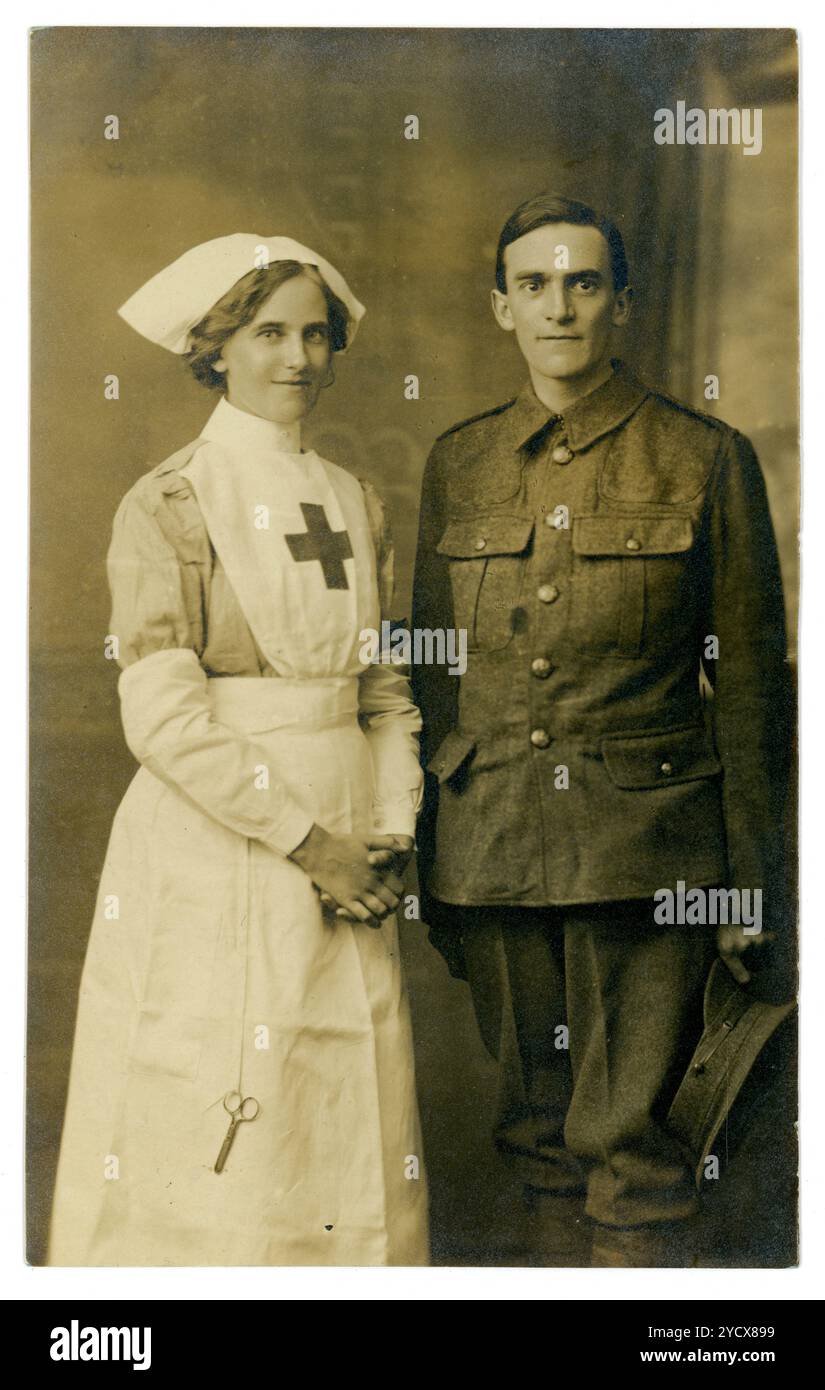 Original WW1 era postcard of a couple serving their country during the Great War - a soldier and a red cross nurse, perhaps husband and wife, fiance fiances, brother and sister ? Postcard from the studio of W H Bayliss, 49 Wilbraham Rd. Chorlton, near Manchester, Cheshire, U.K. Stock Photohttps://www.alamy.com/image-license-details/?v=1https://www.alamy.com/original-ww1-era-postcard-of-a-couple-serving-their-country-during-the-great-war-a-soldier-and-a-red-cross-nurse-perhaps-husband-and-wife-fiance-fiances-brother-and-sister-postcard-from-the-studio-of-w-h-bayliss-49-wilbraham-rd-chorlton-near-manchester-cheshire-uk-image627526405.html
Original WW1 era postcard of a couple serving their country during the Great War - a soldier and a red cross nurse, perhaps husband and wife, fiance fiances, brother and sister ? Postcard from the studio of W H Bayliss, 49 Wilbraham Rd. Chorlton, near Manchester, Cheshire, U.K. Stock Photohttps://www.alamy.com/image-license-details/?v=1https://www.alamy.com/original-ww1-era-postcard-of-a-couple-serving-their-country-during-the-great-war-a-soldier-and-a-red-cross-nurse-perhaps-husband-and-wife-fiance-fiances-brother-and-sister-postcard-from-the-studio-of-w-h-bayliss-49-wilbraham-rd-chorlton-near-manchester-cheshire-uk-image627526405.htmlRM2YCX899–Original WW1 era postcard of a couple serving their country during the Great War - a soldier and a red cross nurse, perhaps husband and wife, fiance fiances, brother and sister ? Postcard from the studio of W H Bayliss, 49 Wilbraham Rd. Chorlton, near Manchester, Cheshire, U.K.
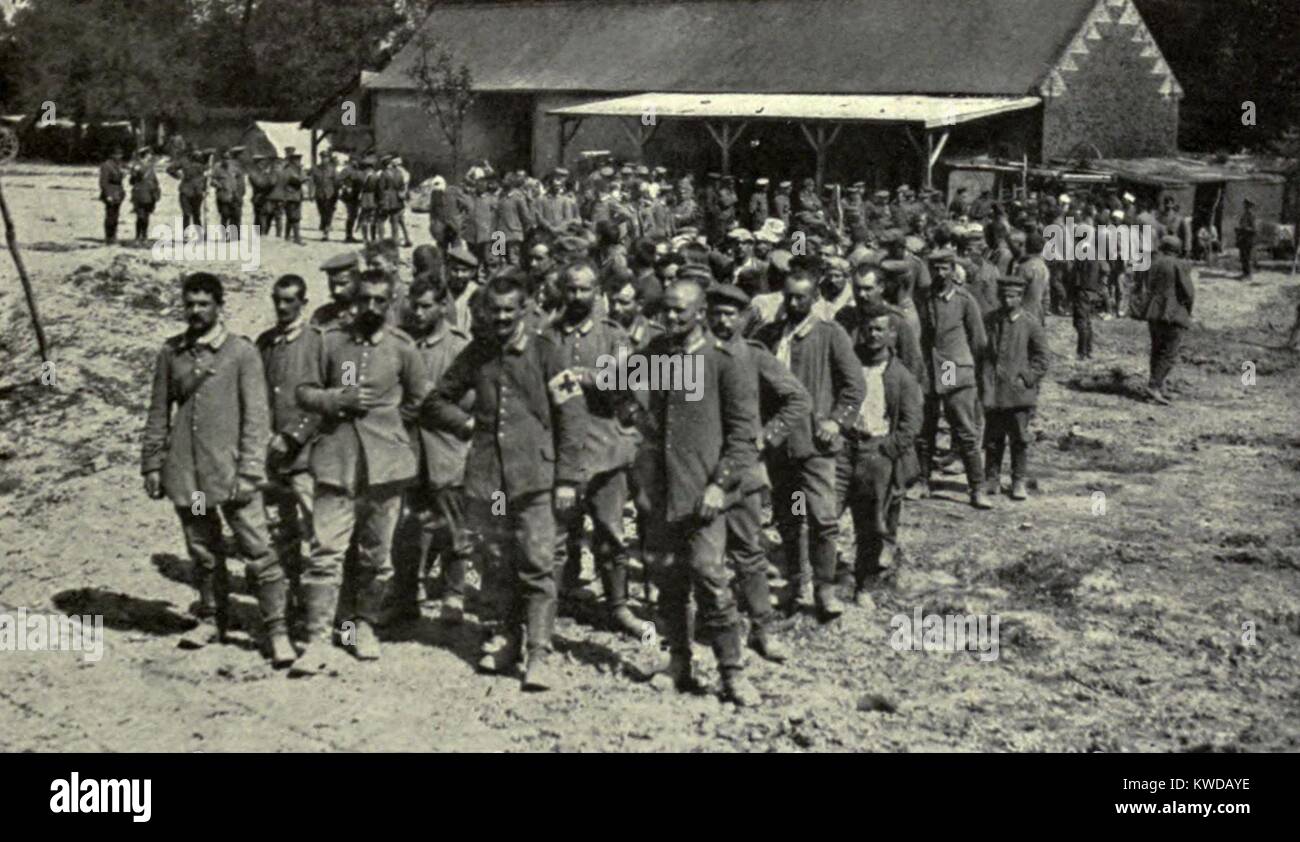 World War 1. Somme Offensive. German prisoners captured by the British during the Somme Offensive, at Meaulte, near Albert. July 1916. (BSLOC 2013 1 118) Stock Photohttps://www.alamy.com/image-license-details/?v=1https://www.alamy.com/stock-photo-world-war-1-somme-offensive-german-prisoners-captured-by-the-british-170553698.html
World War 1. Somme Offensive. German prisoners captured by the British during the Somme Offensive, at Meaulte, near Albert. July 1916. (BSLOC 2013 1 118) Stock Photohttps://www.alamy.com/image-license-details/?v=1https://www.alamy.com/stock-photo-world-war-1-somme-offensive-german-prisoners-captured-by-the-british-170553698.htmlRMKWDAYE–World War 1. Somme Offensive. German prisoners captured by the British during the Somme Offensive, at Meaulte, near Albert. July 1916. (BSLOC 2013 1 118)
 Vintage photo circa 1943 of US Navy Lockheed PV-1 Ventura on patrol over the Atlantic Ocean scouting for German enemy submarines or U-Boats during world war two Stock Photohttps://www.alamy.com/image-license-details/?v=1https://www.alamy.com/vintage-photo-circa-1943-of-us-navy-lockheed-pv-1-ventura-on-patrol-over-the-atlantic-ocean-scouting-for-german-enemy-submarines-or-u-boats-during-world-war-two-image508129052.html
Vintage photo circa 1943 of US Navy Lockheed PV-1 Ventura on patrol over the Atlantic Ocean scouting for German enemy submarines or U-Boats during world war two Stock Photohttps://www.alamy.com/image-license-details/?v=1https://www.alamy.com/vintage-photo-circa-1943-of-us-navy-lockheed-pv-1-ventura-on-patrol-over-the-atlantic-ocean-scouting-for-german-enemy-submarines-or-u-boats-during-world-war-two-image508129052.htmlRF2MEK7P4–Vintage photo circa 1943 of US Navy Lockheed PV-1 Ventura on patrol over the Atlantic Ocean scouting for German enemy submarines or U-Boats during world war two
 A Sopwith 1½ Strutter taking off from a platform fitted to the guns of a British warship during WWI. From Wings of War, published 1942. Stock Photohttps://www.alamy.com/image-license-details/?v=1https://www.alamy.com/a-sopwith-1-strutter-taking-off-from-a-platform-fitted-to-the-guns-of-a-british-warship-during-wwi-from-wings-of-war-published-1942-image626993239.html
A Sopwith 1½ Strutter taking off from a platform fitted to the guns of a British warship during WWI. From Wings of War, published 1942. Stock Photohttps://www.alamy.com/image-license-details/?v=1https://www.alamy.com/a-sopwith-1-strutter-taking-off-from-a-platform-fitted-to-the-guns-of-a-british-warship-during-wwi-from-wings-of-war-published-1942-image626993239.htmlRM2YC207K–A Sopwith 1½ Strutter taking off from a platform fitted to the guns of a British warship during WWI. From Wings of War, published 1942.
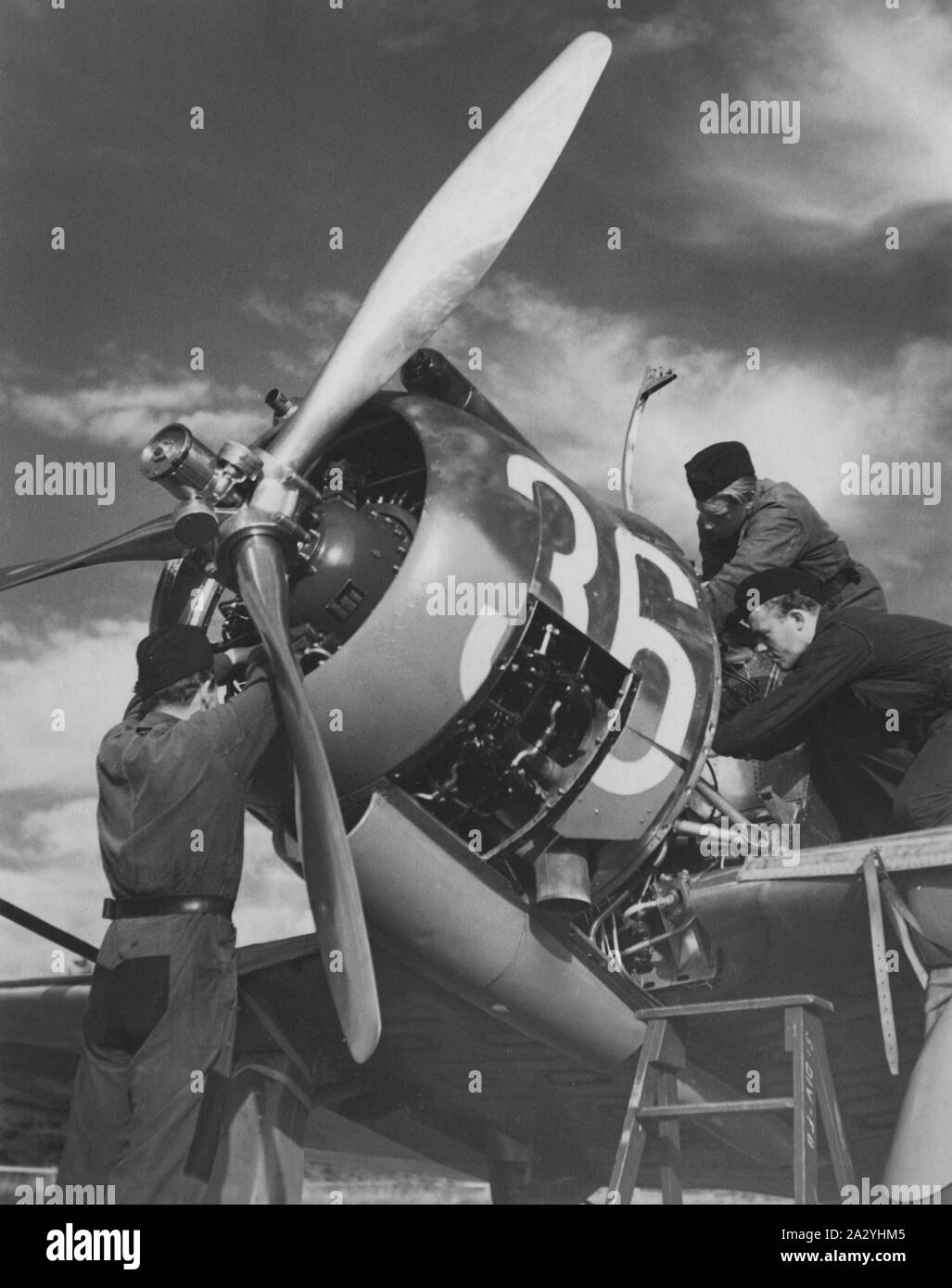 Airplane engineers.Three mechanics are performing the important last minute check of engine details before start. The airplane is a swedish single propeller engine light bomb and survaillance unit model B5. The swedish company Saab Svenska Aeroplan AB produced this airplane on license from American Northrop and their model 8A-1. Picture taken in the 1940s during the second world war. Stock Photohttps://www.alamy.com/image-license-details/?v=1https://www.alamy.com/airplane-engineersthree-mechanics-are-performing-the-important-last-minute-check-of-engine-details-before-start-the-airplane-is-a-swedish-single-propeller-engine-light-bomb-and-survaillance-unit-model-b5-the-swedish-company-saab-svenska-aeroplan-ab-produced-this-airplane-on-license-from-american-northrop-and-their-model-8a-1-picture-taken-in-the-1940s-during-the-second-world-war-image328832901.html
Airplane engineers.Three mechanics are performing the important last minute check of engine details before start. The airplane is a swedish single propeller engine light bomb and survaillance unit model B5. The swedish company Saab Svenska Aeroplan AB produced this airplane on license from American Northrop and their model 8A-1. Picture taken in the 1940s during the second world war. Stock Photohttps://www.alamy.com/image-license-details/?v=1https://www.alamy.com/airplane-engineersthree-mechanics-are-performing-the-important-last-minute-check-of-engine-details-before-start-the-airplane-is-a-swedish-single-propeller-engine-light-bomb-and-survaillance-unit-model-b5-the-swedish-company-saab-svenska-aeroplan-ab-produced-this-airplane-on-license-from-american-northrop-and-their-model-8a-1-picture-taken-in-the-1940s-during-the-second-world-war-image328832901.htmlRM2A2YHM5–Airplane engineers.Three mechanics are performing the important last minute check of engine details before start. The airplane is a swedish single propeller engine light bomb and survaillance unit model B5. The swedish company Saab Svenska Aeroplan AB produced this airplane on license from American Northrop and their model 8A-1. Picture taken in the 1940s during the second world war.
 Entitled: Marching in along a camouflaged road. Sketch shows troops marching in a war-torn landscape during World War I by Lucien Jonas. In France, the heavy losses in manpower at the front decimated an entire generation of Frenchmen and is thought to hav Stock Photohttps://www.alamy.com/image-license-details/?v=1https://www.alamy.com/stock-photo-entitled-marching-in-along-a-camouflaged-road-sketch-shows-troops-104017349.html
Entitled: Marching in along a camouflaged road. Sketch shows troops marching in a war-torn landscape during World War I by Lucien Jonas. In France, the heavy losses in manpower at the front decimated an entire generation of Frenchmen and is thought to hav Stock Photohttps://www.alamy.com/image-license-details/?v=1https://www.alamy.com/stock-photo-entitled-marching-in-along-a-camouflaged-road-sketch-shows-troops-104017349.htmlRMG16B59–Entitled: Marching in along a camouflaged road. Sketch shows troops marching in a war-torn landscape during World War I by Lucien Jonas. In France, the heavy losses in manpower at the front decimated an entire generation of Frenchmen and is thought to hav
 Contemporary WW1 illustration of Australian troops capturing a German machine-gun position during the 1916 Battle of Pozieres. Stock Photohttps://www.alamy.com/image-license-details/?v=1https://www.alamy.com/stock-photo-contemporary-ww1-illustration-of-australian-troops-capturing-a-german-27095181.html
Contemporary WW1 illustration of Australian troops capturing a German machine-gun position during the 1916 Battle of Pozieres. Stock Photohttps://www.alamy.com/image-license-details/?v=1https://www.alamy.com/stock-photo-contemporary-ww1-illustration-of-australian-troops-capturing-a-german-27095181.htmlRMBG2851–Contemporary WW1 illustration of Australian troops capturing a German machine-gun position during the 1916 Battle of Pozieres.
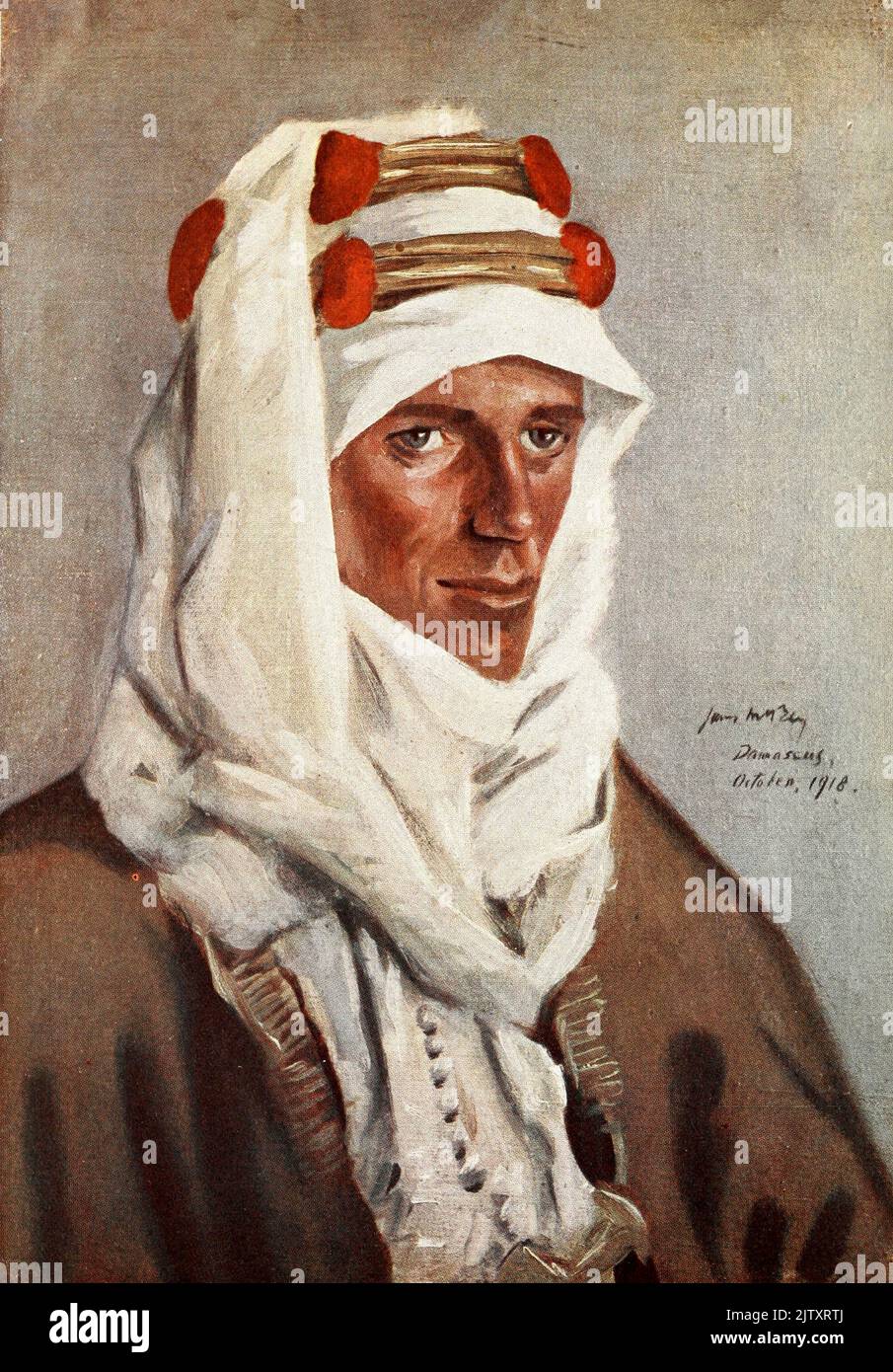 Colonel Thomas Edward Lawrence CB DSO (16 August 1888 – 19 May 1935) was a British archaeologist, army officer, diplomat, and writer, who became renowned for his role in the Arab Revolt (1916–1918) and the Sinai and Palestine Campaign (1915–1918) against the Ottoman Empire during the First World War. The breadth and variety of his activities and associations, and his ability to describe them vividly in writing, earned him international fame as Lawrence of Arabia, a title used for the 1962 film based on his wartime activities. from the book ' NILE TO ALEPPO ' BY HECTOR DINNING CAPTAIN. AUSTRALI Stock Photohttps://www.alamy.com/image-license-details/?v=1https://www.alamy.com/colonel-thomas-edward-lawrence-cb-dso-16-august-1888-19-may-1935-was-a-british-archaeologist-army-officer-diplomat-and-writer-who-became-renowned-for-his-role-in-the-arab-revolt-19161918-and-the-sinai-and-palestine-campaign-19151918-against-the-ottoman-empire-during-the-first-world-war-the-breadth-and-variety-of-his-activities-and-associations-and-his-ability-to-describe-them-vividly-in-writing-earned-him-international-fame-as-lawrence-of-arabia-a-title-used-for-the-1962-film-based-on-his-wartime-activities-from-the-book-nile-to-aleppo-by-hector-dinning-captain-australi-image480021154.html
Colonel Thomas Edward Lawrence CB DSO (16 August 1888 – 19 May 1935) was a British archaeologist, army officer, diplomat, and writer, who became renowned for his role in the Arab Revolt (1916–1918) and the Sinai and Palestine Campaign (1915–1918) against the Ottoman Empire during the First World War. The breadth and variety of his activities and associations, and his ability to describe them vividly in writing, earned him international fame as Lawrence of Arabia, a title used for the 1962 film based on his wartime activities. from the book ' NILE TO ALEPPO ' BY HECTOR DINNING CAPTAIN. AUSTRALI Stock Photohttps://www.alamy.com/image-license-details/?v=1https://www.alamy.com/colonel-thomas-edward-lawrence-cb-dso-16-august-1888-19-may-1935-was-a-british-archaeologist-army-officer-diplomat-and-writer-who-became-renowned-for-his-role-in-the-arab-revolt-19161918-and-the-sinai-and-palestine-campaign-19151918-against-the-ottoman-empire-during-the-first-world-war-the-breadth-and-variety-of-his-activities-and-associations-and-his-ability-to-describe-them-vividly-in-writing-earned-him-international-fame-as-lawrence-of-arabia-a-title-used-for-the-1962-film-based-on-his-wartime-activities-from-the-book-nile-to-aleppo-by-hector-dinning-captain-australi-image480021154.htmlRF2JTXRTJ–Colonel Thomas Edward Lawrence CB DSO (16 August 1888 – 19 May 1935) was a British archaeologist, army officer, diplomat, and writer, who became renowned for his role in the Arab Revolt (1916–1918) and the Sinai and Palestine Campaign (1915–1918) against the Ottoman Empire during the First World War. The breadth and variety of his activities and associations, and his ability to describe them vividly in writing, earned him international fame as Lawrence of Arabia, a title used for the 1962 film based on his wartime activities. from the book ' NILE TO ALEPPO ' BY HECTOR DINNING CAPTAIN. AUSTRALI
 fighting German U-boats during the Great War Illustration by Charles Murray Padday Stock Photohttps://www.alamy.com/image-license-details/?v=1https://www.alamy.com/fighting-german-u-boats-during-the-great-war-illustration-by-charles-murray-padday-image611364065.html
fighting German U-boats during the Great War Illustration by Charles Murray Padday Stock Photohttps://www.alamy.com/image-license-details/?v=1https://www.alamy.com/fighting-german-u-boats-during-the-great-war-illustration-by-charles-murray-padday-image611364065.htmlRM2XEJ12W–fighting German U-boats during the Great War Illustration by Charles Murray Padday
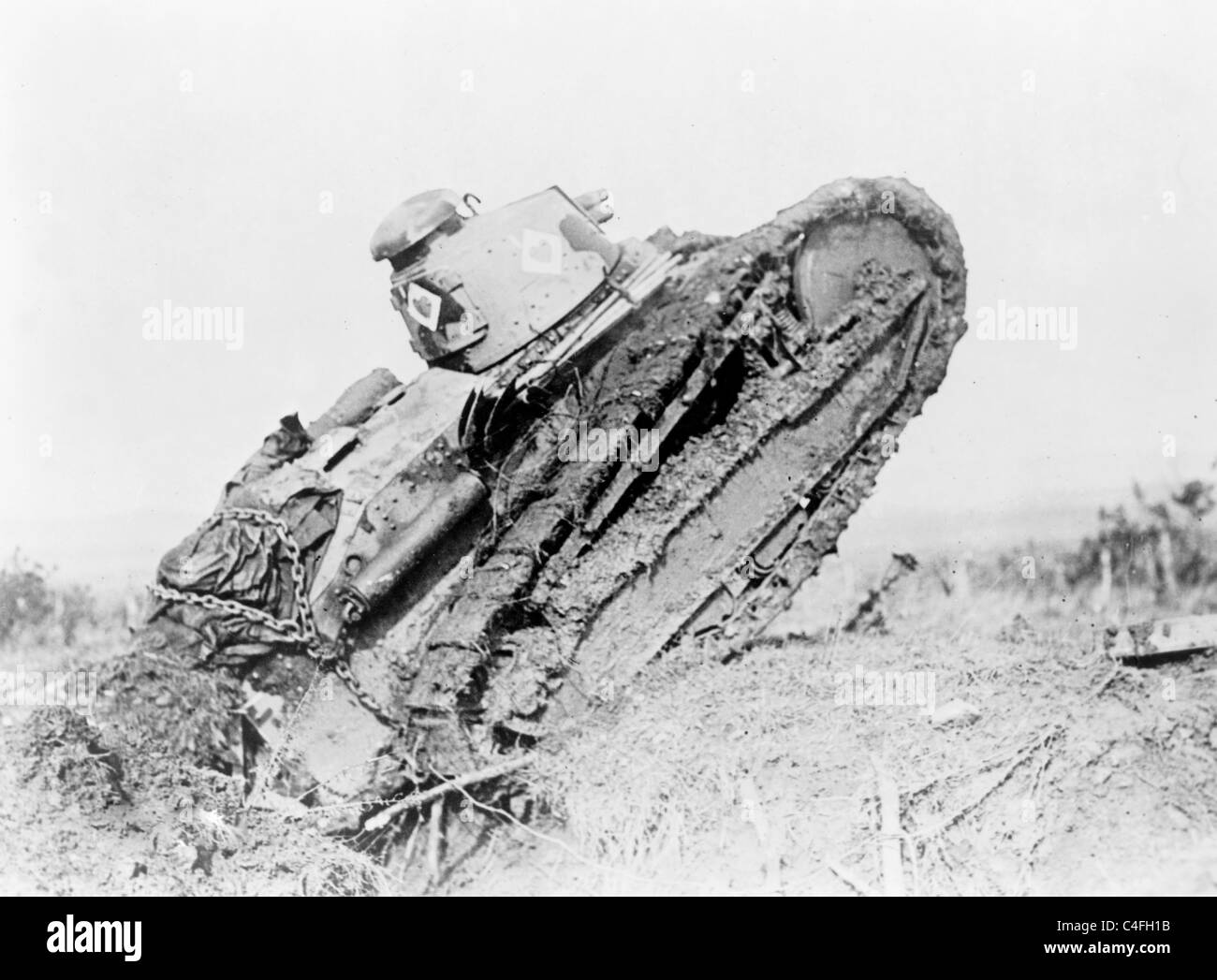 Tank in action passing a trench and starting toward the German line, during World War I, France Stock Photohttps://www.alamy.com/image-license-details/?v=1https://www.alamy.com/stock-photo-tank-in-action-passing-a-trench-and-starting-toward-the-german-line-37222007.html
Tank in action passing a trench and starting toward the German line, during World War I, France Stock Photohttps://www.alamy.com/image-license-details/?v=1https://www.alamy.com/stock-photo-tank-in-action-passing-a-trench-and-starting-toward-the-german-line-37222007.htmlRMC4FH1B–Tank in action passing a trench and starting toward the German line, during World War I, France
 Night time air raid on Paris during WW1 Stock Photohttps://www.alamy.com/image-license-details/?v=1https://www.alamy.com/night-time-air-raid-on-paris-during-ww1-image154612928.html
Night time air raid on Paris during WW1 Stock Photohttps://www.alamy.com/image-license-details/?v=1https://www.alamy.com/night-time-air-raid-on-paris-during-ww1-image154612928.htmlRMJYF6A8–Night time air raid on Paris during WW1
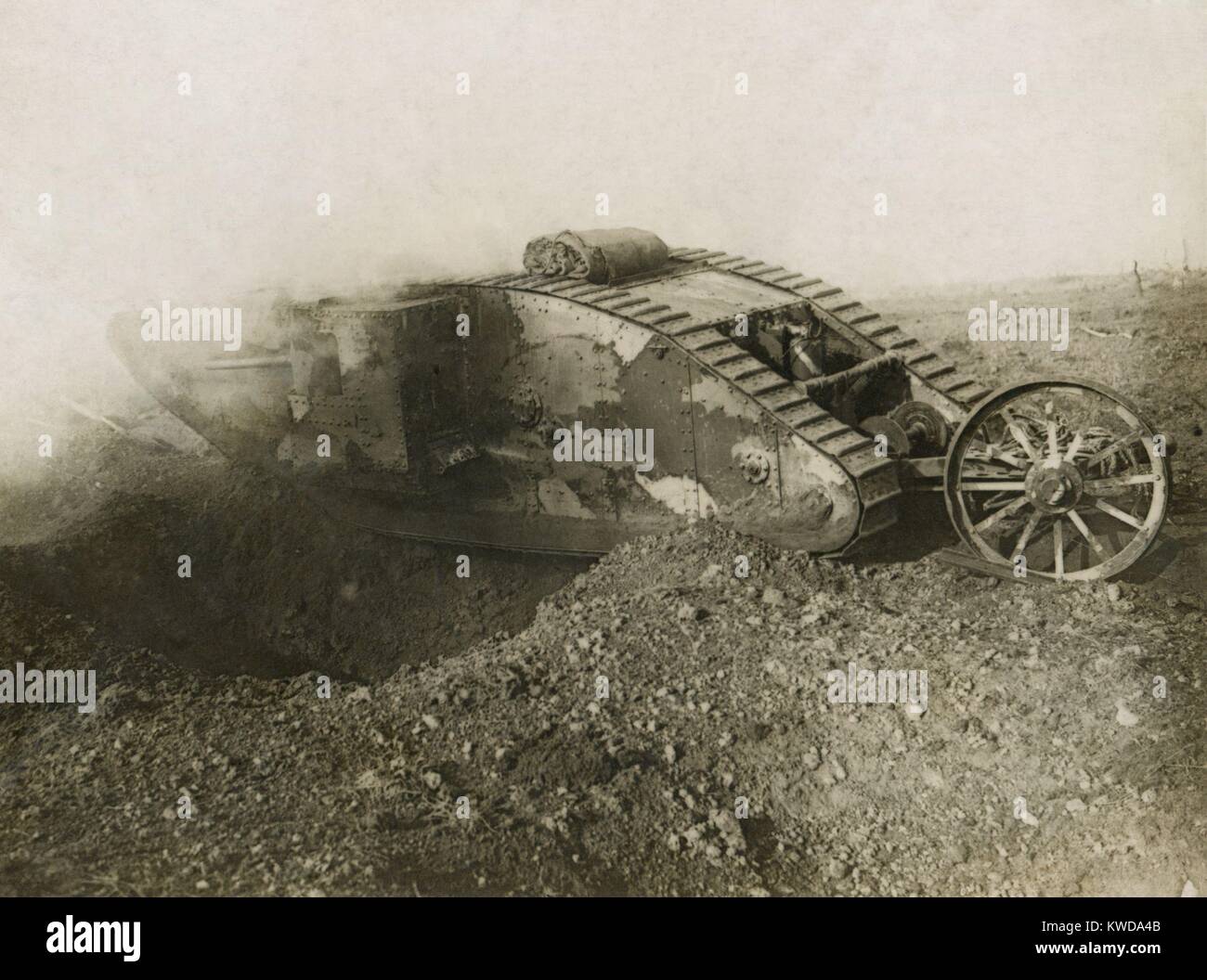 World War 1. Somme Offensive. One of the larger British tanks, the Mark I, spanning an enemy trench. The tank was introduced by the British on Sept. 15, 1916, during the Battle of Flers-Courcelette, of the Somme Offensive. (BSLOC 2013 1 153) Stock Photohttps://www.alamy.com/image-license-details/?v=1https://www.alamy.com/stock-photo-world-war-1-somme-offensive-one-of-the-larger-british-tanks-the-mark-170553051.html
World War 1. Somme Offensive. One of the larger British tanks, the Mark I, spanning an enemy trench. The tank was introduced by the British on Sept. 15, 1916, during the Battle of Flers-Courcelette, of the Somme Offensive. (BSLOC 2013 1 153) Stock Photohttps://www.alamy.com/image-license-details/?v=1https://www.alamy.com/stock-photo-world-war-1-somme-offensive-one-of-the-larger-british-tanks-the-mark-170553051.htmlRMKWDA4B–World War 1. Somme Offensive. One of the larger British tanks, the Mark I, spanning an enemy trench. The tank was introduced by the British on Sept. 15, 1916, during the Battle of Flers-Courcelette, of the Somme Offensive. (BSLOC 2013 1 153)
 Map of the battle strategy for the battle of Loos during World War One. From The British Campaign in France and Flanders by Arthur Conan Doyle, 1915. Stock Photohttps://www.alamy.com/image-license-details/?v=1https://www.alamy.com/map-of-the-battle-strategy-for-the-battle-of-loos-during-world-war-one-from-the-british-campaign-in-france-and-flanders-by-arthur-conan-doyle-1915-image608404477.html
Map of the battle strategy for the battle of Loos during World War One. From The British Campaign in France and Flanders by Arthur Conan Doyle, 1915. Stock Photohttps://www.alamy.com/image-license-details/?v=1https://www.alamy.com/map-of-the-battle-strategy-for-the-battle-of-loos-during-world-war-one-from-the-british-campaign-in-france-and-flanders-by-arthur-conan-doyle-1915-image608404477.htmlRM2X9R639–Map of the battle strategy for the battle of Loos during World War One. From The British Campaign in France and Flanders by Arthur Conan Doyle, 1915.
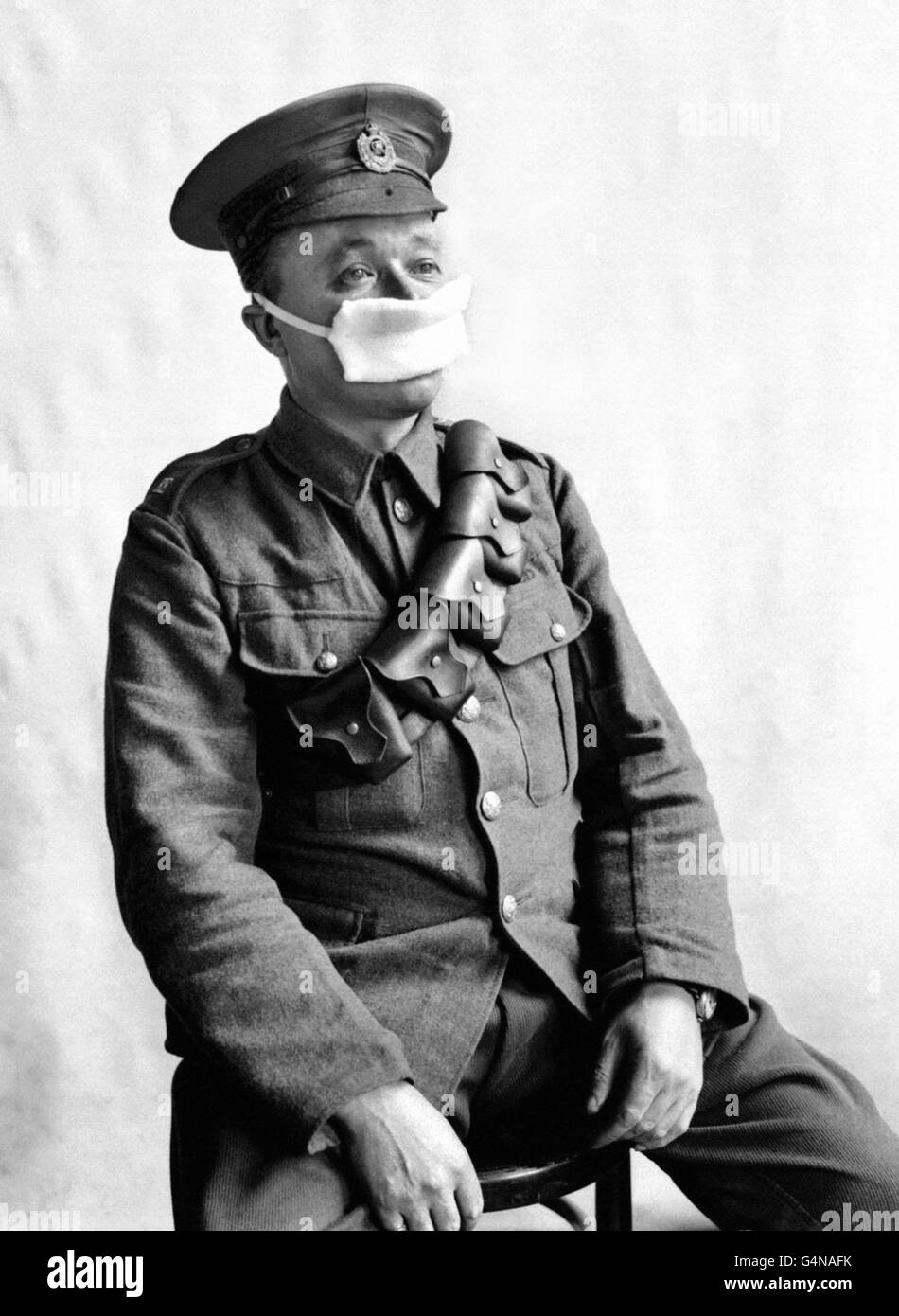 A soldier of the Royal Engineers wearing an early type of gas mask used during the first months of the First World War. Stock Photohttps://www.alamy.com/image-license-details/?v=1https://www.alamy.com/stock-photo-a-soldier-of-the-royal-engineers-wearing-an-early-type-of-gas-mask-106190103.html
A soldier of the Royal Engineers wearing an early type of gas mask used during the first months of the First World War. Stock Photohttps://www.alamy.com/image-license-details/?v=1https://www.alamy.com/stock-photo-a-soldier-of-the-royal-engineers-wearing-an-early-type-of-gas-mask-106190103.htmlRMG4NAFK–A soldier of the Royal Engineers wearing an early type of gas mask used during the first months of the First World War.
 Lewis gunners of the 12th Battalion, Royal Scots, wearing box respirators during a gas attack on a front line trench, Meteren, 25 June 1918. Stock Photohttps://www.alamy.com/image-license-details/?v=1https://www.alamy.com/lewis-gunners-of-the-12th-battalion-royal-scots-wearing-box-respirators-during-a-gas-attack-on-a-front-line-trench-meteren-25-june-1918-image462795515.html
Lewis gunners of the 12th Battalion, Royal Scots, wearing box respirators during a gas attack on a front line trench, Meteren, 25 June 1918. Stock Photohttps://www.alamy.com/image-license-details/?v=1https://www.alamy.com/lewis-gunners-of-the-12th-battalion-royal-scots-wearing-box-respirators-during-a-gas-attack-on-a-front-line-trench-meteren-25-june-1918-image462795515.htmlRM2HTX4B7–Lewis gunners of the 12th Battalion, Royal Scots, wearing box respirators during a gas attack on a front line trench, Meteren, 25 June 1918.
 World War 1 marked a paradigm shift in the way military leaders conceptualized programs that address the human needs of their personnel. Programs and services conceived by the YMCA has, developed and provided morale, welfare and recreation (MWR) activities; rest-and-recreation (R&R) programs for battle-weary soldiers and canteens and overseas exchanges operated during the first world war that modernized the exchange concept. The canteens provide English cigarettes, a cooked meal and sometimes facilities for reading and writing. Stock Photohttps://www.alamy.com/image-license-details/?v=1https://www.alamy.com/world-war-1-marked-a-paradigm-shift-in-the-way-military-leaders-conceptualized-programs-that-address-the-human-needs-of-their-personnel-programs-and-services-conceived-by-the-ymca-has-developed-and-provided-morale-welfare-and-recreation-mwr-activities-rest-and-recreation-rr-programs-for-battle-weary-soldiers-and-canteens-and-overseas-exchanges-operated-during-the-first-world-war-that-modernized-the-exchange-concept-the-canteens-provide-english-cigarettes-a-cooked-meal-and-sometimes-facilities-for-reading-and-writing-image211474904.html
World War 1 marked a paradigm shift in the way military leaders conceptualized programs that address the human needs of their personnel. Programs and services conceived by the YMCA has, developed and provided morale, welfare and recreation (MWR) activities; rest-and-recreation (R&R) programs for battle-weary soldiers and canteens and overseas exchanges operated during the first world war that modernized the exchange concept. The canteens provide English cigarettes, a cooked meal and sometimes facilities for reading and writing. Stock Photohttps://www.alamy.com/image-license-details/?v=1https://www.alamy.com/world-war-1-marked-a-paradigm-shift-in-the-way-military-leaders-conceptualized-programs-that-address-the-human-needs-of-their-personnel-programs-and-services-conceived-by-the-ymca-has-developed-and-provided-morale-welfare-and-recreation-mwr-activities-rest-and-recreation-rr-programs-for-battle-weary-soldiers-and-canteens-and-overseas-exchanges-operated-during-the-first-world-war-that-modernized-the-exchange-concept-the-canteens-provide-english-cigarettes-a-cooked-meal-and-sometimes-facilities-for-reading-and-writing-image211474904.htmlRMP81EB4–World War 1 marked a paradigm shift in the way military leaders conceptualized programs that address the human needs of their personnel. Programs and services conceived by the YMCA has, developed and provided morale, welfare and recreation (MWR) activities; rest-and-recreation (R&R) programs for battle-weary soldiers and canteens and overseas exchanges operated during the first world war that modernized the exchange concept. The canteens provide English cigarettes, a cooked meal and sometimes facilities for reading and writing.
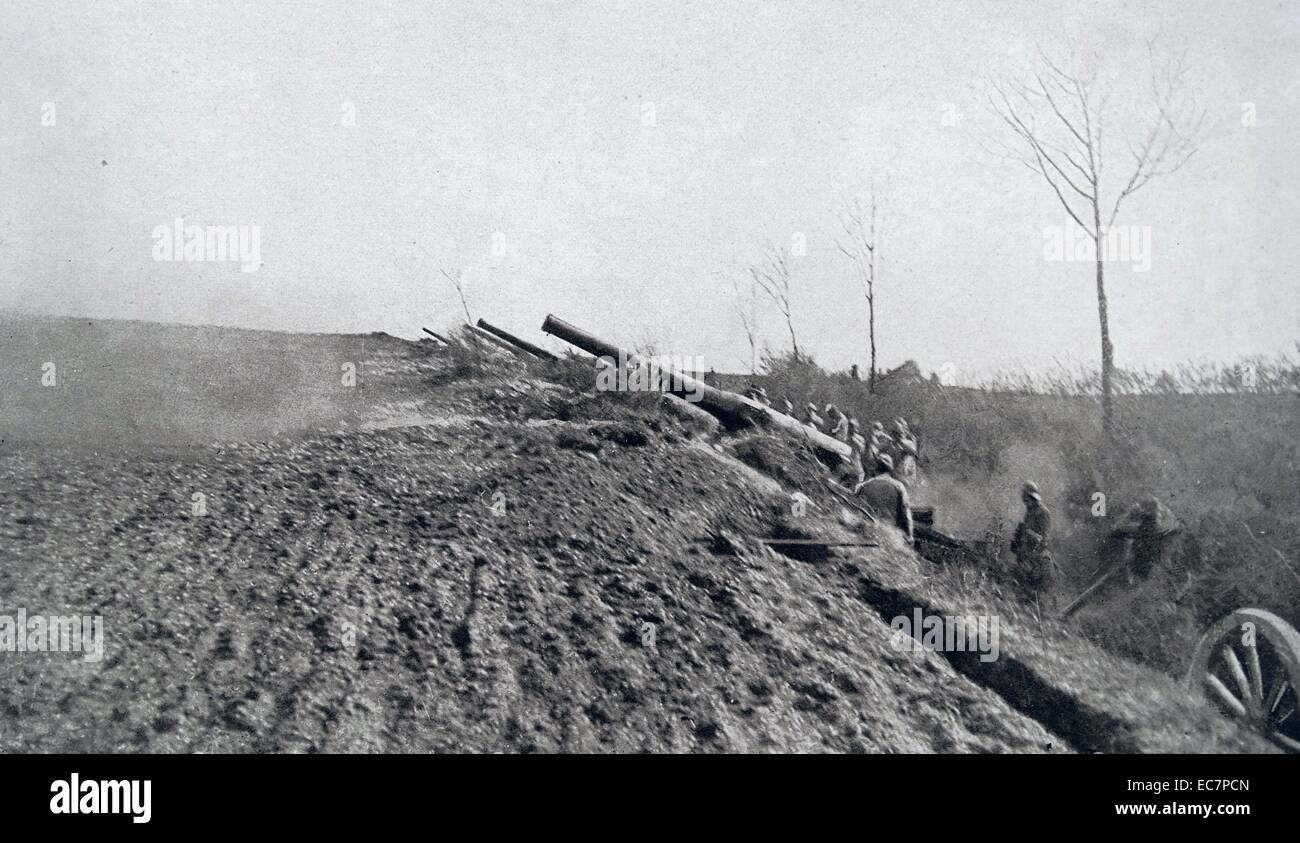 French artillery in action in France during the spring of 1918. World war one Stock Photohttps://www.alamy.com/image-license-details/?v=1https://www.alamy.com/stock-photo-french-artillery-in-action-in-france-during-the-spring-of-1918-world-76388613.html
French artillery in action in France during the spring of 1918. World war one Stock Photohttps://www.alamy.com/image-license-details/?v=1https://www.alamy.com/stock-photo-french-artillery-in-action-in-france-during-the-spring-of-1918-world-76388613.htmlRMEC7PCN–French artillery in action in France during the spring of 1918. World war one
 La Vie a Londres pendant la guerre. Voici un homme blesse' par la chute d'un V-l. Life in London during the war. Here is a man who was injured by the fall of a V-1, Ca. 1940. Stock Photohttps://www.alamy.com/image-license-details/?v=1https://www.alamy.com/stock-photo-la-vie-a-londres-pendant-la-guerre-voici-un-homme-blesse-par-la-chute-133016785.html
La Vie a Londres pendant la guerre. Voici un homme blesse' par la chute d'un V-l. Life in London during the war. Here is a man who was injured by the fall of a V-1, Ca. 1940. Stock Photohttps://www.alamy.com/image-license-details/?v=1https://www.alamy.com/stock-photo-la-vie-a-londres-pendant-la-guerre-voici-un-homme-blesse-par-la-chute-133016785.htmlRFHMBC7D–La Vie a Londres pendant la guerre. Voici un homme blesse' par la chute d'un V-l. Life in London during the war. Here is a man who was injured by the fall of a V-1, Ca. 1940.
 British infantry in a night attack near Mory, France, during the First World War. Stock Photohttps://www.alamy.com/image-license-details/?v=1https://www.alamy.com/british-infantry-in-a-night-attack-near-mory-france-during-the-first-world-war-image557532372.html
British infantry in a night attack near Mory, France, during the First World War. Stock Photohttps://www.alamy.com/image-license-details/?v=1https://www.alamy.com/british-infantry-in-a-night-attack-near-mory-france-during-the-first-world-war-image557532372.htmlRM2RB1P6C–British infantry in a night attack near Mory, France, during the First World War.
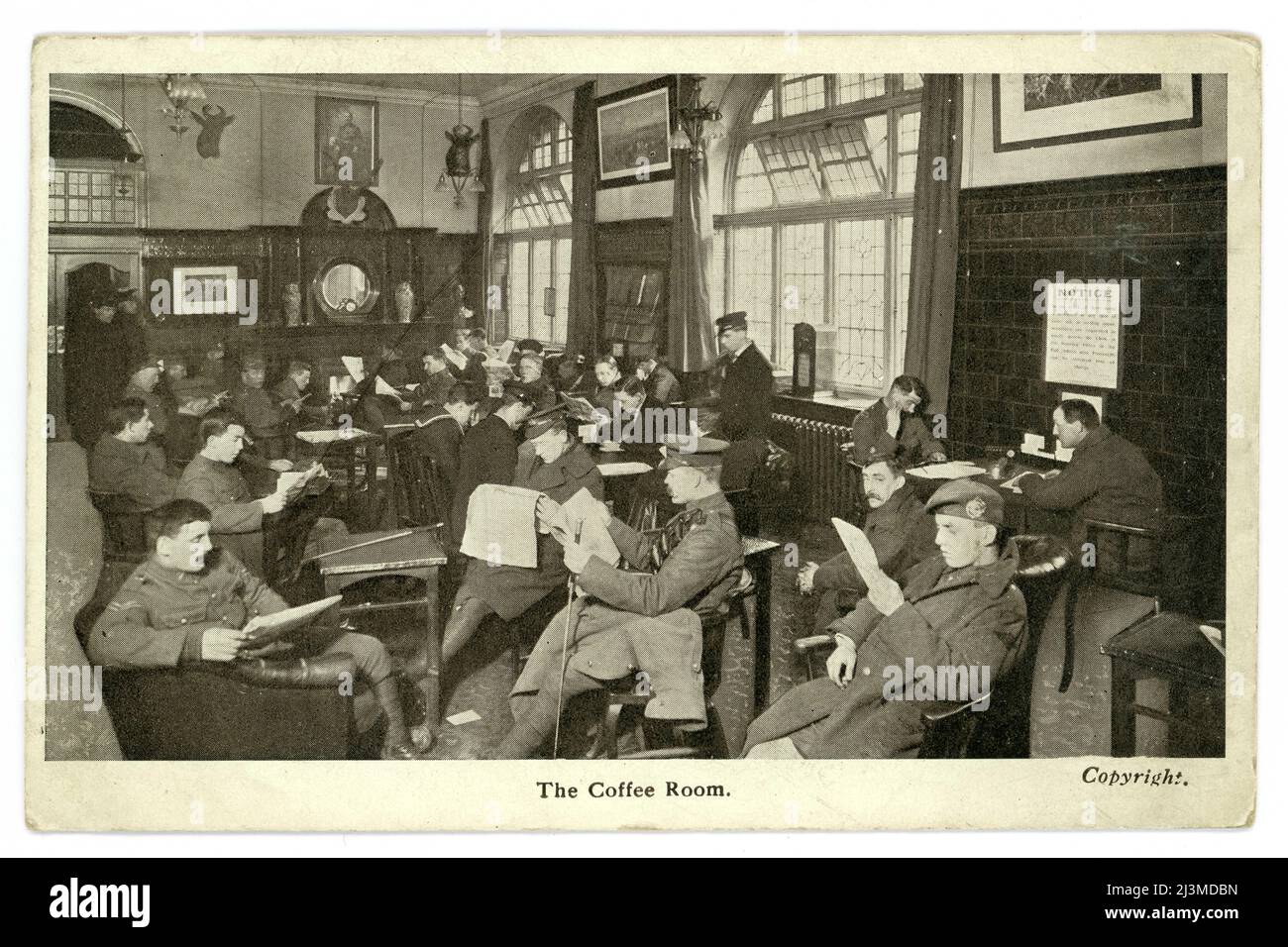 Original WW1 era postcard of The Coffee Room at the Union Jack Club, 91A Waterloo Road, Lambeth, London, U.K. Both army and navy personnel can be seen relaxing and reading newspapers. The Union Jack Club was opened in 1907 providing accommodation, a restaurant, meeting and reading rooms for servicemen whilst in London. It saw much use during both world wars. Postcard published by the Union Jack Club. circa 1915. Stock Photohttps://www.alamy.com/image-license-details/?v=1https://www.alamy.com/original-ww1-era-postcard-of-the-coffee-room-at-the-union-jack-club-91a-waterloo-road-lambeth-london-uk-both-army-and-navy-personnel-can-be-seen-relaxing-and-reading-newspapers-the-union-jack-club-was-opened-in-1907-providing-accommodation-a-restaurant-meeting-and-reading-rooms-for-servicemen-whilst-in-london-it-saw-much-use-during-both-world-wars-postcard-published-by-the-union-jack-club-circa-1915-image466973465.html
Original WW1 era postcard of The Coffee Room at the Union Jack Club, 91A Waterloo Road, Lambeth, London, U.K. Both army and navy personnel can be seen relaxing and reading newspapers. The Union Jack Club was opened in 1907 providing accommodation, a restaurant, meeting and reading rooms for servicemen whilst in London. It saw much use during both world wars. Postcard published by the Union Jack Club. circa 1915. Stock Photohttps://www.alamy.com/image-license-details/?v=1https://www.alamy.com/original-ww1-era-postcard-of-the-coffee-room-at-the-union-jack-club-91a-waterloo-road-lambeth-london-uk-both-army-and-navy-personnel-can-be-seen-relaxing-and-reading-newspapers-the-union-jack-club-was-opened-in-1907-providing-accommodation-a-restaurant-meeting-and-reading-rooms-for-servicemen-whilst-in-london-it-saw-much-use-during-both-world-wars-postcard-published-by-the-union-jack-club-circa-1915-image466973465.htmlRM2J3MDBN–Original WW1 era postcard of The Coffee Room at the Union Jack Club, 91A Waterloo Road, Lambeth, London, U.K. Both army and navy personnel can be seen relaxing and reading newspapers. The Union Jack Club was opened in 1907 providing accommodation, a restaurant, meeting and reading rooms for servicemen whilst in London. It saw much use during both world wars. Postcard published by the Union Jack Club. circa 1915.
 World War 1: Meuse-Argonne Offensive. American troops take a break from trench digging during the final Allied battle to drive German armies out of France. U.S. effort took place in the Verdun Sector, north and northwest of the town of Verdun, between Sept. 26 and Nov. 11, 1918. (BSLOC 2013 1 209) Stock Photohttps://www.alamy.com/image-license-details/?v=1https://www.alamy.com/stock-photo-world-war-1-meuse-argonne-offensive-american-troops-take-a-break-from-170543876.html
World War 1: Meuse-Argonne Offensive. American troops take a break from trench digging during the final Allied battle to drive German armies out of France. U.S. effort took place in the Verdun Sector, north and northwest of the town of Verdun, between Sept. 26 and Nov. 11, 1918. (BSLOC 2013 1 209) Stock Photohttps://www.alamy.com/image-license-details/?v=1https://www.alamy.com/stock-photo-world-war-1-meuse-argonne-offensive-american-troops-take-a-break-from-170543876.htmlRMKWCXCM–World War 1: Meuse-Argonne Offensive. American troops take a break from trench digging during the final Allied battle to drive German armies out of France. U.S. effort took place in the Verdun Sector, north and northwest of the town of Verdun, between Sept. 26 and Nov. 11, 1918. (BSLOC 2013 1 209)
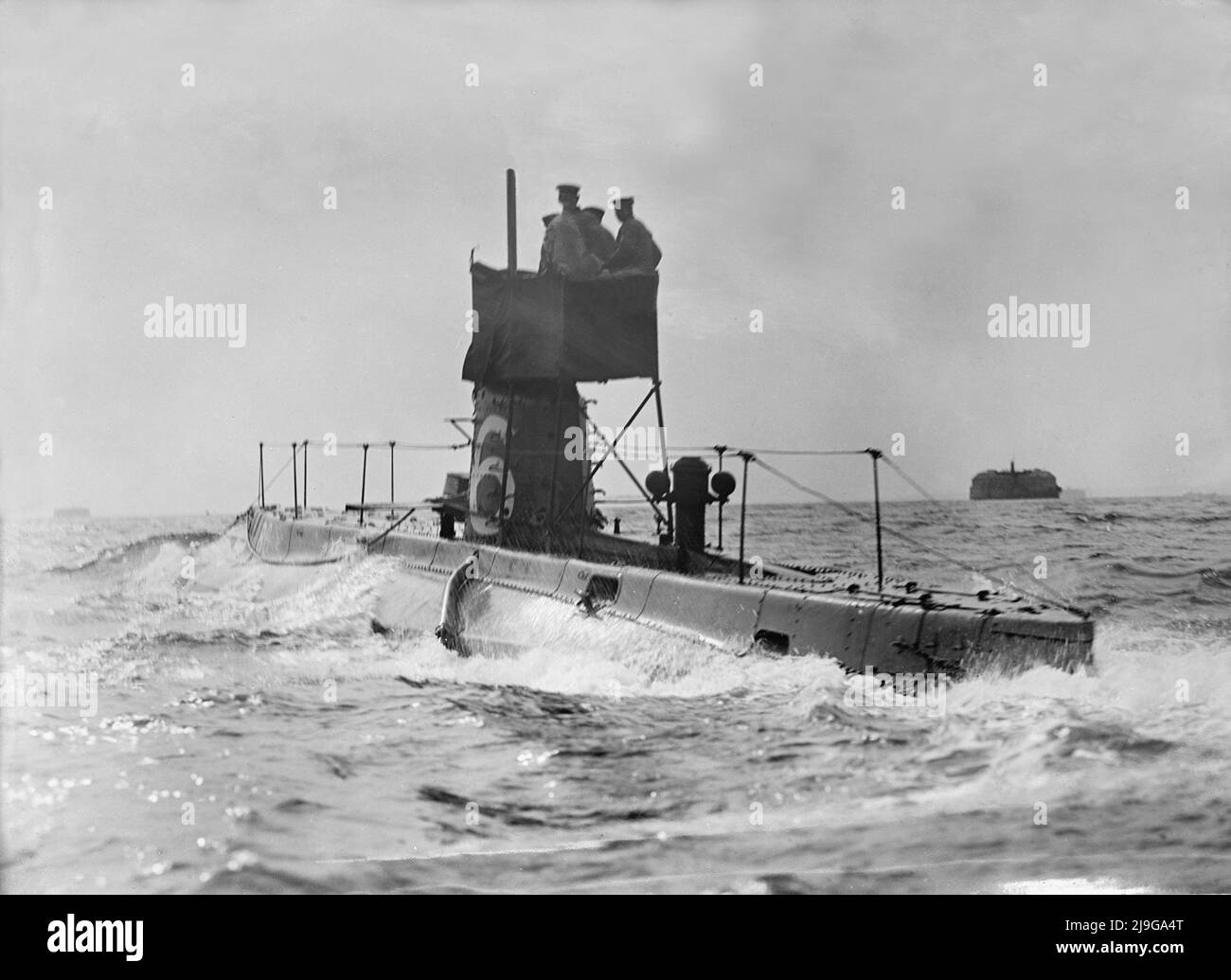 A vintage photo circa 1914 of the Royal Navy submarine HMS B6 cruising on the surface in the Solent. Launched 30 November 1905 she served during World War One based at Gibraltar and later deployed to the Eastern Mediterranean for service during the Gallipoli Campaign. She was eventually scrapped in 1921 Stock Photohttps://www.alamy.com/image-license-details/?v=1https://www.alamy.com/a-vintage-photo-circa-1914-of-the-royal-navy-submarine-hms-b6-cruising-on-the-surface-in-the-solent-launched-30-november-1905-she-served-during-world-war-one-based-at-gibraltar-and-later-deployed-to-the-eastern-mediterranean-for-service-during-the-gallipoli-campaign-she-was-eventually-scrapped-in-1921-image470571048.html
A vintage photo circa 1914 of the Royal Navy submarine HMS B6 cruising on the surface in the Solent. Launched 30 November 1905 she served during World War One based at Gibraltar and later deployed to the Eastern Mediterranean for service during the Gallipoli Campaign. She was eventually scrapped in 1921 Stock Photohttps://www.alamy.com/image-license-details/?v=1https://www.alamy.com/a-vintage-photo-circa-1914-of-the-royal-navy-submarine-hms-b6-cruising-on-the-surface-in-the-solent-launched-30-november-1905-she-served-during-world-war-one-based-at-gibraltar-and-later-deployed-to-the-eastern-mediterranean-for-service-during-the-gallipoli-campaign-she-was-eventually-scrapped-in-1921-image470571048.htmlRM2J9GA4T–A vintage photo circa 1914 of the Royal Navy submarine HMS B6 cruising on the surface in the Solent. Launched 30 November 1905 she served during World War One based at Gibraltar and later deployed to the Eastern Mediterranean for service during the Gallipoli Campaign. She was eventually scrapped in 1921
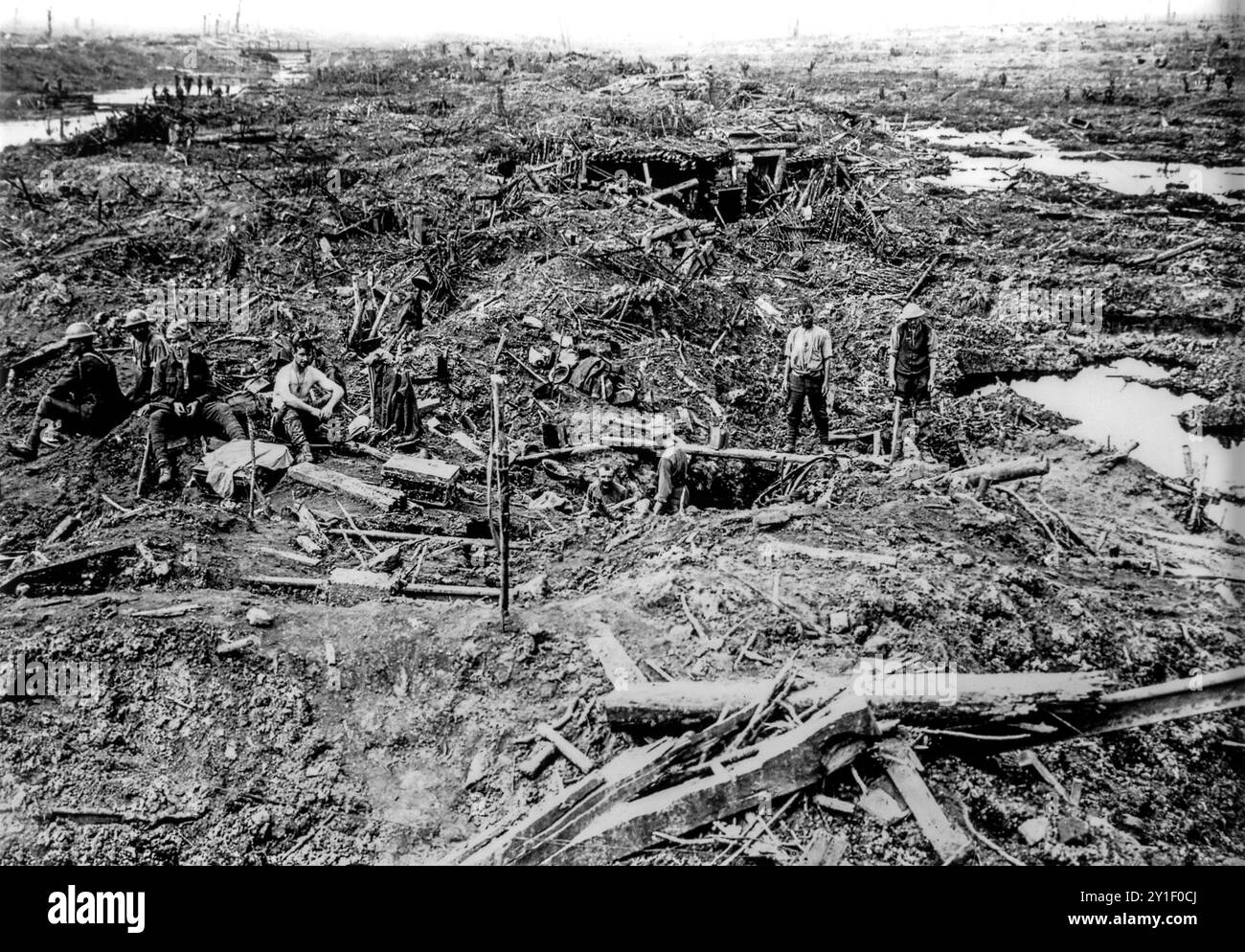 WWI 1917 Battle of Passchendaele, British Army soldiers in smashed German trenches near Boezinge during World War One in West Flanders, Belgium Stock Photohttps://www.alamy.com/image-license-details/?v=1https://www.alamy.com/wwi-1917-battle-of-passchendaele-british-army-soldiers-in-smashed-german-trenches-near-boezinge-during-world-war-one-in-west-flanders-belgium-image620517538.html
WWI 1917 Battle of Passchendaele, British Army soldiers in smashed German trenches near Boezinge during World War One in West Flanders, Belgium Stock Photohttps://www.alamy.com/image-license-details/?v=1https://www.alamy.com/wwi-1917-battle-of-passchendaele-british-army-soldiers-in-smashed-german-trenches-near-boezinge-during-world-war-one-in-west-flanders-belgium-image620517538.htmlRM2Y1F0CJ–WWI 1917 Battle of Passchendaele, British Army soldiers in smashed German trenches near Boezinge during World War One in West Flanders, Belgium
 During The Great War 1914-1918. A sailor seen signalling from one British warship to another. Depending on how the two flags were positioned, the combinations meant different letters and numbers. The advantage of using this manual signalling system was that messages not could be overheard, like when transmitting on radio frequency. The disadvantage is that bad weather and poor sight could make it difficult to see the flags and message. 1916 Stock Photohttps://www.alamy.com/image-license-details/?v=1https://www.alamy.com/during-the-great-war-1914-1918-a-sailor-seen-signalling-from-one-british-warship-to-another-depending-on-how-the-two-flags-were-positioned-the-combinations-meant-different-letters-and-numbers-the-advantage-of-using-this-manual-signalling-system-was-that-messages-not-could-be-overheard-like-when-transmitting-on-radio-frequency-the-disadvantage-is-that-bad-weather-and-poor-sight-could-make-it-difficult-to-see-the-flags-and-message-1916-image554038438.html
During The Great War 1914-1918. A sailor seen signalling from one British warship to another. Depending on how the two flags were positioned, the combinations meant different letters and numbers. The advantage of using this manual signalling system was that messages not could be overheard, like when transmitting on radio frequency. The disadvantage is that bad weather and poor sight could make it difficult to see the flags and message. 1916 Stock Photohttps://www.alamy.com/image-license-details/?v=1https://www.alamy.com/during-the-great-war-1914-1918-a-sailor-seen-signalling-from-one-british-warship-to-another-depending-on-how-the-two-flags-were-positioned-the-combinations-meant-different-letters-and-numbers-the-advantage-of-using-this-manual-signalling-system-was-that-messages-not-could-be-overheard-like-when-transmitting-on-radio-frequency-the-disadvantage-is-that-bad-weather-and-poor-sight-could-make-it-difficult-to-see-the-flags-and-message-1916-image554038438.htmlRM2R5AHK2–During The Great War 1914-1918. A sailor seen signalling from one British warship to another. Depending on how the two flags were positioned, the combinations meant different letters and numbers. The advantage of using this manual signalling system was that messages not could be overheard, like when transmitting on radio frequency. The disadvantage is that bad weather and poor sight could make it difficult to see the flags and message. 1916
 Entitled: Runners working in a barrage. Sketch shows soldiers passing along a written message during a battle in World War I by Lucien Jonas. A runner was a soldier responsible for passing on messages between fronts during war. This was a very dangerous d Stock Photohttps://www.alamy.com/image-license-details/?v=1https://www.alamy.com/stock-photo-entitled-runners-working-in-a-barrage-sketch-shows-soldiers-passing-104017342.html
Entitled: Runners working in a barrage. Sketch shows soldiers passing along a written message during a battle in World War I by Lucien Jonas. A runner was a soldier responsible for passing on messages between fronts during war. This was a very dangerous d Stock Photohttps://www.alamy.com/image-license-details/?v=1https://www.alamy.com/stock-photo-entitled-runners-working-in-a-barrage-sketch-shows-soldiers-passing-104017342.htmlRMG16B52–Entitled: Runners working in a barrage. Sketch shows soldiers passing along a written message during a battle in World War I by Lucien Jonas. A runner was a soldier responsible for passing on messages between fronts during war. This was a very dangerous d
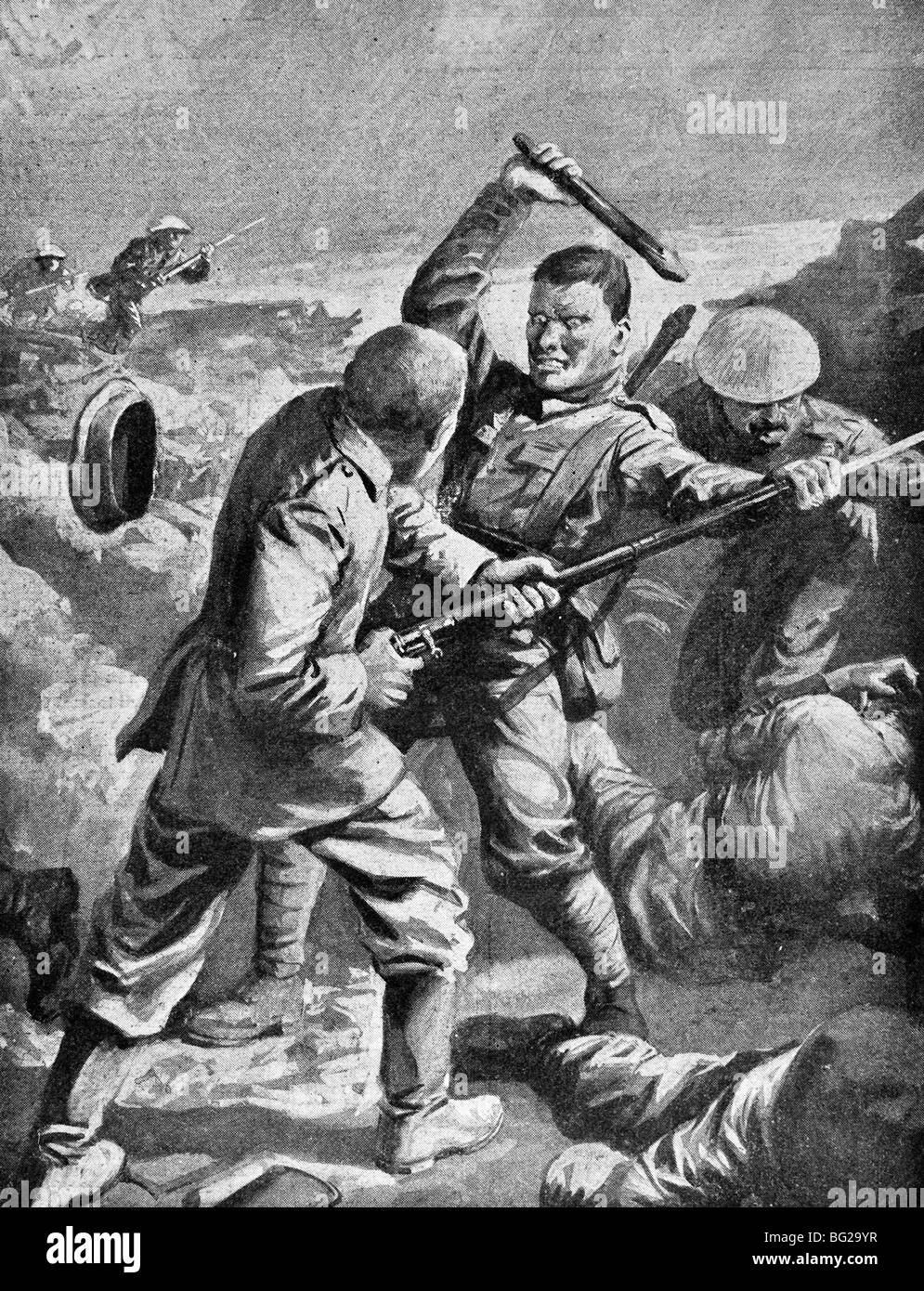 Contemporary WW1 illustration of the Royal Munster Fusiliers raiding a German trench during the Battle of the Somme in 1916. Stock Photohttps://www.alamy.com/image-license-details/?v=1https://www.alamy.com/stock-photo-contemporary-ww1-illustration-of-the-royal-munster-fusiliers-raiding-27096603.html
Contemporary WW1 illustration of the Royal Munster Fusiliers raiding a German trench during the Battle of the Somme in 1916. Stock Photohttps://www.alamy.com/image-license-details/?v=1https://www.alamy.com/stock-photo-contemporary-ww1-illustration-of-the-royal-munster-fusiliers-raiding-27096603.htmlRMBG29YR–Contemporary WW1 illustration of the Royal Munster Fusiliers raiding a German trench during the Battle of the Somme in 1916.
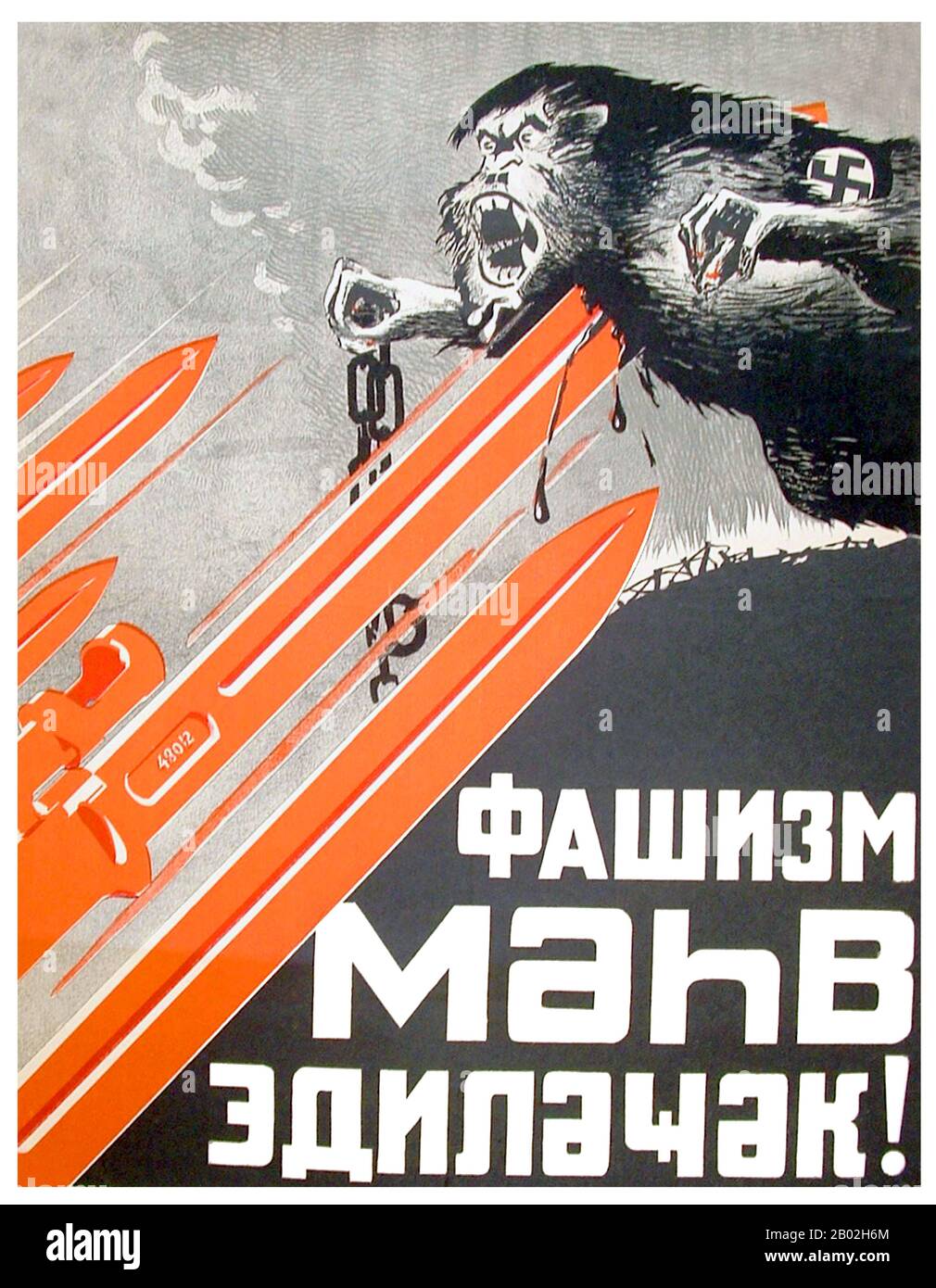 Operation Barbarossa, beginning 22 June 1941, was the code name for Germany's invasion of the Soviet Union during World War II. Over the course of the operation, about four million soldiers of the Axis powers invaded the USSR along a 2,900 km (1,800 mi) front, the largest invasion in the history of warfare. In addition to troops, Barbarossa used 600,000 motor vehicles and 750,000 horses. The ambitious operation was driven by Adolf Hitler's persistent desire to conquer the Soviet territories as embodied in Generalplan Ost. It marked the beginning of the pivotal phase in deciding the victors of Stock Photohttps://www.alamy.com/image-license-details/?v=1https://www.alamy.com/operation-barbarossa-beginning-22-june-1941-was-the-code-name-for-germanys-invasion-of-the-soviet-union-during-world-war-ii-over-the-course-of-the-operation-about-four-million-soldiers-of-the-axis-powers-invaded-the-ussr-along-a-2900-km-1800-mi-front-the-largest-invasion-in-the-history-of-warfare-in-addition-to-troops-barbarossa-used-600000-motor-vehicles-and-750000-horses-the-ambitious-operation-was-driven-by-adolf-hitlers-persistent-desire-to-conquer-the-soviet-territories-as-embodied-in-generalplan-ost-it-marked-the-beginning-of-the-pivotal-phase-in-deciding-the-victors-of-image344264780.html
Operation Barbarossa, beginning 22 June 1941, was the code name for Germany's invasion of the Soviet Union during World War II. Over the course of the operation, about four million soldiers of the Axis powers invaded the USSR along a 2,900 km (1,800 mi) front, the largest invasion in the history of warfare. In addition to troops, Barbarossa used 600,000 motor vehicles and 750,000 horses. The ambitious operation was driven by Adolf Hitler's persistent desire to conquer the Soviet territories as embodied in Generalplan Ost. It marked the beginning of the pivotal phase in deciding the victors of Stock Photohttps://www.alamy.com/image-license-details/?v=1https://www.alamy.com/operation-barbarossa-beginning-22-june-1941-was-the-code-name-for-germanys-invasion-of-the-soviet-union-during-world-war-ii-over-the-course-of-the-operation-about-four-million-soldiers-of-the-axis-powers-invaded-the-ussr-along-a-2900-km-1800-mi-front-the-largest-invasion-in-the-history-of-warfare-in-addition-to-troops-barbarossa-used-600000-motor-vehicles-and-750000-horses-the-ambitious-operation-was-driven-by-adolf-hitlers-persistent-desire-to-conquer-the-soviet-territories-as-embodied-in-generalplan-ost-it-marked-the-beginning-of-the-pivotal-phase-in-deciding-the-victors-of-image344264780.htmlRM2B02H6M–Operation Barbarossa, beginning 22 June 1941, was the code name for Germany's invasion of the Soviet Union during World War II. Over the course of the operation, about four million soldiers of the Axis powers invaded the USSR along a 2,900 km (1,800 mi) front, the largest invasion in the history of warfare. In addition to troops, Barbarossa used 600,000 motor vehicles and 750,000 horses. The ambitious operation was driven by Adolf Hitler's persistent desire to conquer the Soviet territories as embodied in Generalplan Ost. It marked the beginning of the pivotal phase in deciding the victors of
 At the Battle of Coronel, 1 November 1914, by William Lionel Wyllie the armoured cruiser HMS ‘Monmouth’ was set on fire during her encounter with the ‘Gneisenau’, the guns of the British ship being effectively out of range. She remained afloat after Admiral von Spee’s larger vessels lost contact in the dark at 20.00 hours. At about 21.20 she was found by the German light cruiser ‘Nürnberg’. ‘Monmouth’s’ engines were still running and her steering gear was undamaged. She did not haul down her flag nor return fire but seemed to be turning, either to ram her opponent or to bring her starboard gun Stock Photohttps://www.alamy.com/image-license-details/?v=1https://www.alamy.com/at-the-battle-of-coronel-1-november-1914-by-william-lionel-wyllie-the-armoured-cruiser-hms-monmouth-was-set-on-fire-during-her-encounter-with-the-gneisenau-the-guns-of-the-british-ship-being-effectively-out-of-range-she-remained-afloat-after-admiral-von-spees-larger-vessels-lost-contact-in-the-dark-at-2000-hours-at-about-2120-she-was-found-by-the-german-light-cruiser-nrnberg-monmouths-engines-were-still-running-and-her-steering-gear-was-undamaged-she-did-not-haul-down-her-flag-nor-return-fire-but-seemed-to-be-turning-either-to-ram-her-opponent-or-to-bring-her-starboard-gun-image611360939.html
At the Battle of Coronel, 1 November 1914, by William Lionel Wyllie the armoured cruiser HMS ‘Monmouth’ was set on fire during her encounter with the ‘Gneisenau’, the guns of the British ship being effectively out of range. She remained afloat after Admiral von Spee’s larger vessels lost contact in the dark at 20.00 hours. At about 21.20 she was found by the German light cruiser ‘Nürnberg’. ‘Monmouth’s’ engines were still running and her steering gear was undamaged. She did not haul down her flag nor return fire but seemed to be turning, either to ram her opponent or to bring her starboard gun Stock Photohttps://www.alamy.com/image-license-details/?v=1https://www.alamy.com/at-the-battle-of-coronel-1-november-1914-by-william-lionel-wyllie-the-armoured-cruiser-hms-monmouth-was-set-on-fire-during-her-encounter-with-the-gneisenau-the-guns-of-the-british-ship-being-effectively-out-of-range-she-remained-afloat-after-admiral-von-spees-larger-vessels-lost-contact-in-the-dark-at-2000-hours-at-about-2120-she-was-found-by-the-german-light-cruiser-nrnberg-monmouths-engines-were-still-running-and-her-steering-gear-was-undamaged-she-did-not-haul-down-her-flag-nor-return-fire-but-seemed-to-be-turning-either-to-ram-her-opponent-or-to-bring-her-starboard-gun-image611360939.htmlRM2XEHW37–At the Battle of Coronel, 1 November 1914, by William Lionel Wyllie the armoured cruiser HMS ‘Monmouth’ was set on fire during her encounter with the ‘Gneisenau’, the guns of the British ship being effectively out of range. She remained afloat after Admiral von Spee’s larger vessels lost contact in the dark at 20.00 hours. At about 21.20 she was found by the German light cruiser ‘Nürnberg’. ‘Monmouth’s’ engines were still running and her steering gear was undamaged. She did not haul down her flag nor return fire but seemed to be turning, either to ram her opponent or to bring her starboard gun
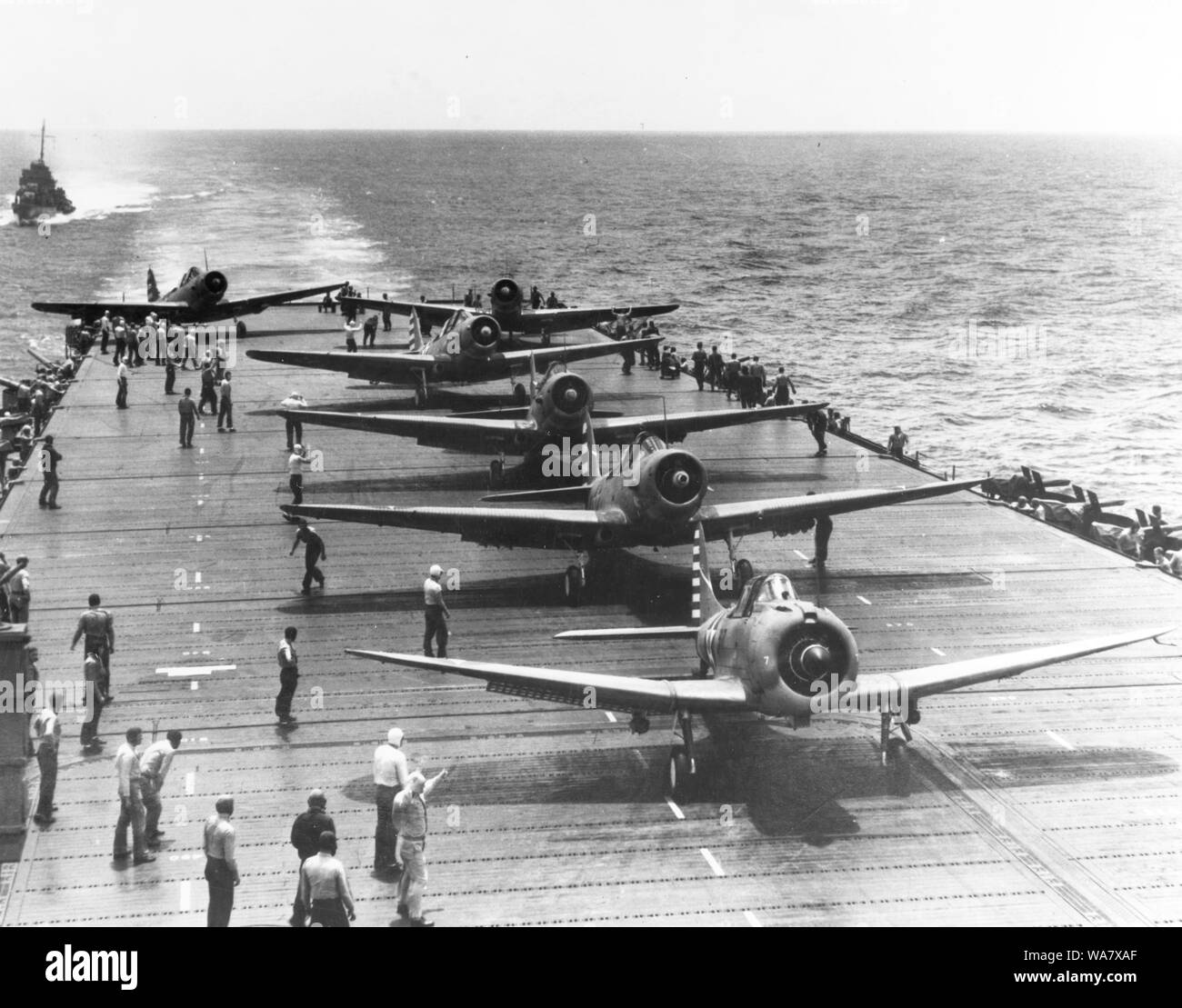 SBD Dauntless scout-bomber and five TBD-1 Devastator torpedo planes prepare to take-off from the USS Enterprise (CV-6) aircraft carrier during operations in the south Pacific area, 1942 Stock Photohttps://www.alamy.com/image-license-details/?v=1https://www.alamy.com/sbd-dauntless-scout-bomber-and-five-tbd-1-devastator-torpedo-planes-prepare-to-take-off-from-the-uss-enterprise-cv-6-aircraft-carrier-during-operations-in-the-south-pacific-area-1942-image264476423.html
SBD Dauntless scout-bomber and five TBD-1 Devastator torpedo planes prepare to take-off from the USS Enterprise (CV-6) aircraft carrier during operations in the south Pacific area, 1942 Stock Photohttps://www.alamy.com/image-license-details/?v=1https://www.alamy.com/sbd-dauntless-scout-bomber-and-five-tbd-1-devastator-torpedo-planes-prepare-to-take-off-from-the-uss-enterprise-cv-6-aircraft-carrier-during-operations-in-the-south-pacific-area-1942-image264476423.htmlRMWA7XAF–SBD Dauntless scout-bomber and five TBD-1 Devastator torpedo planes prepare to take-off from the USS Enterprise (CV-6) aircraft carrier during operations in the south Pacific area, 1942
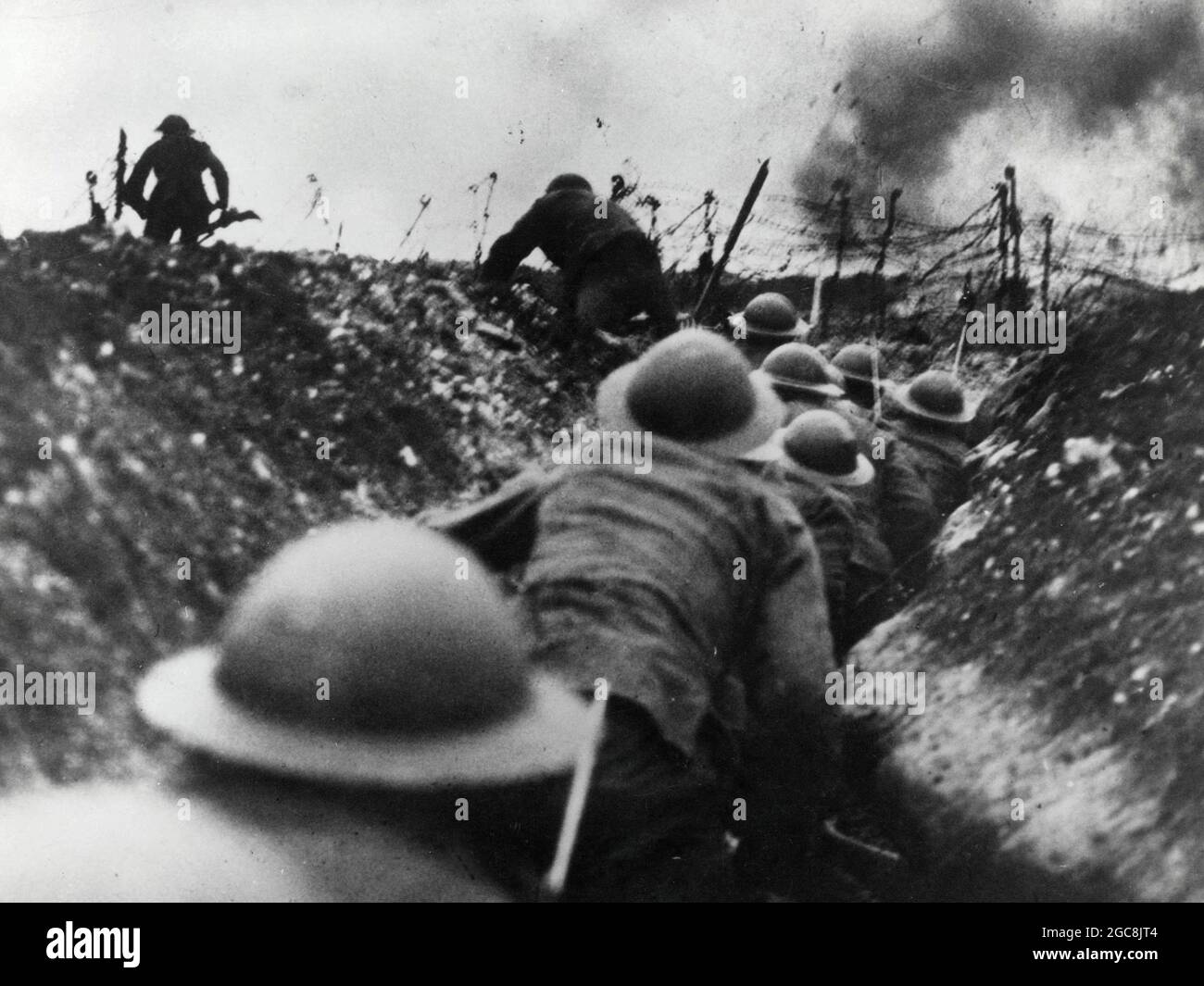 THE SOMME, FRANCE - July 1916 - British soldiers go 'over the top' from a trench during the Battle of the Somme during the First World War. The Battle Stock Photohttps://www.alamy.com/image-license-details/?v=1https://www.alamy.com/the-somme-france-july-1916-british-soldiers-go-over-the-top-from-a-trench-during-the-battle-of-the-somme-during-the-first-world-war-the-battle-image437825476.html
THE SOMME, FRANCE - July 1916 - British soldiers go 'over the top' from a trench during the Battle of the Somme during the First World War. The Battle Stock Photohttps://www.alamy.com/image-license-details/?v=1https://www.alamy.com/the-somme-france-july-1916-british-soldiers-go-over-the-top-from-a-trench-during-the-battle-of-the-somme-during-the-first-world-war-the-battle-image437825476.htmlRM2GC8JT4–THE SOMME, FRANCE - July 1916 - British soldiers go 'over the top' from a trench during the Battle of the Somme during the First World War. The Battle
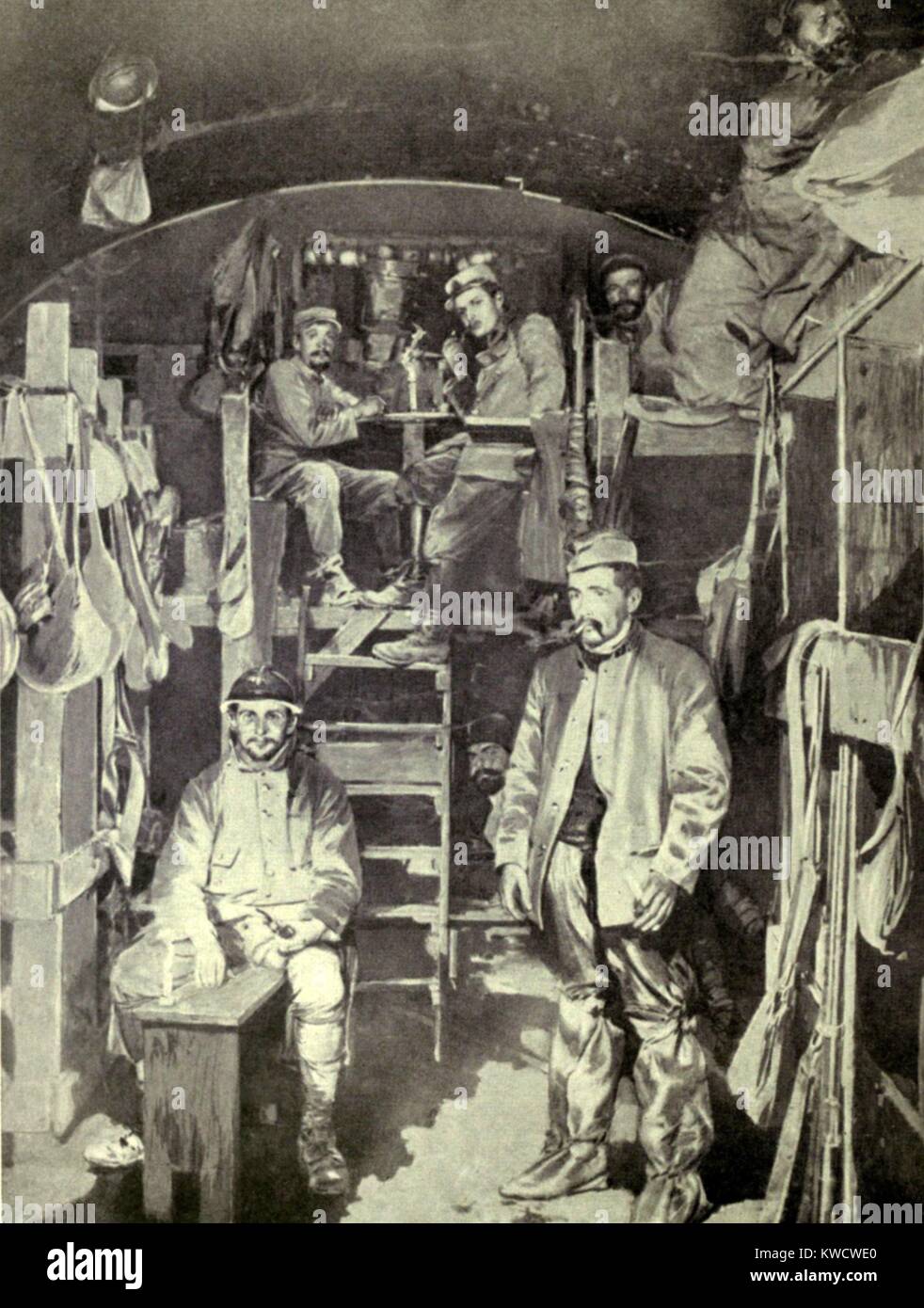 World War 1: Battle of Verdun. French Soldiers in a bunked sleeping-cabin in Vaux Fort. The French recaptured the fort from the Germans on Nov. 2, 1916 and enjoyed the benefit of betterment of the quarters during its German occupation from June to Oct. 1916. (BSLOC 2013 1 92) Stock Photohttps://www.alamy.com/image-license-details/?v=1https://www.alamy.com/stock-photo-world-war-1-battle-of-verdun-french-soldiers-in-a-bunked-sleeping-170543128.html
World War 1: Battle of Verdun. French Soldiers in a bunked sleeping-cabin in Vaux Fort. The French recaptured the fort from the Germans on Nov. 2, 1916 and enjoyed the benefit of betterment of the quarters during its German occupation from June to Oct. 1916. (BSLOC 2013 1 92) Stock Photohttps://www.alamy.com/image-license-details/?v=1https://www.alamy.com/stock-photo-world-war-1-battle-of-verdun-french-soldiers-in-a-bunked-sleeping-170543128.htmlRMKWCWE0–World War 1: Battle of Verdun. French Soldiers in a bunked sleeping-cabin in Vaux Fort. The French recaptured the fort from the Germans on Nov. 2, 1916 and enjoyed the benefit of betterment of the quarters during its German occupation from June to Oct. 1916. (BSLOC 2013 1 92)
 Halftone of a Russian rearguard at work during the Polish retreat in World War One. Stock Photohttps://www.alamy.com/image-license-details/?v=1https://www.alamy.com/halftone-of-a-russian-rearguard-at-work-during-the-polish-retreat-in-world-war-one-image369134825.html
Halftone of a Russian rearguard at work during the Polish retreat in World War One. Stock Photohttps://www.alamy.com/image-license-details/?v=1https://www.alamy.com/halftone-of-a-russian-rearguard-at-work-during-the-polish-retreat-in-world-war-one-image369134825.htmlRM2CCFF6H–Halftone of a Russian rearguard at work during the Polish retreat in World War One.
 General Sir Arthur William Currie [General Sir Arthur William Currie, GCMG, KCB (5 December 1875 – 30 November 1933) was a senior officer of the Canadian Army who fought during World War I. He had the unique distinction of starting his military career on the very bottom rung as a pre-war militia gunner before rising through the ranks to become the first Canadian commander of the Canadian Corps. Currie's success was based on his ability to rapidly adapt brigade tactics to the exigencies of trench warfare, using set piece operations and bite-and-hold tactics. He is generally considered to be amo Stock Photohttps://www.alamy.com/image-license-details/?v=1https://www.alamy.com/general-sir-arthur-william-currie-general-sir-arthur-william-currie-gcmg-kcb-5-december-1875-30-november-1933-was-a-senior-officer-of-the-canadian-army-who-fought-during-world-war-i-he-had-the-unique-distinction-of-starting-his-military-career-on-the-very-bottom-rung-as-a-pre-war-militia-gunner-before-rising-through-the-ranks-to-become-the-first-canadian-commander-of-the-canadian-corps-curries-success-was-based-on-his-ability-to-rapidly-adapt-brigade-tactics-to-the-exigencies-of-trench-warfare-using-set-piece-operations-and-bite-and-hold-tactics-he-is-generally-considered-to-be-amo-image505992152.html
General Sir Arthur William Currie [General Sir Arthur William Currie, GCMG, KCB (5 December 1875 – 30 November 1933) was a senior officer of the Canadian Army who fought during World War I. He had the unique distinction of starting his military career on the very bottom rung as a pre-war militia gunner before rising through the ranks to become the first Canadian commander of the Canadian Corps. Currie's success was based on his ability to rapidly adapt brigade tactics to the exigencies of trench warfare, using set piece operations and bite-and-hold tactics. He is generally considered to be amo Stock Photohttps://www.alamy.com/image-license-details/?v=1https://www.alamy.com/general-sir-arthur-william-currie-general-sir-arthur-william-currie-gcmg-kcb-5-december-1875-30-november-1933-was-a-senior-officer-of-the-canadian-army-who-fought-during-world-war-i-he-had-the-unique-distinction-of-starting-his-military-career-on-the-very-bottom-rung-as-a-pre-war-militia-gunner-before-rising-through-the-ranks-to-become-the-first-canadian-commander-of-the-canadian-corps-curries-success-was-based-on-his-ability-to-rapidly-adapt-brigade-tactics-to-the-exigencies-of-trench-warfare-using-set-piece-operations-and-bite-and-hold-tactics-he-is-generally-considered-to-be-amo-image505992152.htmlRF2MB5X48–General Sir Arthur William Currie [General Sir Arthur William Currie, GCMG, KCB (5 December 1875 – 30 November 1933) was a senior officer of the Canadian Army who fought during World War I. He had the unique distinction of starting his military career on the very bottom rung as a pre-war militia gunner before rising through the ranks to become the first Canadian commander of the Canadian Corps. Currie's success was based on his ability to rapidly adapt brigade tactics to the exigencies of trench warfare, using set piece operations and bite-and-hold tactics. He is generally considered to be amo
 Lewis gunners of the 12th Battalion, Royal Scots, wearing box respirators during a gas attack on a front line trench, Meteren, 25 June 1918. Stock Photohttps://www.alamy.com/image-license-details/?v=1https://www.alamy.com/lewis-gunners-of-the-12th-battalion-royal-scots-wearing-box-respirators-during-a-gas-attack-on-a-front-line-trench-meteren-25-june-1918-image462795519.html
Lewis gunners of the 12th Battalion, Royal Scots, wearing box respirators during a gas attack on a front line trench, Meteren, 25 June 1918. Stock Photohttps://www.alamy.com/image-license-details/?v=1https://www.alamy.com/lewis-gunners-of-the-12th-battalion-royal-scots-wearing-box-respirators-during-a-gas-attack-on-a-front-line-trench-meteren-25-june-1918-image462795519.htmlRM2HTX4BB–Lewis gunners of the 12th Battalion, Royal Scots, wearing box respirators during a gas attack on a front line trench, Meteren, 25 June 1918.
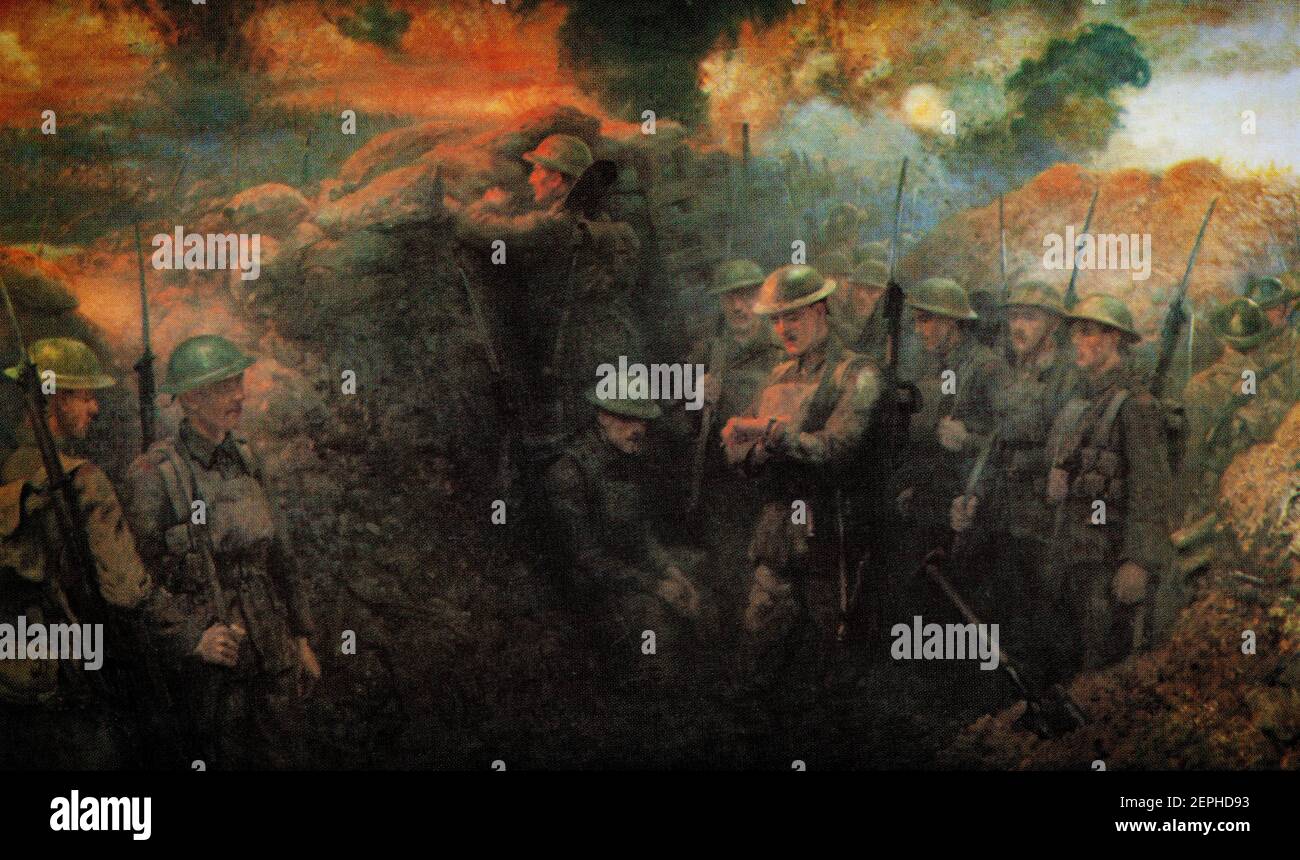 Soldiers prepare to go over the top from the trench during the Battle of the Somme, also known as the Somme Offensive. It was a battle of the First World War fought by the armies of the British Empire and French Third Republic against the German Empire and took place between 1 July and 18 November 1916 on both sides of the upper reaches of the River Somme in France. The battle was intended to hasten a victory for the Allies. More than three million men fought in the battle and one million men were wounded or killed, making it one of the deadliest battles in human history. Stock Photohttps://www.alamy.com/image-license-details/?v=1https://www.alamy.com/soldiers-prepare-to-go-over-the-top-from-the-trench-during-the-battle-of-the-somme-also-known-as-the-somme-offensive-it-was-a-battle-of-the-first-world-war-fought-by-the-armies-of-the-british-empire-and-french-third-republic-against-the-german-empire-and-took-place-between-1-july-and-18-november-1916-on-both-sides-of-the-upper-reaches-of-the-river-somme-in-france-the-battle-was-intended-to-hasten-a-victory-for-the-allies-more-than-three-million-men-fought-in-the-battle-and-one-million-men-were-wounded-or-killed-making-it-one-of-the-deadliest-battles-in-human-history-image409744527.html
Soldiers prepare to go over the top from the trench during the Battle of the Somme, also known as the Somme Offensive. It was a battle of the First World War fought by the armies of the British Empire and French Third Republic against the German Empire and took place between 1 July and 18 November 1916 on both sides of the upper reaches of the River Somme in France. The battle was intended to hasten a victory for the Allies. More than three million men fought in the battle and one million men were wounded or killed, making it one of the deadliest battles in human history. Stock Photohttps://www.alamy.com/image-license-details/?v=1https://www.alamy.com/soldiers-prepare-to-go-over-the-top-from-the-trench-during-the-battle-of-the-somme-also-known-as-the-somme-offensive-it-was-a-battle-of-the-first-world-war-fought-by-the-armies-of-the-british-empire-and-french-third-republic-against-the-german-empire-and-took-place-between-1-july-and-18-november-1916-on-both-sides-of-the-upper-reaches-of-the-river-somme-in-france-the-battle-was-intended-to-hasten-a-victory-for-the-allies-more-than-three-million-men-fought-in-the-battle-and-one-million-men-were-wounded-or-killed-making-it-one-of-the-deadliest-battles-in-human-history-image409744527.htmlRM2EPHD93–Soldiers prepare to go over the top from the trench during the Battle of the Somme, also known as the Somme Offensive. It was a battle of the First World War fought by the armies of the British Empire and French Third Republic against the German Empire and took place between 1 July and 18 November 1916 on both sides of the upper reaches of the River Somme in France. The battle was intended to hasten a victory for the Allies. More than three million men fought in the battle and one million men were wounded or killed, making it one of the deadliest battles in human history.
 French artillery in action in France during the spring of 1918. World war one Stock Photohttps://www.alamy.com/image-license-details/?v=1https://www.alamy.com/stock-photo-french-artillery-in-action-in-france-during-the-spring-of-1918-world-76388611.html
French artillery in action in France during the spring of 1918. World war one Stock Photohttps://www.alamy.com/image-license-details/?v=1https://www.alamy.com/stock-photo-french-artillery-in-action-in-france-during-the-spring-of-1918-world-76388611.htmlRMEC7PCK–French artillery in action in France during the spring of 1918. World war one
 On the British Western Front during Battle of Menin Road. Scottish territorials being examined in a dressing station. Belgium, 1914. Stock Photohttps://www.alamy.com/image-license-details/?v=1https://www.alamy.com/stock-photo-on-the-british-western-front-during-battle-of-menin-road-scottish-132936078.html
On the British Western Front during Battle of Menin Road. Scottish territorials being examined in a dressing station. Belgium, 1914. Stock Photohttps://www.alamy.com/image-license-details/?v=1https://www.alamy.com/stock-photo-on-the-british-western-front-during-battle-of-menin-road-scottish-132936078.htmlRMHM7N92–On the British Western Front during Battle of Menin Road. Scottish territorials being examined in a dressing station. Belgium, 1914.
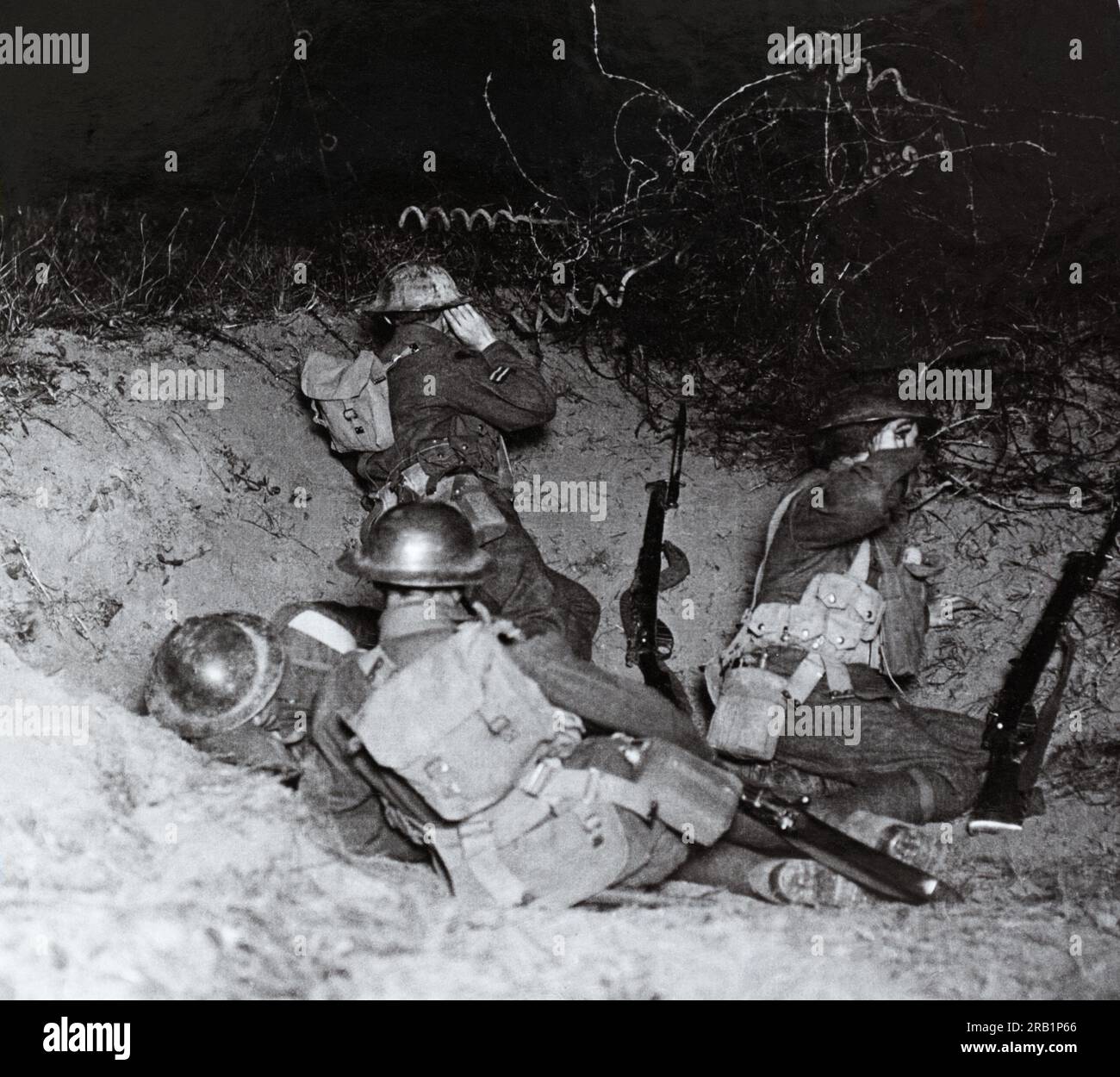 British infantry maning a listening post in no mans land on the Western Front during the First World War. Stock Photohttps://www.alamy.com/image-license-details/?v=1https://www.alamy.com/british-infantry-maning-a-listening-post-in-no-mans-land-on-the-western-front-during-the-first-world-war-image557532366.html
British infantry maning a listening post in no mans land on the Western Front during the First World War. Stock Photohttps://www.alamy.com/image-license-details/?v=1https://www.alamy.com/british-infantry-maning-a-listening-post-in-no-mans-land-on-the-western-front-during-the-first-world-war-image557532366.htmlRM2RB1P66–British infantry maning a listening post in no mans land on the Western Front during the First World War.
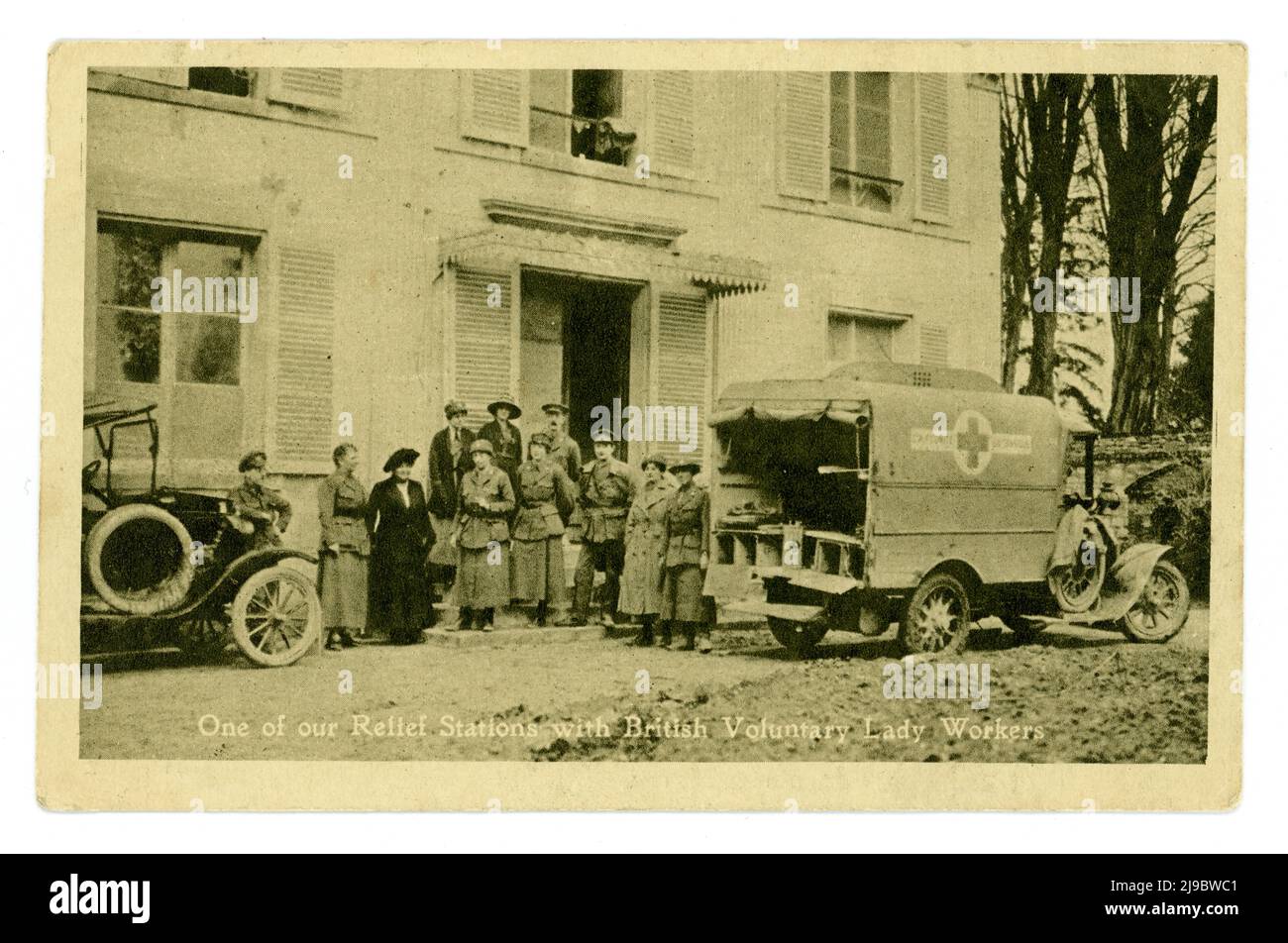 Original WW1 era fund raising postcard of a British Relief Station with British voluntary lady workers, issued by France's Day in aid of the British Committee of the French Red Cross (registered as a charity in 1916), France. Donations were asked to help the 2 million people forced to leave their homes in France during WW1 to help these refugees rebuild their lives as they returned to their homes. Help included furniture, implements, infant food and clothes. circa 1919. Stock Photohttps://www.alamy.com/image-license-details/?v=1https://www.alamy.com/original-ww1-era-fund-raising-postcard-of-a-british-relief-station-with-british-voluntary-lady-workers-issued-by-frances-day-in-aid-of-the-british-committee-of-the-french-red-cross-registered-as-a-charity-in-1916-france-donations-were-asked-to-help-the-2-million-people-forced-to-leave-their-homes-in-france-during-ww1-to-help-these-refugees-rebuild-their-lives-as-they-returned-to-their-homes-help-included-furniture-implements-infant-food-and-clothes-circa-1919-image470473249.html
Original WW1 era fund raising postcard of a British Relief Station with British voluntary lady workers, issued by France's Day in aid of the British Committee of the French Red Cross (registered as a charity in 1916), France. Donations were asked to help the 2 million people forced to leave their homes in France during WW1 to help these refugees rebuild their lives as they returned to their homes. Help included furniture, implements, infant food and clothes. circa 1919. Stock Photohttps://www.alamy.com/image-license-details/?v=1https://www.alamy.com/original-ww1-era-fund-raising-postcard-of-a-british-relief-station-with-british-voluntary-lady-workers-issued-by-frances-day-in-aid-of-the-british-committee-of-the-french-red-cross-registered-as-a-charity-in-1916-france-donations-were-asked-to-help-the-2-million-people-forced-to-leave-their-homes-in-france-during-ww1-to-help-these-refugees-rebuild-their-lives-as-they-returned-to-their-homes-help-included-furniture-implements-infant-food-and-clothes-circa-1919-image470473249.htmlRM2J9BWC1–Original WW1 era fund raising postcard of a British Relief Station with British voluntary lady workers, issued by France's Day in aid of the British Committee of the French Red Cross (registered as a charity in 1916), France. Donations were asked to help the 2 million people forced to leave their homes in France during WW1 to help these refugees rebuild their lives as they returned to their homes. Help included furniture, implements, infant food and clothes. circa 1919.
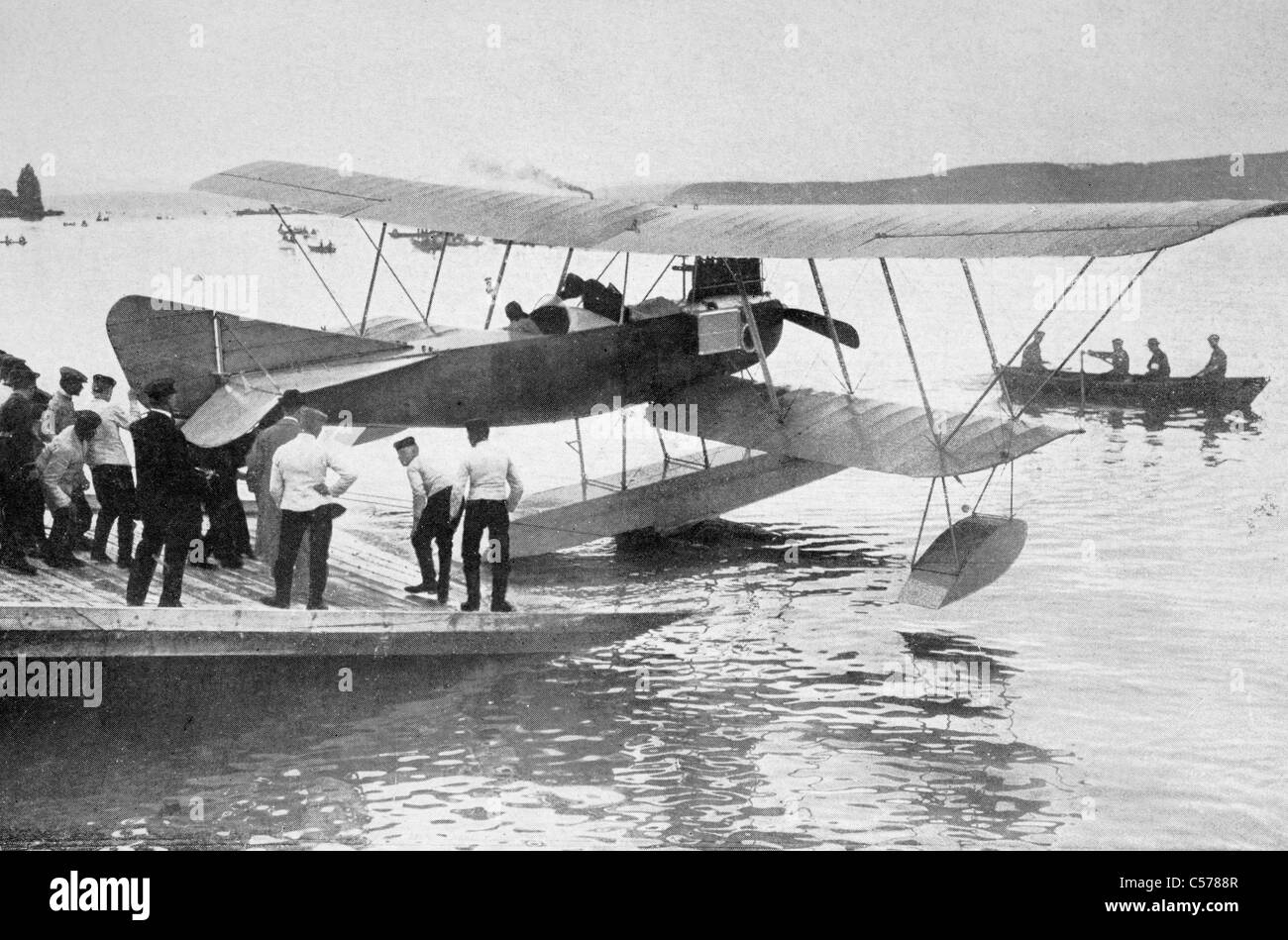 German seaplane used in the North Sea to track English naval movement during the First World War. Stock Photohttps://www.alamy.com/image-license-details/?v=1https://www.alamy.com/stock-photo-german-seaplane-used-in-the-north-sea-to-track-english-naval-movement-37654199.html
German seaplane used in the North Sea to track English naval movement during the First World War. Stock Photohttps://www.alamy.com/image-license-details/?v=1https://www.alamy.com/stock-photo-german-seaplane-used-in-the-north-sea-to-track-english-naval-movement-37654199.htmlRMC5788R–German seaplane used in the North Sea to track English naval movement during the First World War.
 Vintage photo circa 1943 of a flight of Short Stirling Mark 1 bombers of the Royal Air Force of of No. 1651 Heavy Conversion Unit at RAF Waterbeach during world war two Stock Photohttps://www.alamy.com/image-license-details/?v=1https://www.alamy.com/vintage-photo-circa-1943-of-a-flight-of-short-stirling-mark-1-bombers-of-the-royal-air-force-of-of-no-1651-heavy-conversion-unit-at-raf-waterbeach-during-world-war-two-image475442229.html
Vintage photo circa 1943 of a flight of Short Stirling Mark 1 bombers of the Royal Air Force of of No. 1651 Heavy Conversion Unit at RAF Waterbeach during world war two Stock Photohttps://www.alamy.com/image-license-details/?v=1https://www.alamy.com/vintage-photo-circa-1943-of-a-flight-of-short-stirling-mark-1-bombers-of-the-royal-air-force-of-of-no-1651-heavy-conversion-unit-at-raf-waterbeach-during-world-war-two-image475442229.htmlRM2JHE7BH–Vintage photo circa 1943 of a flight of Short Stirling Mark 1 bombers of the Royal Air Force of of No. 1651 Heavy Conversion Unit at RAF Waterbeach during world war two
 WWI Belgian infantrymen in trench shooting with Mauser Model 1889 bolt-action rifle used during World War One in 1914 in Flanders, Belgium Stock Photohttps://www.alamy.com/image-license-details/?v=1https://www.alamy.com/wwi-belgian-infantrymen-in-trench-shooting-with-mauser-model-1889-bolt-action-rifle-used-during-world-war-one-in-1914-in-flanders-belgium-image620517535.html
WWI Belgian infantrymen in trench shooting with Mauser Model 1889 bolt-action rifle used during World War One in 1914 in Flanders, Belgium Stock Photohttps://www.alamy.com/image-license-details/?v=1https://www.alamy.com/wwi-belgian-infantrymen-in-trench-shooting-with-mauser-model-1889-bolt-action-rifle-used-during-world-war-one-in-1914-in-flanders-belgium-image620517535.htmlRM2Y1F0CF–WWI Belgian infantrymen in trench shooting with Mauser Model 1889 bolt-action rifle used during World War One in 1914 in Flanders, Belgium
 Gallipoli during World War 1 / G. Downes Stock Photohttps://www.alamy.com/image-license-details/?v=1https://www.alamy.com/gallipoli-during-world-war-1-g-downes-image68240249.html
Gallipoli during World War 1 / G. Downes Stock Photohttps://www.alamy.com/image-license-details/?v=1https://www.alamy.com/gallipoli-during-world-war-1-g-downes-image68240249.htmlRMDY0H3N–Gallipoli during World War 1 / G. Downes
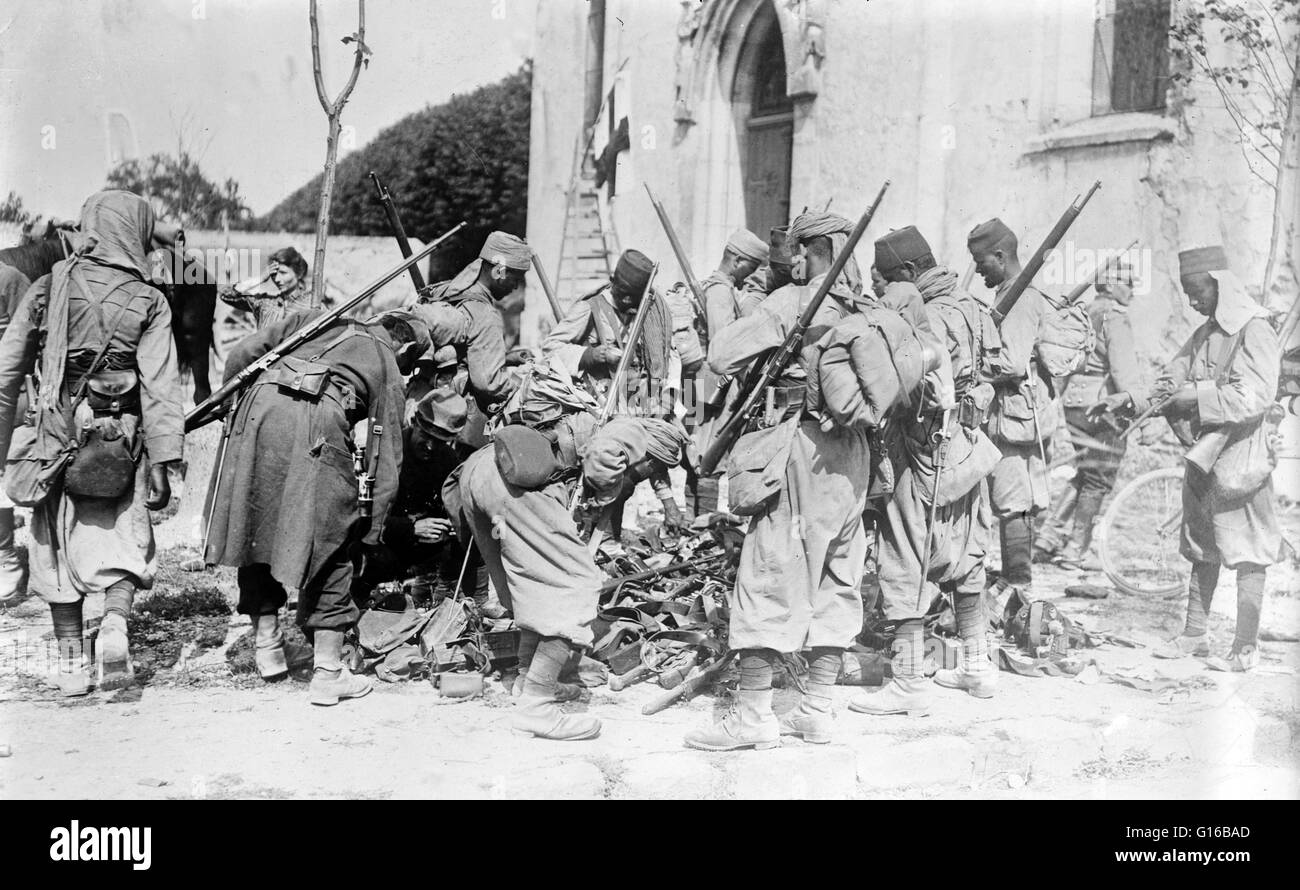 Algerian tirailleurs (infantry soldiers) examining war booty at Chauconin-Neufmontiers, France during WWI. Tirailleur dates back to the Napoleonic period where it was used to designate light infantry trained to skirmish ahead of the main columns. During W Stock Photohttps://www.alamy.com/image-license-details/?v=1https://www.alamy.com/stock-photo-algerian-tirailleurs-infantry-soldiers-examining-war-booty-at-chauconin-104017493.html
Algerian tirailleurs (infantry soldiers) examining war booty at Chauconin-Neufmontiers, France during WWI. Tirailleur dates back to the Napoleonic period where it was used to designate light infantry trained to skirmish ahead of the main columns. During W Stock Photohttps://www.alamy.com/image-license-details/?v=1https://www.alamy.com/stock-photo-algerian-tirailleurs-infantry-soldiers-examining-war-booty-at-chauconin-104017493.htmlRMG16BAD–Algerian tirailleurs (infantry soldiers) examining war booty at Chauconin-Neufmontiers, France during WWI. Tirailleur dates back to the Napoleonic period where it was used to designate light infantry trained to skirmish ahead of the main columns. During W
 World War 1. Open Attack at St. Mihiel. U.S. troops in action during the Battle of St. Mihiel, Sept. 12-16, 1918. Lithograph by Lucien Jonas, 1927. (BSLOC 2013 1 203) Stock Photohttps://www.alamy.com/image-license-details/?v=1https://www.alamy.com/stock-photo-world-war-1-open-attack-at-st-mihiel-us-troops-in-action-during-the-170543863.html
World War 1. Open Attack at St. Mihiel. U.S. troops in action during the Battle of St. Mihiel, Sept. 12-16, 1918. Lithograph by Lucien Jonas, 1927. (BSLOC 2013 1 203) Stock Photohttps://www.alamy.com/image-license-details/?v=1https://www.alamy.com/stock-photo-world-war-1-open-attack-at-st-mihiel-us-troops-in-action-during-the-170543863.htmlRMKWCXC7–World War 1. Open Attack at St. Mihiel. U.S. troops in action during the Battle of St. Mihiel, Sept. 12-16, 1918. Lithograph by Lucien Jonas, 1927. (BSLOC 2013 1 203)
 The entrance to the Great Gully at Helles. From a selection of printed photographs first published in 1916. The Gallipoli Campaign began during the Great War on 19 February 1915 and continued until 9 January 1916. This is sometimes referred to as the Dardanelles Campaign, The Battle of Gallipoli and the Defence of Gallipoli. Stock Photohttps://www.alamy.com/image-license-details/?v=1https://www.alamy.com/the-entrance-to-the-great-gully-at-helles-from-a-selection-of-printed-photographs-first-published-in-1916-the-gallipoli-campaign-began-during-the-great-war-on-19-february-1915-and-continued-until-9-january-1916-this-is-sometimes-referred-to-as-the-dardanelles-campaign-the-battle-of-gallipoli-and-the-defence-of-gallipoli-image626372196.html
The entrance to the Great Gully at Helles. From a selection of printed photographs first published in 1916. The Gallipoli Campaign began during the Great War on 19 February 1915 and continued until 9 January 1916. This is sometimes referred to as the Dardanelles Campaign, The Battle of Gallipoli and the Defence of Gallipoli. Stock Photohttps://www.alamy.com/image-license-details/?v=1https://www.alamy.com/the-entrance-to-the-great-gully-at-helles-from-a-selection-of-printed-photographs-first-published-in-1916-the-gallipoli-campaign-began-during-the-great-war-on-19-february-1915-and-continued-until-9-january-1916-this-is-sometimes-referred-to-as-the-dardanelles-campaign-the-battle-of-gallipoli-and-the-defence-of-gallipoli-image626372196.htmlRM2YB1M3G–The entrance to the Great Gully at Helles. From a selection of printed photographs first published in 1916. The Gallipoli Campaign began during the Great War on 19 February 1915 and continued until 9 January 1916. This is sometimes referred to as the Dardanelles Campaign, The Battle of Gallipoli and the Defence of Gallipoli.
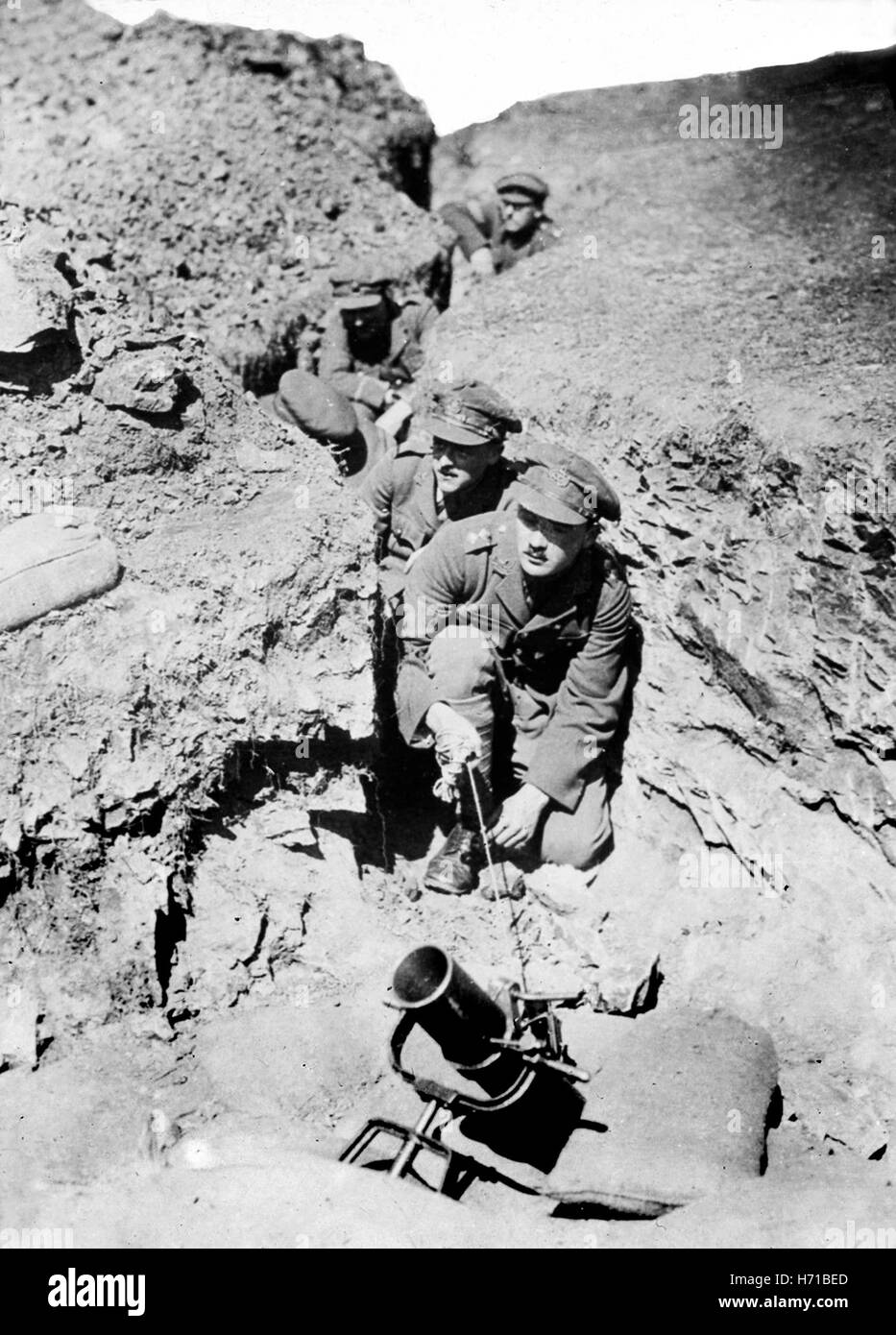 WW1 World War One 1914-18 British artillery firing amunition from Trench Mortar during First World War 1916 Stock Photohttps://www.alamy.com/image-license-details/?v=1https://www.alamy.com/stock-photo-ww1-world-war-one-1914-18-british-artillery-firing-amunition-from-124806149.html
WW1 World War One 1914-18 British artillery firing amunition from Trench Mortar during First World War 1916 Stock Photohttps://www.alamy.com/image-license-details/?v=1https://www.alamy.com/stock-photo-ww1-world-war-one-1914-18-british-artillery-firing-amunition-from-124806149.htmlRMH71BED–WW1 World War One 1914-18 British artillery firing amunition from Trench Mortar during First World War 1916
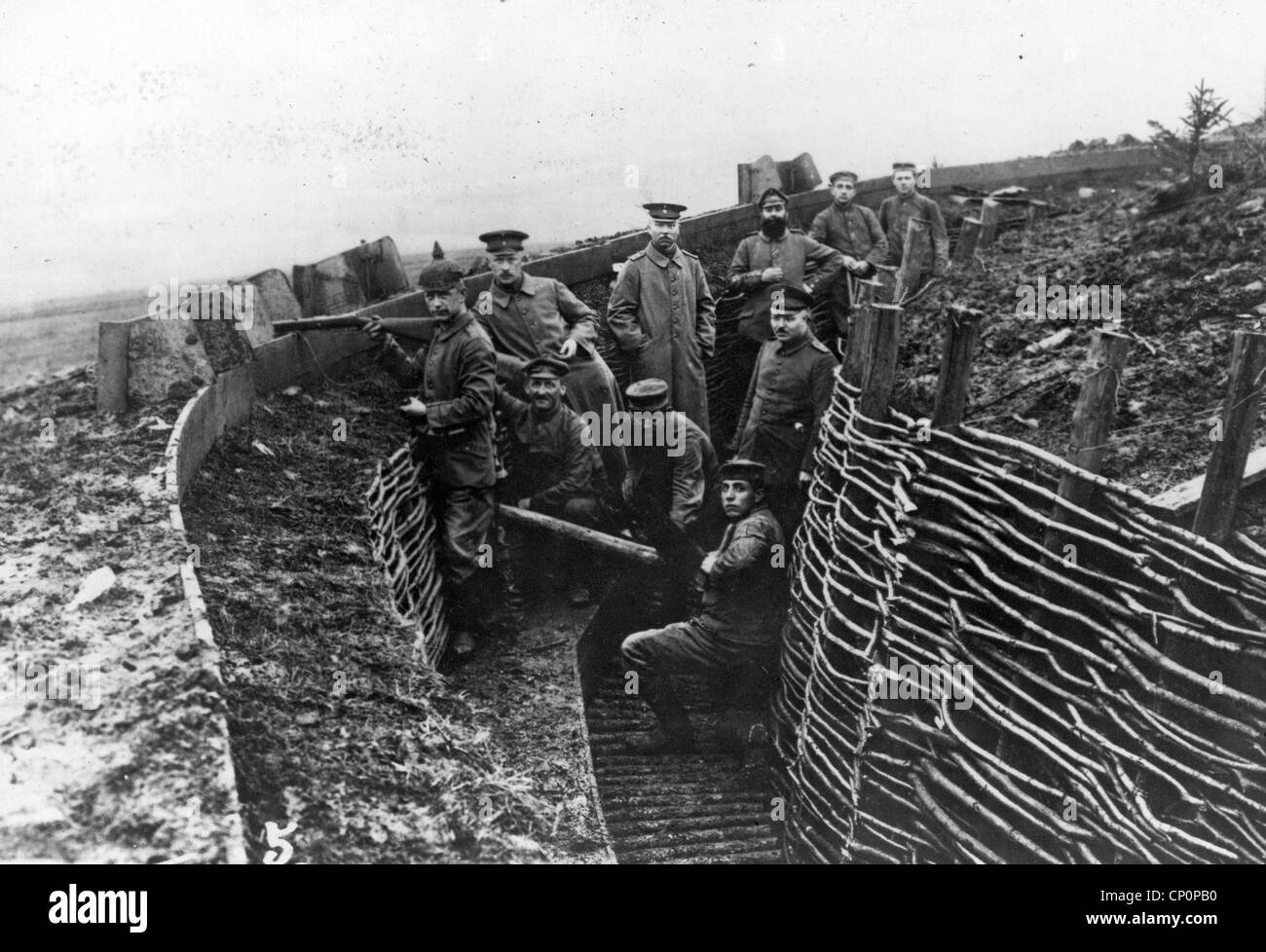 German military soldiers in a trench during World War One Stock Photohttps://www.alamy.com/image-license-details/?v=1https://www.alamy.com/stock-photo-german-military-soldiers-in-a-trench-during-world-war-one-47960724.html
German military soldiers in a trench during World War One Stock Photohttps://www.alamy.com/image-license-details/?v=1https://www.alamy.com/stock-photo-german-military-soldiers-in-a-trench-during-world-war-one-47960724.htmlRMCP0PB0–German military soldiers in a trench during World War One
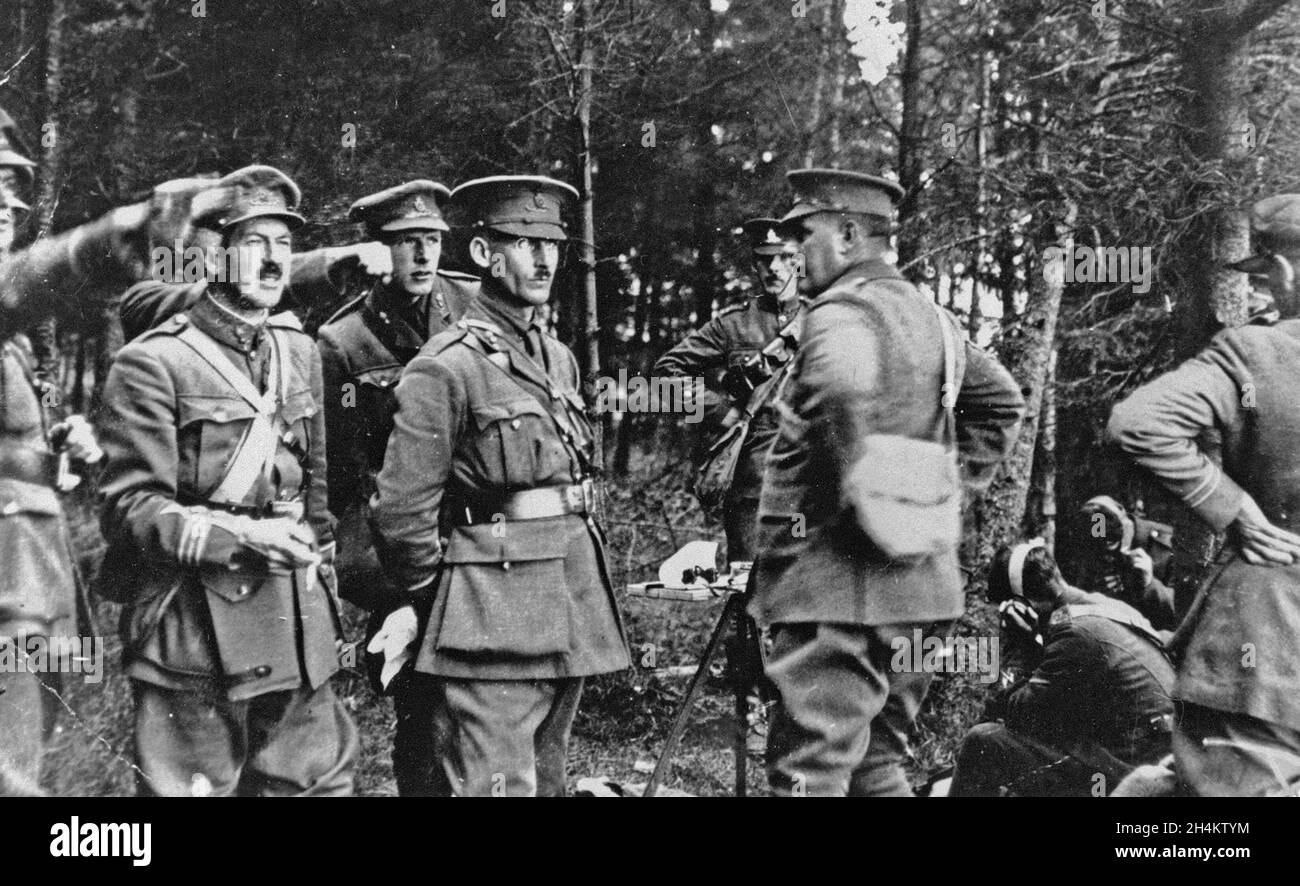 EDZELL MUIR, SCOTLAND, UK - circa 1915 - Royal Artillery officers and men on exercise during World War I on Ezdell Muir ( Ezdell Moor ) in Angus, Scot Stock Photohttps://www.alamy.com/image-license-details/?v=1https://www.alamy.com/edzell-muir-scotland-uk-circa-1915-royal-artillery-officers-and-men-on-exercise-during-world-war-i-on-ezdell-muir-ezdell-moor-in-angus-scot-image450364872.html
EDZELL MUIR, SCOTLAND, UK - circa 1915 - Royal Artillery officers and men on exercise during World War I on Ezdell Muir ( Ezdell Moor ) in Angus, Scot Stock Photohttps://www.alamy.com/image-license-details/?v=1https://www.alamy.com/edzell-muir-scotland-uk-circa-1915-royal-artillery-officers-and-men-on-exercise-during-world-war-i-on-ezdell-muir-ezdell-moor-in-angus-scot-image450364872.htmlRM2H4KTYM–EDZELL MUIR, SCOTLAND, UK - circa 1915 - Royal Artillery officers and men on exercise during World War I on Ezdell Muir ( Ezdell Moor ) in Angus, Scot
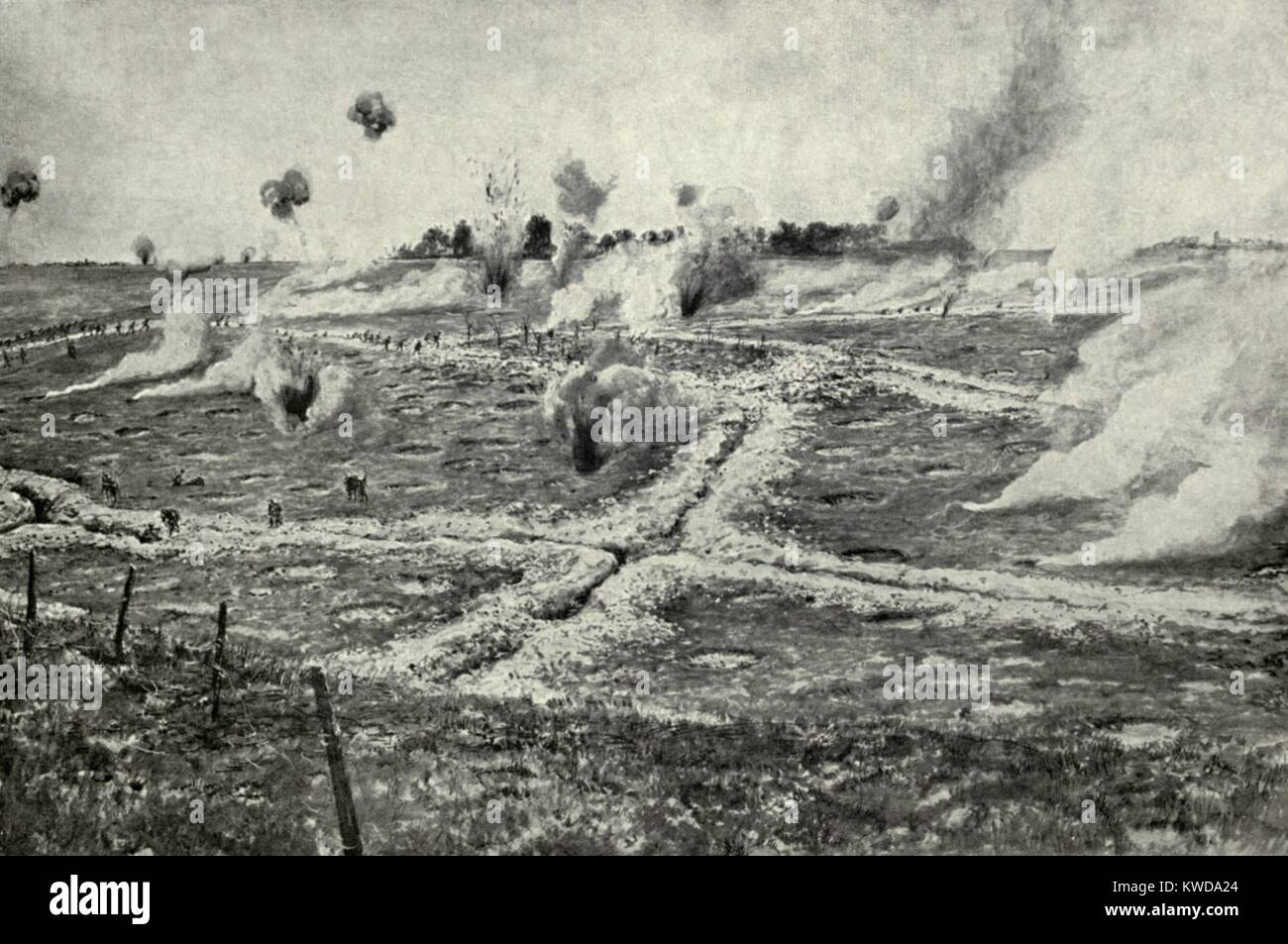 World War 1. Somme Offensive. Falfemont Farm was a German strongpoint captured by the British during the Battle of Guillemont (Sept. 3-6, 1916). British soldiers are advancing from the left along a chalk trench and entering the left-hand corner of the farmyard, while the Germans are retiring on the right. (BSLOC 2013 1 130) Stock Photohttps://www.alamy.com/image-license-details/?v=1https://www.alamy.com/stock-photo-world-war-1-somme-offensive-falfemont-farm-was-a-german-strongpoint-170552988.html
World War 1. Somme Offensive. Falfemont Farm was a German strongpoint captured by the British during the Battle of Guillemont (Sept. 3-6, 1916). British soldiers are advancing from the left along a chalk trench and entering the left-hand corner of the farmyard, while the Germans are retiring on the right. (BSLOC 2013 1 130) Stock Photohttps://www.alamy.com/image-license-details/?v=1https://www.alamy.com/stock-photo-world-war-1-somme-offensive-falfemont-farm-was-a-german-strongpoint-170552988.htmlRMKWDA24–World War 1. Somme Offensive. Falfemont Farm was a German strongpoint captured by the British during the Battle of Guillemont (Sept. 3-6, 1916). British soldiers are advancing from the left along a chalk trench and entering the left-hand corner of the farmyard, while the Germans are retiring on the right. (BSLOC 2013 1 130)
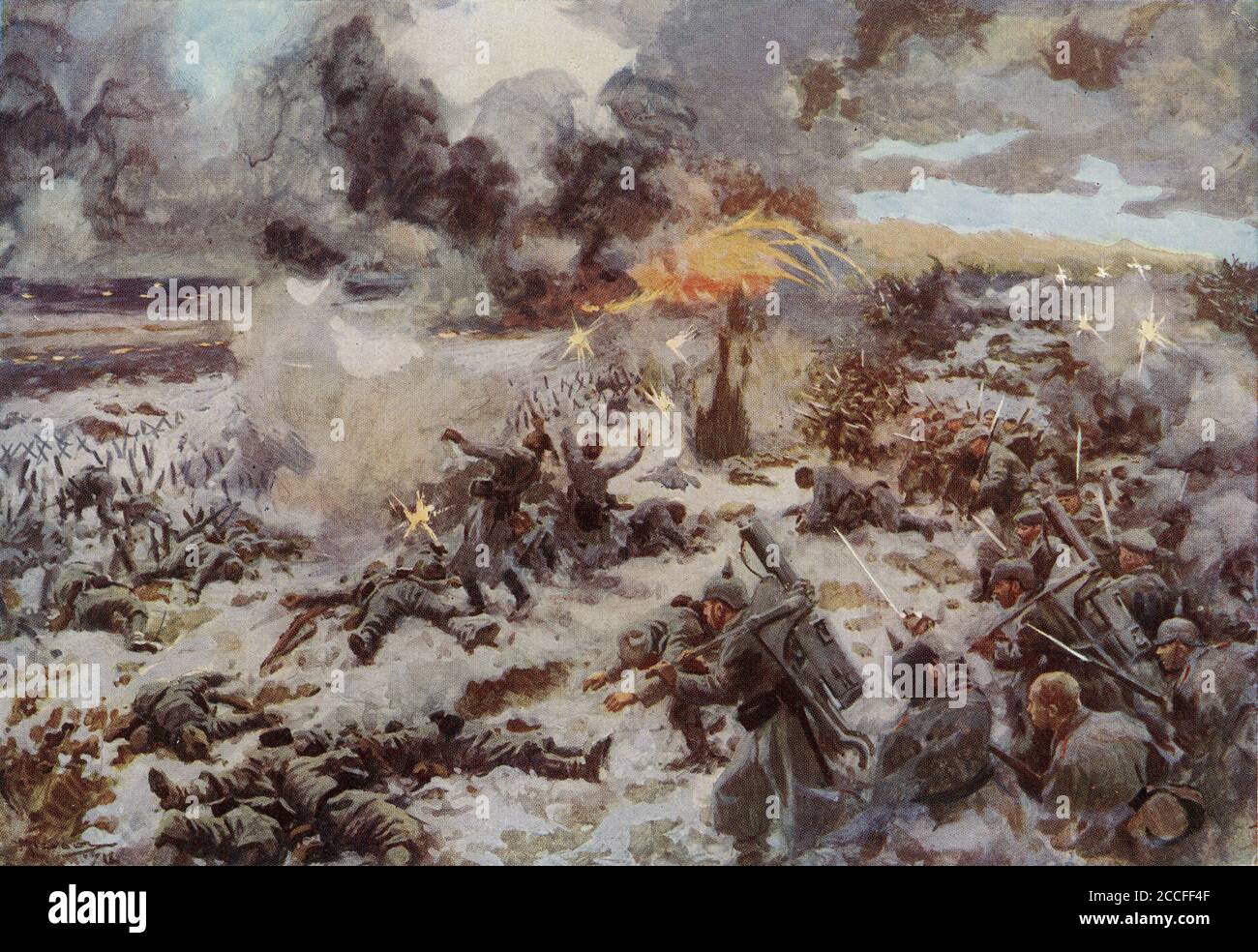 Halftone of French infantry driving back the Germans at Verdun during World War One. From The History of The Great War. Stock Photohttps://www.alamy.com/image-license-details/?v=1https://www.alamy.com/halftone-of-french-infantry-driving-back-the-germans-at-verdun-during-world-war-one-from-the-history-of-the-great-war-image369134767.html
Halftone of French infantry driving back the Germans at Verdun during World War One. From The History of The Great War. Stock Photohttps://www.alamy.com/image-license-details/?v=1https://www.alamy.com/halftone-of-french-infantry-driving-back-the-germans-at-verdun-during-world-war-one-from-the-history-of-the-great-war-image369134767.htmlRM2CCFF4F–Halftone of French infantry driving back the Germans at Verdun during World War One. From The History of The Great War.